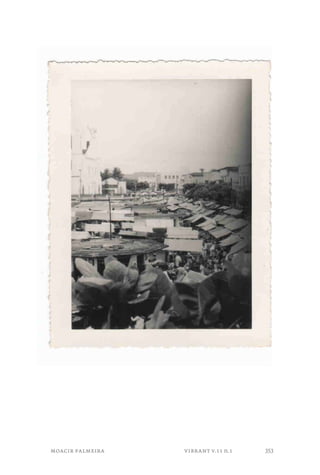This article discusses violence and mobilization in the Maré favelas in Rio de Janeiro. It notes that violence between criminal groups fighting for control of drug trafficking, and interventions by state security forces, create an oppressive climate of fear that intensifies the historic segregation faced by favela residents. In Maré, some of Rio's most powerful drug factions operate and armed conflicts and aggressive policing are common. The article describes how residents and local groups in Maré have mobilized against human rights violations following increased conflicts. It aims to debate violence in Rio and present social struggles in Maré during this period.
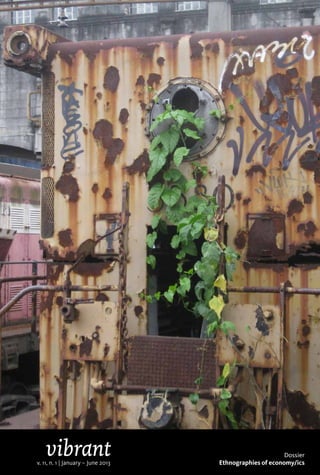

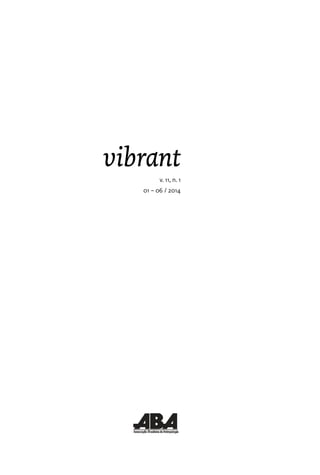
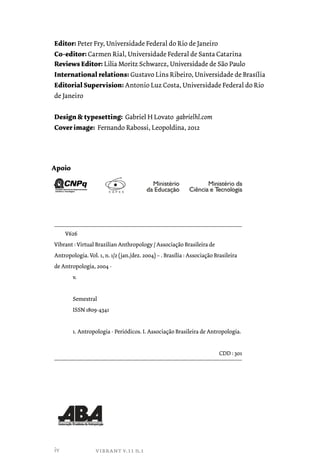



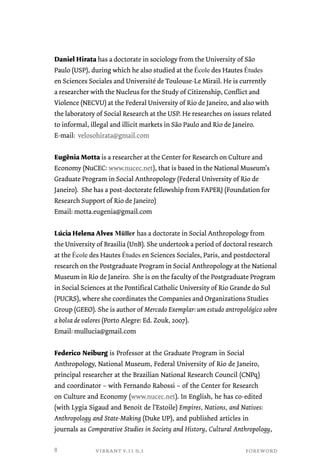






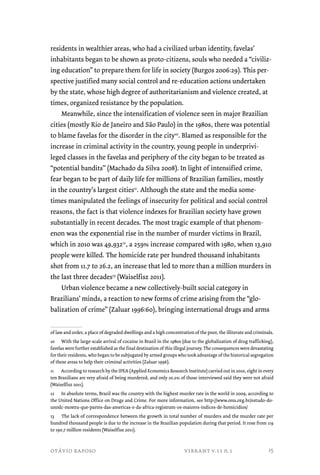
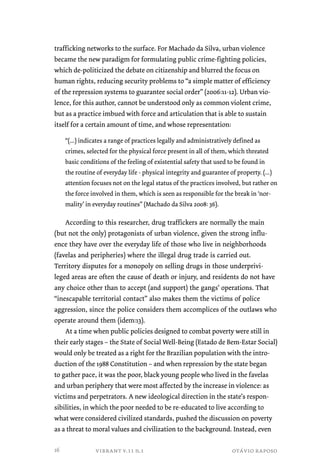


![changed the landscape of the neighborhood. The project not only gave Maré
basic infrastructure (water, electricity, sewage, paving) but also removed its
stilt houses. They were replaced by housing developments that created new
locations: Vila do João, Vila do Pinheiro, Conjunto Pinheiro and Conjunto
Esperança. With the creation of the 30th Administrative Region of Maré in
1988, new locations were added: Conjunto Marcílio Dias, Parque Roquete
Pinto and Praia de Ramos. Later, the state built new housing developments to
house families from areas that were considered at risk, and made use of the
ample free space and excellent accessibility: Conjunto Bento Ribeiro Dantas
(1992), Nova Maré (1996) and Novo Pinheiro (2000).
Maré is not only divided into different favelas, which have rather original
occupation histories, but also into areas of influence by the different drug
trafficking factions. One need only go into Maré to notice the presence of
armed groups, always alert to the arrival of the police or the presence of
enemy gangs “in their territory” and feel the atmosphere of conflict to which
its inhabitants are subjected20. But the conflicts cannot be attributed exclu-sively
to criminal gangs, as the police is also an important actor in promot-ing
violence and the feeling of insecurity that results from it. In the opinion
of many residents, the police enters into onslaughts without any planning,
triggering shootings that often kill residents who have nothing to do with
trafficking. The Vice-Chair of one of Maré’s Residents’ Associations confided
to me in an interview that the police was the main cause of the lack of secu-rity
in the neighborhood:
The ones encouraging insecurity are the public power, because there are only
problems here when the police invades, especially with the Caveirão21. That’s when
you have a problem. You’re in the street and suddenly the Caveirão appears and shots
are exchanged. That’s the thing. Every now and then there are problems between [tra-fficking]
factions, but it’s rare, it’s occasional. But the Caveirão can come in at any
20 This situation changed in March 2014, when Maré began to be occupied by the military police and by troops
from the army and navy, with a view to installing Pacifying Police Units (Unidades de Polícia Pacificadora - UPP), a
mode of community policing specifically directed toward favelas. Nonetheless, the influence of criminal factions
over the different parts of Maré remains, although drug trafficking and the presence of armed young people are
not as visible as before.
21 The “Caveirão” (literally “big skull”) is an armored vehicle used by the Special Operations Battalion of the
Military Police (Batalhão de Operações Especiais - BOPE). It is used to aid police incursions to fight drug trafficking
in Rio de Janeiro’s favelas. It was given its name by the favela population in reference to the BOPE symbol, which
is formed of a skull passed through by a dagger and two golden guns.
otávio raposo vibrant v.11 n.1
19](https://image.slidesharecdn.com/v11n1-140831205434-phpapp02/85/Vibrant-Ethnographies-of-economy-ics-19-320.jpg)
![time, and there could be gunfire, and there are times when it happens really often.
(…) What does the Caveirão do in terms of providing safety? The Caveirão comes in,
acts, fires, and that’s when there’s retaliation. The Caveirão doesn’t carry out specific
actions, there’s no planning: “I’m going there to do this”. They don’t have that role,
they don’t have that planning. The Caveirão is just a form of repression.
[Interview, January 12, 2010]
This view was debated at the “First Free Conference on Public Security
in Maré”, organized by the NGO Redes 22 and 21 other local and supra-local
institutions in June 2009. When arriving at Nova Holanda to take part in
the conference, I saw several police officers armed with rifles and machine
guns, most of whom were waiting in front of the Maré Arts Center (where
the conference was taking place), where three military police vehicles were
also parked. To my surprise, I saw the Caveirão further ahead (in the direc-tion
leading into the neighborhood). All of those people and equipment
were there, in fact, to ensure the security of the event, more specifically the
police officers invited to take part. However, this large security operation
had the opposite effect: a few minutes after I arrived, there was intense
gunfire between police forces and local traffickers, jeopardizing the safety
of all the participants.
Around 200 people were at the conference, most of whom were residents
of the neighborhood, along with several representatives from civil society
institutions and researchers in the area of human rights. The conference
focused on problems arising from police violence, and the presentations
pointed to the importance of valuing life in public security policy. The
message on one of the participant’s t-shirt – “Cabral, enough extermina-tion!”
– is an example of the demands, referring to the Governor of the State
of Rio de Janeiro, Sérgio Cabral Filho. His governance was marked by heavy
investment in the Pacifying Police Units (UPP), presented as a new method
of community policing directed toward the favelas, as a counterpoint to the
occasional, violent operations in those areas23. In fact, there was a reduction
22 Redes (Redes de Desenvolvimento da Maré - Maré Development Networks) is an important NGO in the
neighborhood. Its activities and projects are directed towards the areas of education, culture, local development,
social mobilization, etc. The success of the preparatory courses for universities and important secondary
education schools organized by Redes is notable. The courses have been responsible for many young people in
the neighborhood starting higher education (an average of 80 students per year). For more information, visit the
Redes websites: http://redesdamare.org.br/.
23 According to the Government of the State of Rio de Janeiro, there are currently 38 UPPs in operation,
vibrant v.11 n.1 otávio raposo
20](https://image.slidesharecdn.com/v11n1-140831205434-phpapp02/85/Vibrant-Ethnographies-of-economy-ics-20-320.jpg)
![in the number of murders in favelas occupied by UPP, whose areas stopped
seeing such an obvious presence of armed traffickers24. But the UPPs were
not the only public security policy under Sérgio Cabral’s management.
Before them, in the first years of his mandate, there was in increase in the
number of deaths caused by the police in favelas, whose aggressive attitude
was encouraged by his government, leading to harsh criticism in public
opinion and from Brazilian and international human rights defense bodies25
(Machado da Silva 2010).
The different discussion sessions were dominated by speeches and
witness statements that revealed police brutality. They were not reports
about strangers, but first-person narratives involving children, nieces and
nephews, brothers and sisters or neighbors. Most of the participants had
relatives (or people close to them) who had been murdered by the police or
drug trafficking gangs. At the conference, it became clear that the violence
in Maré was everyday, not exceptional, and crossed different aspects of resi-dents’
lives. I reproduce some of the statements made by those present:
- You can’t treat violence one way in Leblon [a wealthy neighborhood] and another
in Maré.
- What about the people who killed Matheus? And the people who killed Felipe26?
Were the police officers arrested?
- Patrícia, who lives in Barra da Tijuca [a wealthy neighborhood], saw the police
officers arrested. What about the police officers who killed Matheus? He was a black
kid from a favela, so he doesn’t count.
- The people in charge of public security should respect residents. We are really
covering 257 locations. For more information, see: http://www.upprj.com/index.php//historico
24 Although there has been a significant decrease in the number of murders in favelas where UPPs were
installed, the problem of violence (by the police and criminals) has not been resolved. The areas continue to be
treated by the police as exceptions, where the citizens’ rights of residents are not respected. The most perverse
face of this is police brutality. The case of Amarildo, who was tortured and murdered by police in the Rocinha
favela in 2013, is an example of the mistakes in a policy that, by continuing to follow a rationale of repressive and
authoritarian social control, does not take into account the rights of favela residents.
25 A declaration that shows the public security policy adopted in the first years of Sérgio Cabral’s government
was given by José Mariano Beltrame, Secretary for Security in the State of Rio de Janeiro. He justified the
police super-operation in the Alemão favelas in 2007 that led to 19 deaths and 13 wounded as follows: “The
remedy to bring peace often involves actions that bring blood”. The declaration can be read here: http://extra.
globo.com/noticias/rio/para-policia-operacao-no-alemao-vai-enfraquecer-trafico-em-outras-favelas-680548.
html#ixzz30y5gJP9l
26 Matheus (8) and Felipe (17) were killed in 2008 and 2009 respectively during police operations. Witnesses
and families of the victims accused the police of carrying out an execution.
otávio raposo vibrant v.11 n.1
21](https://image.slidesharecdn.com/v11n1-140831205434-phpapp02/85/Vibrant-Ethnographies-of-economy-ics-21-320.jpg)
![discriminated against because we live in Maré.
- When I was studying at university I was embarrassed to say that I lived in Maré. I
said that I lived in Bonsucesso [a neighboring area].
- People say that we’re afraid to denounce police abuse, but when we go after [justice],
we’re threatened.
- Maré is just a neighborhood like any other. This isn’t a prison, and we’re free, not
prisoners.
[Field Diary, June 28, 2009]
The phenomena of violence, stigma and urban segregation were debated
at the conference and the Maré residents, who were the main protagonists,
highlighted the self-organization and mobilization of some of the neigh-borhood
to reject the dominant public security model. The reports of Maré
residents at the conference cannot be disregarded in Rio de Janeiro’s context
of social and spatial segregation, where favelas are presented as areas “con-taminated”
by ecological and moral degradation, a “geography of chaos” that
would spread delinquency throughout legitimate areas of the city (Ferrándiz
2002:6). These assumptions condition the way that violence is fought by the
police forces and how it is experienced by the residents of Rio de Janeiro,
which makes the name “broken city27” or the “asphalt-favela28” polarization
very common in media discourse and common sense. Both names offer an
uncomplicated interpretation of Rio’s segregation, in which the possibility
for combinations, ambiguity and cultural exchanges between individuals
from different hierarchies in the city are almost non-existent. On the one
hand, these two artificial terms ignore the deep transformations seen in
many of Rio de Janeiro’s favelas (urbanization, development of rich local
commerce, emergence of a lower middle class), perpetuating an anachronis-tic,
prejudiced idea. The existence of small and medium-sized traders in the
favelas, and even individuals who become the owners of several pieces of real
estate, many of whom used the verticalization29 of their houses to make a
good business, negates the theories that apply poverty to all favela residents.
27 The title of a book by Zuenir Ventura (1994) that tells of the author’s experience in Vigário Geral, Rio de
Janeiro, immediately following the massacre in which 21 people were killed by an extermination group formed
of police officers in August 1993.
28 The “asphalt-favela” distinction is often used to distinguish between two extremes of Brazilian cities:
the wealthy asphalt and the poor favela.
29 A term often used in the favela context to describe vertical extensions to buildings.
vibrant v.11 n.1 otávio raposo
22](https://image.slidesharecdn.com/v11n1-140831205434-phpapp02/85/Vibrant-Ethnographies-of-economy-ics-22-320.jpg)
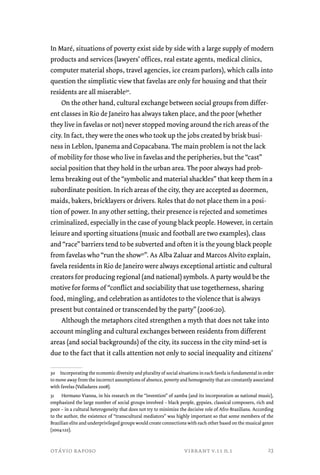

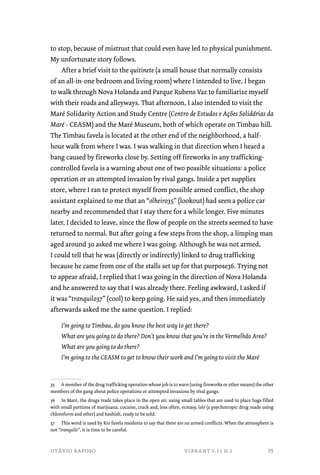
![Museum where there’s an exhibition about the history of the neighborhood and...
You’re crazy to say you’re going there, man! Here it’s Vermelhão and there it’s Terceiro.
Where are you from?
I’m from Niterói [a town next to Rio de Janeiro].
You’re crazy, saying you’re going there! I’ll take you there.
It’s cool, I’ll get there. It’s better to go down Avenida Brasil, right? Is it “sujeira”
[dangerous] to go along Rua Principal to Baixa do Sapateiro?
[Field Diary, September 4, 2009]
The man agreed with me and confirmed that going along Avenida Brasil
was better, because it could be dangerous to go through the border areas. A
young man approached us to disagree, saying that it was fine to go through
the middle. I said goodbye to them quickly and said that I was going towards
Avenida Brasil. Before I left, the limping man warned me:
Never say you’re going to Timbau or they’ll take it the wrong way.
You’re right, buddy. I messed up.
[Field Diary, September 4, 2009]
I continued heading in the direction of Avenida Brasil, annoyed about
my lack of awareness. After all, as a Rio native, I should have known to avoid
mentioning rival territories and groups in favelas with drug trafficking, or I
could be misunderstood and cause unpredictable consequences.
Physical attacks or even murders of people suspected of being police
investigators or spies from rival gangs are not uncommon events around here,
part of a context of bloody confrontations for a monopoly on drugs sales and
state repression. This situation requires researchers to take special care when
calculating their comings and goings in the field, trying to anticipate possibly
unforeseen events. Being able to locate border areas between disputing gangs
and realizing when there are police operations form valuable knowledge that
reduces researchers’ exposure to danger. “Knowing how to go in and how to get
out” are essential methodological procedures in areas dominated by crime, as
Alba Zaluar explains so well (2009:566). An understanding of the hierarchies and
rivalries that make up the “tortuous” rules set by drug trafficking is also impor-tant,
so as not to disturb or raise unnecessary suspicions from local traffickers.
When I began the fieldwork, there were three drug trafficking factions
dominating different areas of Maré, as well as the presence of a militia (a para-military
group composed of police officers, firefighters and soldiers who also
vibrant v.11 n.1 otávio raposo
26](https://image.slidesharecdn.com/v11n1-140831205434-phpapp02/85/Vibrant-Ethnographies-of-economy-ics-26-320.jpg)





![poor/favela resident = outlaw. Finally, my link to a group of recognized and
easily identifiable young people – the colorful, loud costumes of the b-boys
and b-girls (breakdancers) contrasted with the Maré residents’ traditional
Bermuda shorts, flip-flops and t-shirt – helped me to become associated with
“the hip hop crowd”, as it was known by trafficking people. They did not
need to approach me, therefore, to find out who I was or what I was doing in
the neighborhood. The answers could be found in my face, my clothes and
those I was with47.
4. “Another Maré is possible”. Organizing action for peace
I’ve never been to Baghdad, I’ve never been to Bosnia, I’ve never been to Afghanistan,
but I imagine that it’s the same there. They really are acts of war: screaming, a
grenade exploding, rifle shots, people shouting, saying that I-don’t-know-who has
died, screaming that they’re going to kill the other one. In my street, near my house,
a friend (neighbor) had his house shot at. It really feels like war, but it doesn’t turn
into a war itself.
[Jorge, 34. Interview, November 26, 2009]
For around five months in 2009 there were intense conflicts in Maré
between two drug trafficking factions, which led to the deaths of more than
40 people (many of whom were not involved in crime in any way), according
to information from the neighborhood’s NGOs. They were difficult times,
mostly for the residents of Vila do Pinheiro, Conjunto Pinheiro, Vila do João,
Salsa e Merengue and Conjunto Esperança, trapped by armed confrontation
between the ADA and TCP gangs, rivals in a territorial dispute. Although
violence was not new to Maré, it intensified from the end of May 2009, when
TCP traffickers increased their hold over Vila do Pinheiro and Conjunto
Pinheiro. Practically overnight, these favelas woke up under a new yoke.
Members of ADA, forced out of those areas after intense exchanges of fire,
focused on the other territories that they controlled, in an attempt to secure
what they still had and recover what they had lost48. For many of the neigh-borhood’s
residents, the police’s action in that incident was not neutral and
47 Later, I found out that local traffickers had asked some young people in the neighborhood questions about me.
48 At the time when I started the fieldwork (June 2009), these confrontations had already begun. The
distribution of armed groups in Maré at the time can be seen in Figure 2.
vibrant v.11 n.1 otávio raposo
32](https://image.slidesharecdn.com/v11n1-140831205434-phpapp02/85/Vibrant-Ethnographies-of-economy-ics-32-320.jpg)
![did not confront both parties involved. They denounced the police for sup-porting
one of the gangs (TCP). The police, aided by the Caveirão, altered the
balance of power and triggered the terrible armed conflicts that followed49.
This would be the start of one of the bloodiest periods in Maré’s history.
My entry into the neighborhood was marked by that climate of fear and
tension. In the first few weeks of fieldwork, I did not dare to visit the loca-tions
being disputed, since they were scenes of intense gunfire and arbitrary
behavior. I got news about the evolution of this “war” through Jorge, a geog-rapher
and researcher at the Favela Observatory and Vila do João resident. In
fact, it was he who warned me about the inaccuracy of using the word “war”
to describe the violent atmosphere at the time:
It isn’t a war. The way I see it, war involves two enemies without any kind of dialog.
If you have participation by police, if you have participation by public actors, if you
have corruption then there is no war. What you really have are confrontations between
armed groups for control over the territory. (…) Otherwise the guys will start thinking
that this is a war, and civilian losses become acceptable: collateral damage. That’s
when you’ll see the secretary [from the Secretariat of State for Security] saying,
when confronted with the death of five residents: “No, but it’s collateral damage,
they’re civilian losses, this is a war”. It ends up justifying the militarization of favelas.
[Jorge, 34. Interview, November 26, 2009]
In fact, José Mariano Beltrame, Secretary for Public Security of the
State of Rio de Janeiro said, in 2007, to justify the many deaths resulting
from police operations in the favelas: “This is a war, and in a war people are
wounded and killed50”. Using the justification that some areas of the city
were in civil war, the deaths of innocent people began to go unpunished, and
police excesses understood as inevitable in the struggle against crime. At
the same time, exterminating members of trafficking gangs, mostly young
people and teenagers, is legitimized by an unprecedented criminalization of
poverty. These ideas are consistent with the ideology, widely spread by the
media and political authorities, that a “good outlaw is a dead outlaw”, a view
tolerated by many segments of civil society51.
49 This version of events can be read in several newspapers and blogs. One example is this story: http://extra.
globo.com/casos-de-policia/caveirao-servico-do-trafico-na-mare-297199.html
50 Interview available at: http://veja.abril.com.br/311007/entrevista.shtml
51 It is not uncommon for Members of Parliament and other Brazilian politicians to use this type of rhetoric,
otávio raposo vibrant v.11 n.1
33](https://image.slidesharecdn.com/v11n1-140831205434-phpapp02/85/Vibrant-Ethnographies-of-economy-ics-33-320.jpg)

![We’re scared! What residents are going to go to the demonstration if we talk about
traffickers?! The residents will think: “Am I going to badmouth them? No way am I
going to the demonstration”.
[Field Diary, September 4, 2009]
This was a controversial topic, and several people wanted to take part,
talking at the same time. One of the main neighborhood leaders, the director
of an important local NGO, spoke and began to direct the discussion:
We are meeting here not because of this particular conflict, which has gone beyond
all acceptable limits. We are meeting because we want to build a movement that can
discuss another kind of public security here for Maré. We don’t want police occupation,
like the ones in the Alemão favelas that didn’t bring any safety for the residents, only
fear and abuse.
[Field Diary, September 4, 2009]
Everyone accepted that the text on the leaflet should not make any
mention of trafficking, with the aim of ensuring that residents participated
and were safe at the event. But there would be some mention of abusive,
violent police intervention. Another important point at the meeting was
related to a sensitive subject: how would they mediate the event between
police and local trafficking gangs? With the first institution, it was simpler,
and it was decided that two representatives from the movement and an
official letter would be sent to the Military Police Battalion that operated in
Maré to inform them about the demonstration. The organizers feared that
the police would come to the event, and it would cause gunfire and for the
action to be shut down. The ill-fated actions of the police at the Conference
on Public Security in Maré were also discussed, when the presence of the
Caveirão triggered armed confrontation with local traffickers. The partici-pants
agreed that the trafficking gangs needed to be told about the event
indirectly using leaflets that would be distributed, since many said that they
did not recognize it as “representative of anything at all”. According to the
program established, the demonstration would begin with a religious cele-bration
at 8 a.m., followed by speeches by local representatives. The proposal
for cultural groups to perform was welcomed, and the following collectives
were chosen: the Vila Olímpica da Maré dance group, the Maré breakdance
group, the carnival group “Se benze que dá” and APAFunk. To end the dem-onstration,
it was suggested that a minute’s silence be held to honor those
otávio raposo vibrant v.11 n.1
35](https://image.slidesharecdn.com/v11n1-140831205434-phpapp02/85/Vibrant-Ethnographies-of-economy-ics-35-320.jpg)
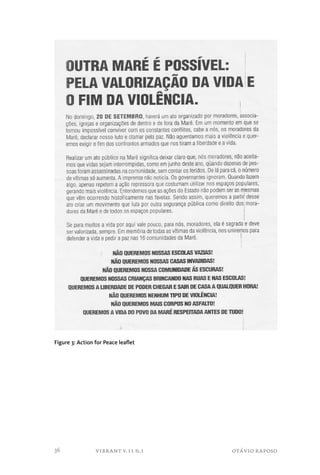

![Pior que isso aqui Worse than this here
Que a gente tá vivendo That we are living
É saber que o poder Is knowing that power
Pode poder May, might
Trocar de mão Change direction
Fingir que até ficou de mal Pretend that it’s against us
Sabe porquê? Do you know why?
Aqui tudo é bom, aqui tudo é bom Everything’s good here, everything’s good here
Aqui tudo é bom, aqui tudo é bom Everything’s good here, everything’s good here
Aqui tudo é bom, aqui tudo é bom Everything’s good here, everything’s good here
Toca bola e samba que eles baixam o som Play football and samba and they’ll turn down the
sound
[Song, O Iraque é aqui. Jorge Aragão]
We left the meeting to hang up one of the banners that announced the
demonstration at the border between Vila do João and Vila do Pinheiro. As
there were no signs that there could be gunfire at that time, we crossed a
small bridge over the sewage channel that divided the two places. We were
at the “heart” of the conflict, and while we were hanging up the banner,
one of the young people exclaimed: “It’s been months since I last set foot
on this side”.
Afterwards, I had lunch at a nearby restaurant with one of the representa-tives
of Ação Comunitária (Gabriel), and I took the opportunity to visit the
NGO’s facilities, which operated in Vila do João. That afternoon, I walked to
Nova Holanda inside the neighborhood, and not via Avenida Brasil (outside)
as I had done the last time. I was accompanied by Gabriel, who knew the best
ways to avoid possible armed confrontations. We were still in Vila do João
when we came across a Caveirão parked on one of the streets, with police
talking next to the armored vehicle. Children were playing in the neighboring
streets, which seemed to suggest that there was no imminent danger of con-flict.
We passed by the Caveirão and, in Conjunto Pinheiro, Gabriel showed
me the path for pedestrians, which crossed the Linha Amarela (one of the
city’s important expressways), that made the connection to the other part of
the neighborhood, and I continued my journey alone. From the heights of
the footpath I could see the vastness of Maré, with Timbau hill and Conjunto
Bento Ribeiro Dantas, better known as “Fogo Cruzado” (Crossfire), in front of
me. It is formed of post-modernist inspired houses: its walls are brick and
vibrant v.11 n.1 otávio raposo
38](https://image.slidesharecdn.com/v11n1-140831205434-phpapp02/85/Vibrant-Ethnographies-of-economy-ics-38-320.jpg)
![exposed concrete and the roofs sloped54. This place had been in the firing
line of battles between criminal factions for a long time. So the name “Fogo
Cruzado” is more than a metaphor. Nonetheless, since the recent expansion of
TCP, residents in the area were experiencing times of relative calm.
5. “I want to be happy. I want to walk peacefully around the
favela where I was born.” Demonstration for Peace
I arrived at Vila do João at around 8.30 a.m. to take part in the action for peace.
I found some participants from the preparation meetings distributing leaflets
close to the bus stops. They were apprehensive about the demonstration, because
the night before there had been a “hell of gunfire between two rival gangs”. I
went with one of them towards the inside of the neighborhood, when I noticed
a crowd of around 400 people gathered next to the Catholic church São José
Operário, located between Vila do João and Vila do Pinheiro, i.e., on the border
between ADA and TCP domains. The walls of the church were riddled with bullet
marks, something that was stopping worshippers from going to mass.
“I canceled the evening masses. Others, which used to bring 400 to 500 people,
now barely bring 100. The church is covered in bullet holes. This is a never-ending,
constant war that, as unbelievable as it sounds, sometimes reaches its peak on
Saturday mornings.”
[Father João Carlos, September 20, 2009]55
Most people who had gathered for the demonstration had just come out
of mass (the best attended in recent months, as Roberto, a researcher from
the Favela Observatory, told me) after the priest João Carlos had strongly
encouraged the congregation to participate in the action. I asked Roberto
about the residents’ apprehension. He was harsh in his response:
People may say that they’re afraid of getting shot, but when it’s time to go to a funk
dance, nobody’s afraid. [Adalberto. Field Diary, September 20, 2009]
54 Built in 1992 by the public power, Conjunto Bento Ribeiro Dantas (“Fogo Cruzado”) received residents from
other favelas that were considered to be at risk from floods, landslides, etc. Its unusual architecture, specifically
the sloping roofs, was planned with a view to discouraging residents from changing the original plan and
avoiding verticalization (Jacques 2002:47). But this did not stop some residents making modifications to the
buildings, including vertical expansion.
55 Interview taken from the websites: http://www.chicoalencar.com.br/chico2004/chamadas/pronuncs/pronunc
20090924b.htm
otávio raposo vibrant v.11 n.1
39](https://image.slidesharecdn.com/v11n1-140831205434-phpapp02/85/Vibrant-Ethnographies-of-economy-ics-39-320.jpg)
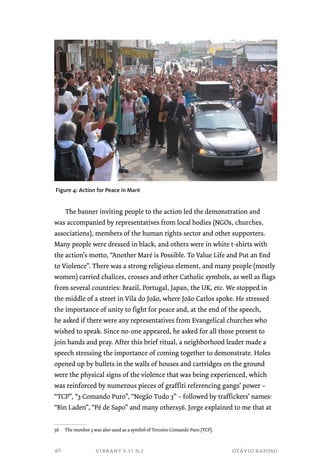
![that time Vila do João was a neutral area. ADA had been weakened and only
controlled Conjunto Esperança.
We continued in the direction of Vila do João, and the sound car began
to play the song O Iraque é aqui, accompanied by a recording calling people
to the protest. Leaflets were distributed by the demonstrators, slogans were
chanted and songs were sung, ranging from Catholic songs (in which the
name of the “Lord” was mentioned repeatedly) to Rio de Janeiro funk. One
of the demonstrators’ favorite songs was the funk song Rap da Felicidade
“Happiness Rap”:
Eu só quero é ser feliz, I just want to be happy
Andar tranquilamente na favela onde eu
nasci.
And walk in peace in the favela where I was
born.
E poder me orgulhar, And be proud,
E ter a consciência que o pobre tem seu
lugar. And know that poor people have a place.
Minha cara autoridade, eu já não sei o que
Dear authority, I don’t know what to do
fazer,
anymore,
Com tanta violência eu sinto medo de
viver. With so much violence I’m afraid to live.
Pois moro na favela e sou muito
desrespeitado, Because I live in the favela and I’m disrespected,
A tristeza e alegria aqui caminham lado a
lado. Sadness and joy walk side by side,
Eu faço uma oração para uma santa
protetora, I pray to a saint,
Mas sou interrompido a tiros de
metralhadora. But I’m interrupted by machine gun fire.
Enquanto os ricos moram numa casa
grande e bela, While the rich live in a big, beautiful house,
O pobre é humilhado, esculachado na
favela. The poor are humiliated, abused in the favela.
Já não aguento mais essa onda de violência,I can’t take this wave of violence anymore,
Só peço a autoridade um pouco mais de
competência (...).
I just ask for a little more ability from authority
(...).
[Song, Rap da Felicidade. MC’s Cidinho and Doca]
Sometimes local leaders took the microphone and explained what was
happening, to try to get residents (on the streets and at the windows) to come
and take part in the protest. The number of demonstrators rose substantially
during the demonstration (it almost doubled) and halfway through almost
700 people were travelling through the streets of Maré demanding peace and
a change in public security policy. We crossed a narrow bridge over a sewer
otávio raposo vibrant v.11 n.1
41](https://image.slidesharecdn.com/v11n1-140831205434-phpapp02/85/Vibrant-Ethnographies-of-economy-ics-41-320.jpg)

![win residents over to the recent change: “TCP. No Esculacho [abuse]”; “TCP.
Resident. The Esculacho is over59”. We went down the main streets of Vila do
Pinheiro and returned to the starting point. During the journey, Jorge said
that several young people in the neighborhood had been killed by trafficking
gangs because of misunderstandings and abuses of power. He explained the
importance of being convincing when interrogated by a trafficker, because
the slightest mistake could decide a “death sentence”. He confessed that he
had seen a young person murdered by a trafficker in front of him. The killer
then bragged: “I killed an X-9 [spy]”. After telling this story, Jorge concluded:
“here, your life isn’t worth anything”. Back at the São José Operário Church,
the leaflet was read and applauded by the people present. A breakdance per-formance
was planned, but the dancers’ delay and the intense heat forced the
action to close. Although the media outlets had not come, all the participants
were quite satisfied with the demonstration’s success.
The conflicts between TCP and ADA would still last a few more weeks,
until the latter was definitively pushed out of Maré. Day-to-day life in the
affected territories went back to “normal”: children returned to the football
pitches, funk dances once again attracted young people at weekends and con-versations
in front of the house were no longer a risk. At least until the next
confrontation with the police or between rival gangs. The lack of memory
and conformism of some residents in relation to Maré’s cyclical transforma-tion
into an “arena for confrontation” (Silva 2009:192) for (criminal and state)
armed groups were viewed critically by Jorge, in a traumatic assessment of
that time:
A lot of people died. According to calculations by some institutions, more than 50
people died among those involved in drug trafficking, police officers and residents.
Where is that shown? Who is that important to? To no one, the “guys” don’t even
care, and then residents forget that people died. Today “peace” is achieved and life
goes on: “let’s think about the funk dance at the weekend”; “there’s going to be pagode
[type of music], “the forró [type of music] dance was full of women”. They’re the
kinds of things people say. Until another faction comes in and people die again. It’s a
disheartening cycle, almost fatalist. [Jorge, 34. Interview, November 26, 2009]
59 “Esculacho” is common in Rio de Janeiro slang, and means physical and psychological attacks or arbitrary
behavior.
otávio raposo vibrant v.11 n.1
43](https://image.slidesharecdn.com/v11n1-140831205434-phpapp02/85/Vibrant-Ethnographies-of-economy-ics-43-320.jpg)
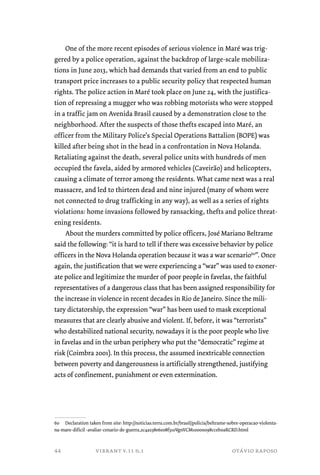


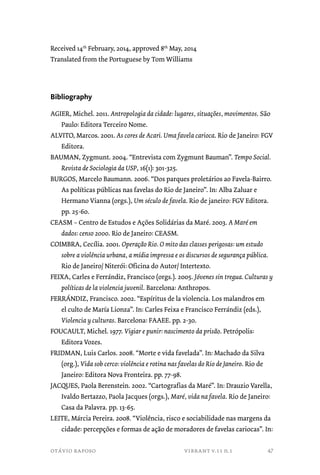

![local”. In: Gilberto Velho e Marcos Alvito (orgs.), Cidadania e violência. Rio
de Janeiro: Editora UFRJ e Editora FGV. pp. 48-68.
ZALUAR, Alba. 2009. “Pesquisando no perigo. Etnografias voluntárias e não
acidentais”. Mana. Estudos de Antropologia Social, 15(2): 557-584.
ZALUAR, Alba & ALVITO, Marcos (orgs). 2006. Um século de favela. Rio de
Janeiro: FGV Editora.
WEBSITES CITED
http://www.onu.org.br/estudo-do-unodc-mostra-que-partes-das-americas-e-
da-africa-registram-os-maiores-indices-de-homicidios/ [accessed on
April 19, 2013]
http://extra.globo.com/casos-de-policia/caveirao-servico-do-trafico-na-mare-
297199.html
[accessed on December 10, 2010]
http://www.chicoalencar.com.br/chico2004/chamadas/pronuncs/
pronunc20090924b.html
[accessed on October 3, 2009]
http://g1.globo.com/Noticias/Politica/0,,MUL155710-5601,00-
CABRAL+DEFENDE+ABORTO+ CONTRA+VIOLENCIA+NO+RIO+DE+JAN
EIRO.html [accessed on September 24, 2009]
http://www.upprj.com/index.php/historico [accessed on May 6, 2014]
http://veja.abril.com.br/311007/entrevista.shtml [accessed on May 4, 2014]
http://zerohora.clicrbs.com.br/rs/noticia/2008/12/bandido-bom-e-bandido-morto-
43-dos-brasileiros-concordam-com-a-expressao-2329250.html
[accessed on April 19, 2013]
http://extra.globo.com/noticias/rio/para-policia-operacao-no-alemao-vai-enfraquecer-
trafico-em-outras-favelas-680548.html#ixzz30y5gJP9l
[accessed on May 6, 2014]
http://noticias.terra.com.br/brasil/policia/beltrame-sobre-operacao-violenta-na-
mare-dificil-avaliar-cenario-de-guerra,2c4a238e6e08f310VgnVCM1000
0098cceb0aRCRD.html
[accessed on May 5, 2014]
http://www.cartacapital.com.br/sociedade/populacao-carceraria-brasileira-cresceu-
7-vezes-mais-que-a-media-mundial-nos-ultimos-15-anos-5518.
html [accessed on May 12, 2014]
otávio raposo vibrant v.11 n.1
49](https://image.slidesharecdn.com/v11n1-140831205434-phpapp02/85/Vibrant-Ethnographies-of-economy-ics-49-320.jpg)





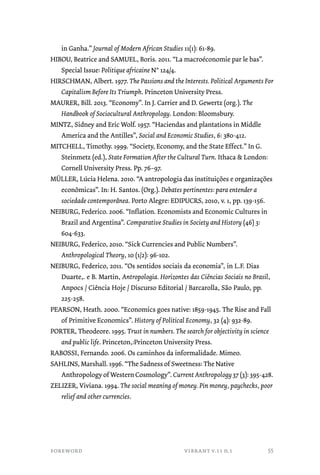
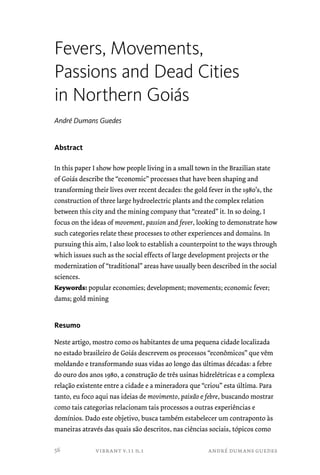


![Most of the people I met there had once worked in mining or related
activities. If they still lived in Minaçu, it was partly because they lacked
the means to walk away and try their luck elsewhere after this work had
vanished. There was little left to do except wait (esperar) without much hope
(esperança):1 either for highly unlikely financial compensation for the losses
caused to them by the dams, or for the arrival of new companies reinjecting
some movement into the town, or for some kind, any kind, of initiative from
politicians – just as improbable – that could help them to walk on their own
two feet again. In the meantime, jobless and at a standstill, they lived off
minimum income programs2 and retirement pensions, occasional odd-jobs
or the food baskets distributed by a social movement formed in the region to
defend the rights of those affected by the dams.
By presenting their situation to me in this way, local people never
ceased to challenge some of my preconceptions concerning the difficulties
experienced by those “people affected by dams” in general. After all, since
the mid-1980s innumerable studies across a wide range of disciplines have
devoted themselves to analyzing the social impacts of hydroelectric dams
in Brazil.3 For several years I myself had worked on these issues both as an
academic and as a consultant for the social movement cited above. Indeed
it was partly due to this background that I had decided to carry out the
fieldwork for my doctoral thesis in Minaçu.
In the vast majority of these studies, and likewise in the campaigns
fought by those affected by the dams, the drama experienced by the latter
population is presented mainly in terms of “compulsory relocation”: the
forced migration of populations living in the areas where these projects
have been implemented. However, going by what people told me in Minaçu,
things there took on another guise: unable to walk away and made keenly
aware of the sedentary and captive lives of those who depend on the help
1 L’Estoile’s observation (2014: 13) concerning the verb esperar can also be applied to this context: as he notes,
the term fuses the ideas of ‘expecting,’ ‘waiting’ and ‘hoping.’
2 These programs involve financial resources transferred monthly by government bodies at federal or state
levels to people classified as poor.
3 In the 1980s works by Marazzarollo (2003 [1980]), Sigaud (1988), Sigaud et al. (1987) and Grzybowski (1987)
anticipated and inspired research studies that would multiply exponentially from the mid-1990s. For a partial
review of the existing literature, see Magalhães (2007). Consolidation of this field was attested by the organization
in Belém, at the end of 2010, of the III National Encounter of Social Sciences and Dams, held in parallel with the
II Latin American Encounter of Social Sciences and Dams, bringing together more than 200 works by Brazilian,
Latin American, U.S. and European researchers.
andré dumans guedes vibrant v.11 n.1
59](https://image.slidesharecdn.com/v11n1-140831205434-phpapp02/85/Vibrant-Ethnographies-of-economy-ics-59-320.jpg)

![we should note that references to “cursed money” are also common among
groups who, like miners, are often subject to moral condemnations and
who live off an irregular and inconstant flow of resources: transvestites, for
instance (Garcia 2008: 250) or drug traffickers (Zaluar 2004) and prostitutes
(Almorin et al. 2010: 119).
However we need to pursue the question further. While these accusations
are undoubtedly widespread and taken seriously, they far from exhaust
everything that the miners have to say about the mobility and movements of
resources and wealth. Firstly my interlocutors know very well that money’s
exceptional volatility is not limited to the mining industry, and they would
undoubtedly concur with the rural workers of the Zona da Mata region of
Pernambuco described by L’Estoile (2014: 21). For the latter, “money [...] is
seen as utterly unreliable. In the experience of the poor, money withers away
fast. The general expectation is that, if one happens to earn money, one
spends it immediately”. In the case studied by L’Estoile too, therefore, they
are frequent “stories of people who, having received significant amounts of
money, spent it, and became as poor as before” (2014: 22).
This helps explain the salience of the contrast made between this “cursed
money” and the gold nuggets that remain still from the mining era, which,
some say, “seem holy”. Not by chance they were customarily given as presents
by miners to their children, forever concerned “to leave something” for
them. The physical attributes of the nuggets – which justify or reinforce the
cultural meanings attached to these objects – explain why they were ideal
for performing the role of heirlooms to leave for one’s offspring, just as they
make explicit how these distinct resources, with their different propensities
to move about, are preferentially associated with particular spaces. On one
hand we have money or gold dust whose “liquidity” enables their rapid
transformation into anything else (drink, clothes, presents…) and spent in
the cabarés (strip clubs and brothels) or any other corner of the rua (street),
moving very easily, becoming frittered away and lost. On the other hand we
have the nugget – solid, hard and durable – which must be carefully hidden
away (mocozada): preferably by a woman and ideally inside the home.
Even today, therefore, adult men and teenagers can be overheard asking
women (their wives or mothers) to safeguard and store their resources – “if
I keep hold of it, I spend everything..”. Even things as solid as nuggets seem
to become slippery and elusive in male hands, a fact shown by the many
andré dumans guedes vibrant v.11 n.1
61](https://image.slidesharecdn.com/v11n1-140831205434-phpapp02/85/Vibrant-Ethnographies-of-economy-ics-61-320.jpg)
![stories in which the lumps fall back into the river or vanish from the pocket
of a miner’s shorts while diving in the water, as though wanting to return
from where they came. Likewise the use of gold teeth, a frequent practice
among miners, is intended to confer durability and permanence to the gold,
preventing its dissipation by keeping it bound to the body (and far from the
miner’s hands where money never stops).
For many people these nuggets are not envisaged as savings or a reserve,
something that could eventually be transformed into money through sale.
Frequently they are conceived rather as something that must be kept forever,
both by givers and receivers. “No way lad! I’ll never give away or sell this
nugget, even if I’m strung up to die, it will stay with me”. Experiencing
considerable financial difficulties with no money left for food, Altino and his
wife went so far as to “scrape the copper” off old mining equipment to obtain
a little income. Even so they never once considered selling the nuggets they
had given to their two children, still young, which could have been sold for a
relatively high price.
These nuggets could be said to represent, then, the kind of “fixed points,
realities that are exempted […] from the exchange of gifts or from trade”
described by Godelier (2001: 17) who also reminds us that Mauss had already
highlighted the existence of two types of copper among the Kwakiutl, the
most important being items that “do not go outside of the family” (ibid: 54).
Moreover, as objects excluded from circulation, these nuggets seem to affirm
“the existence of identity differences between individuals” (ibid: 54), male
giving contrasted with female keeping (cf. Weiner 1992), where the physical
limits of the house signal those “conversion thresholds” analyzed by Guyer
(2011: 2215), “often implicating different moral economies”. The comparison
with L’Estoile (2013: 22) is also instructive: while in the case studied by
myself, money’s fluidity is contrasted with the duration and durability of
the parental relationship with children, in the case described by the author,
money – “essentially short-term and fugitive” – is contrasted with friends
“valued as a long-term resource: friendship is a personal relation, which is
supposedly stable over time”. The references to “cursed money” can thus be
conceived in light of these “moral assessments of certain adjectivally marked
moneys – dirty money, hot money, bitter money, money that burns like oil,
‘liquid’ money – [derived] from those money’s positions as hinges between
short-term and long-term transactional orders (Maurer 2006: 24)”.
vibrant v.11 n.1 andré dumans guedes
62](https://image.slidesharecdn.com/v11n1-140831205434-phpapp02/85/Vibrant-Ethnographies-of-economy-ics-62-320.jpg)
![But while examples of contexts where money is rapidly consumed are far
from rare – indeed its volatility or liquidity sometimes appears inherent –
why should it be qualified as “cursed”? Referring to the tropeiros (muleteers)5
of the end of the seventeenth century, Buarque de Holanda (1994: 152-4)
emphasizes how they lacked the “rationalizing asceticism” so typical of the
bourgeois ideal: these “rustic men” were known for a “love of luxury and the
pleasures”, evident in how they spent all their earnings on brothels (cabarés),
gambling, the theatre or decorating their horses with precious metals. In
relation to the miners, Cleary (1992: 123) stresses that in the region of Eastern
Amazonia studied by himself and beyond, “the stories that [they] most enjoy
recounting and hearing are tales of how the profits from a bonanza were
spent. The more spectacular the extravagance, the greater the esteem with
which the story is held”. The references to the notorious “consumerism” of
the work site labourers or peões do trecho – who I shall introduce to the reader
below – are also as old as the references to them in the literature, in various
cases pervaded with a reproachful tone from the author concerned. Is there,
then, some particularity that marks and interconnects contexts like these,
whose notoriety arises precisely from the excessive “squandering” of money
and “extravagant” forms of consumption?
2. Times of fever and passion
While the references to “cursed money” may be used to morally condemn
the behaviour of oneself or others, it is also undeniable that the accounts of
the mining era are permeated by other modulations: by the passion and the
fervour, for example, elicited even today by the memory of experiences in the
past. Initial caution and reticence are gradually abandoned as enthusiasm
engulfs the speaker and makes him forget or overlook what might ever be
reprehensible in his behaviour… How not to become excited and agitated
with the narrative of those busy days of the past, during the gold fever?
In the academic or native descriptions of mining, the term “fever” is
commonly used to explain the dynamic unleashed by the discovery of gold-rich
areas that overnight start to attract a large influx of people. Cleary
5 The tropeiros led the trains (tropas) of pack animals that plied the route between diverse centres of commercial
production and consumption during Brazil’s colonial era (and up until a few decades ago in regions like Goiás
discussed here).
andré dumans guedes vibrant v.11 n.1
63](https://image.slidesharecdn.com/v11n1-140831205434-phpapp02/85/Vibrant-Ethnographies-of-economy-ics-63-320.jpg)
![(1992: 27) emphasizes, for example, that “most of the historical literature on
gold mining in colonial Brazil […] often seems little more than the record
[of these] rushes” which erupt and vanish “just like the repeated outbreaks
of malarial fever”. Cleary’s image here in fact echoes my interlocutors’ own
familiarity with the disease and the association with the idea of the gold
rush: both gold fever and malaria begin suddenly and quickly peak before
vanishing completely soon after, probably to re-emerge at another time or
place, following the same pattern.
However it should be emphasized that, for my interlocutors, the
economic dynamics evoked by the idea of fever are not exclusive to gold
mining. Back in the mid-1970s, before the town was invaded by miners
attracted to gold ore, it was casseterite that triggered an intense and rapid
influx of outsiders into Minaçu. Then, from the 1980s onwards and to a large
extent overlapping the gold mining activity, it was the dam construction
works – Serra da Mesa, Cana Brana and finally São Salvador – that moved the
town. Casseterite fever, gold fever, dam fever: all these cases involve processes
that, from the native viewpoint, converge in many aspects.
Characterized by the particular modes through which they intensify
agitation and movement, the times and spaces of the fevers are marked,
therefore, by a number of traces that manifest more or less independently
of the specific nature of the productive activity. On a very general
level, and without any pretence to exhaust the subject, we could cite:
a) a predominantly male population, caused by the arrival of outsiders
attracted by the opportunities enabled by the fever, including the
possibility of making relatively quick money; b) the huge number of
cabarés (strip clubs), brothels and gambling houses opened to cater for
this public (many of these businesses also being “mobile”, “circulating”
through different areas); c) the rapid multiplication of a rich spectrum
of small and medium-sized businesses and services, both formal and
informal, “local” or “outside”, offering goods and services to this affluent
population or to support the productive activity responsible for setting
off the fever; d) a peculiar pattern of “urbanization” in which temporary
buildings, encampments and accommodations overlap the previously
existing “provisional” nature of “popular” spaces and ways of life (that very
often appear more stable merely in comparison to this pattern); and e) a
reorganization of the wider regional economic flows as an outcome of the
vibrant v.11 n.1 andré dumans guedes
64](https://image.slidesharecdn.com/v11n1-140831205434-phpapp02/85/Vibrant-Ethnographies-of-economy-ics-64-320.jpg)


![directly related to its radicalization – heating, agitating, moving – of the
already intense temperatures and velocities of fevers.
However this imbrication of different kinds of “lack of control” – one
passion stimulating another passion – is not limited to the world of mining.
Indeed fevers are not limited to gold digging: in Minaçu they also erupted
during cassiterite mining and during the construction of the hydroelectric
dams. Consequently we need to make explicit the relations that approximate
– and sometimes render indiscernible – the peões do garimpo (mine labourers)
and the peões do trecho (construction site labourers).
Taken broadly, the term trecho – “section” or “tract” – designates the
work site and wider reality of the mobile or itinerant labourers employed on
a temporary basis in large-scale projects of various kinds, usually located
in Brazil’s Centre-North region: agroindustrial projects, mineral and metal
extraction, hydroelectric plants and infrastructural works.9 More generally,
anyone who is far from his homeland, moving town and switching jobs
with some frequency may be said to be on the trecho – actually a fairly
commonplace experience in those parts.
As well as working as miners, the large majority of my interlocutors
had also been peões do trecho – many of them employed in the construction
of the same dams that had made their work in the gold mines impossible.
Others arrived in the town to work on the construction site for the first dam
and after a time went into mining. Certainly there is nothing exceptional
in such cases: the overlaps between large-scale projects and mining areas
are relatively common in some regions (Oliveira 1989, Gaspar 1990). In these
cases, one fever “pulls” or combines with others: especially in “frontier”
regions, a series of factors contributes – or at least did so until recently – to
the opening or reactivation of mining areas in the wake of these projects:
a) the prior influx of labour to these areas, swelling the local population; b)
9 In his autobiography – symbolically entitled Urrando no Trecho. Recordações de um Engenheiro de Obras
[Howling on Site. Recollections of a Construction Engineer] – Corrêa (2007: 11) provides the only explanation I
know for the emergence of the term trecho: “[This term] comes from the big linear highway construction works
where it is common practice to divide the total volume of work into lots, allocating them to different construction
firms [who are assigned responsibility for different] work sections or trechos. In a casual encounter between
workers building the same highway, it is common for one to ask: ‘What section [trecho] are you on?’ followed
by the reply that identifies the firm responsible for the section in question and the kilometres delimiting its
section of the highway. The term trecho became propagated outside its initial borders and, as if all of Brazil were
one immense building site, came to designate all the large-scale construction projects and the men working on
them, the peões do trecho, the ‘section labourers,’ nomads par excellence and by necessity”.
andré dumans guedes vibrant v.11 n.1
67](https://image.slidesharecdn.com/v11n1-140831205434-phpapp02/85/Vibrant-Ethnographies-of-economy-ics-67-320.jpg)
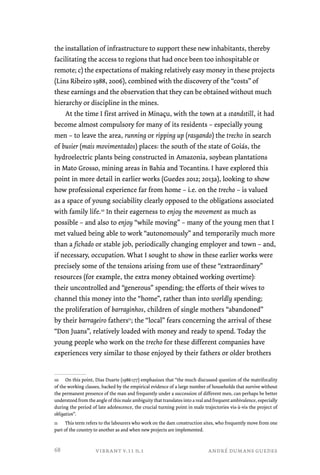

![agree that there is something (or even much) that is “festive” about the
experience. Like the Inuit winter, these are ideal circumstances for the
“phenomenon of sexual licence” (ibid: 478) and for the proliferation of “a
continual round of communal feasts” (ibid: 494).
However there is no need to journey so far away from Goiás to establish
productive comparisons for my present argument. We can turn, for
example, to what Dainese (2013: 5) has to say about the time of politics in the
rural community studied by herself in the interior of Minas Gerais, a few
hundred kilometres from where I worked. For the residents of the locality in
question, this “time” is also defined by the fact that during it “there is a lot
of movement”: this is “a moment involving a greater circulation of people, a
diversification of events, a transformation of spaces, an outbreak of passion”.
Not by chance these are the ideal circumstances for the emergence of “a
state of affairs called a lack of control”. Both in fever and in the time of politics,
we seem to be presented with situations involving an “acceleration” of life
(Dainese 2013). This comparison is also useful since it affords a counterpoint
to the “effervescences” of Durkheim (2008: 547) and the “orgies” of Mauss
(2003: 501). Unlike what happens in these circumstances, mining and the
time of politics are not exactly celebrations of the “collective” or of established
social ties. As we saw above, fever (and likewise the trecho) lead to movements
of passion and lack of control that generate tensions, distancing men from
their families. Dainese (2013: 11) meanwhile describes how the time of
politics offers a perfect occasion for fights, misunderstandings and deaths. Not
coincidentally, one of her interlocutors emphasizes that during this period
“kinship comes to an end”.
But while the similarities between these two situations are striking,
we also need to highlight important differences concerning the nature of
the temporalities involved. The “time of politics” mentioned by Dainese
is explicitly inscribed in the line of research developed by Palmeira (2001).
The latter, according to Dainese herself, shows how “the organization of
social life into times – […] time of politics, time of festival, time of harvest –
implies another pace to activities and behaviours” (Dainese 2013: 5). Hence,
in terms of this or that “appropriate time for the performance of particular
activities deemed important by society” (Palmeira 2001: 173), we are dealing
with variations that, like those considered by Mauss (2003), could be called
“seasonal”. The alternation, duration and succession of these times are thus
vibrant v.11 n.1 andré dumans guedes
70](https://image.slidesharecdn.com/v11n1-140831205434-phpapp02/85/Vibrant-Ethnographies-of-economy-ics-70-320.jpg)

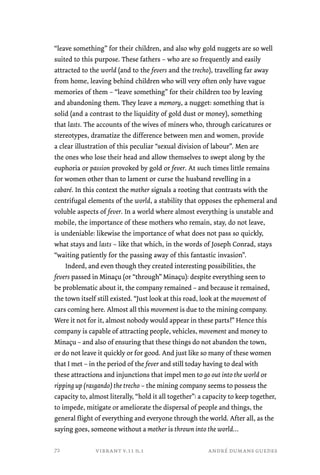
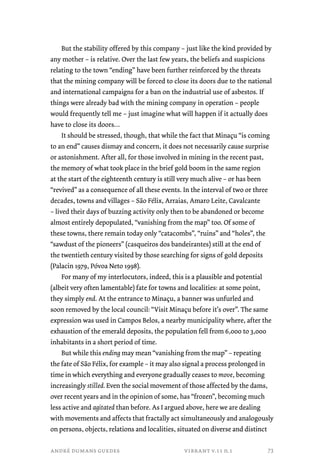
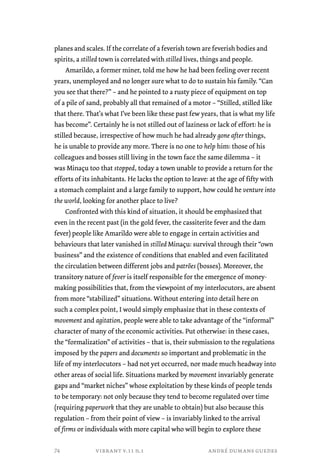
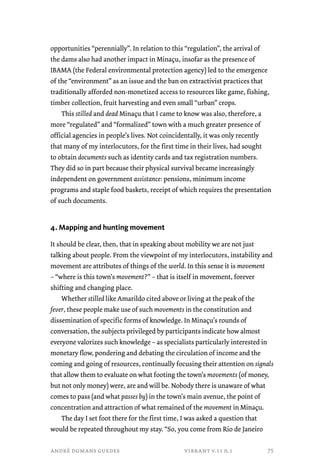
![then? What firm do you work for?” Concerned to make my purposes clear, I
would invariably reply that I was linked to the university and there to carry
out research. It was only towards the end of my field research that I realized
that, by stating things in this way, I was suggesting to my interlocutors
something quite different to what I intended. As I would discover over
time, the people there have been familiar with visitors like myself for some
time: someone white, educated, coming from a large urban centre to research
a subject in places like Minaçu. In the hotel where I stayed during my
first days in the field, I was in the company of other people with the same
characteristics: but they were there to conduct mineral research.14 If local
residents are always attent to the circulation of such people, it is because
everyone knows that research work may announce the arrival of another large
mining firm: “yeah, they say that Vale is arriving…”15
Researching those who conduct research, mapping the arrival and
circulation of these outsiders, ficar curiando (pretending to be naïve, but
listening carefully), learning about the rumours: a car with the logo of
such-and-such company parked in the town centre, a truck without any
identification drove past carrying prestigious and well-read people – and
some person already become agitated. In an interview given to the local radio
station, the mayor comments on his visits to Brasilia or Goiânia, can one
really believe that he will bring these investments to Minaçu? “And if Minaçu
is left with just the town council, you know how that will turn out…” The
“town council” here refers metonymically to all the state resources passed
onto the town. It is also for this reason that the idea of turning into a “town
of pensioners” alarms the residents so much. Everyone knows what a town
“without a firm” means. Many have been born in such places, or have passed
14 Certainly this is no mere coincidence. On the historical relationship connecting fieldwork in geology and
anthropology, see Kuklick (1997).
15 “The excellent performance [of Goiás’s mineral economy in the 2000s] attracted the interest of various
groups active in the sector that had turned their back on mineral exploration in the state. They returned in
force. In 2004 the mighty Companhia Vale do Rio Doce (CVRD) alone [the company Vale mentioned in the above
comment, a Brazilian form that is today one of the largest mining companies in the world] requested more than
200 permits from Goiás`s National Department of Mineral Production (DNPM) to explore the state’s subsoil”
(Galli 2007: 63). While I was still conducting my fieldwork in the north of Goiás, it was the town of Crixás –
founded during the eighteenth-century gold boom and since then experiencing an alternation between periods
of ostracism and fever – which moved with the activities of the mining companies, even coming to be called “the
Dubai of North Goiás”: “The frenetic buzz of motorbikes, the lack of hotel vacancies, a throbbing commerce.
The buzz typical of a large economic centre has taken over the apparent tranquillity of the Goiás municipality of
Crixás, a little town of 15,100 inhabitants, 350km from Brasilia” (Correio Braziliense 2010).
vibrant v.11 n.1 andré dumans guedes
76](https://image.slidesharecdn.com/v11n1-140831205434-phpapp02/85/Vibrant-Ethnographies-of-economy-ics-76-320.jpg)

![often seen operating in rural communities and places less “mundane” and
“accelerated” than Minaçu).
On a quick visit to people she knew in Rubiataba, town located a few
hours from Minaçu, Aparecida used her time to learn more about the town’s
movement. She discovered that it was a “city without a firm” and that it also
did not have any movements like the movement of people affected by dams,
which guaranteed her a staple food basket each month. Aparecida also
checked how much the local council paid its street cleaners: not only because
she could do this job, it would also provide her with a parameter to measure
the regional variations in the basic decent wage paid to workers without any
qualifications or study. “No, best to forget for now this idea of leaving here
just to be a bit closer to my sister…”
The techniques and knowledge used by miners to localize a deposit, a
good boss or an ideal place to work seem to have been extended to other
spheres, guiding the search for other opportunities and movements. Here the
suggestion of Banaggia (2012: 42-3) is valuable: he suggests that the miners
of Chapada Diamantina consider their activity “more akin to hunting than
gathering”. This is especially because the diamonds sought by the local
miners “have their own life”, “capable of moving about on their own free
will”. What is most interesting about this approximation to hunting – a term
indeed widely used by this people, forever hunting for better, hunting their
direction, hunting their destiny – is the idea that both those who search for
something and the thing sought are in movement. (For people who are always
on the move, “hunting” for movements is an imperative: but is it not also this
“hunting” for movements which places people in motion?)
It needs to be remembered that frequent and “well informed”
dislocations have always characterized the practice of mining. Among the
institutions created with this purpose, we can highlight the rádio-peão or
“worker radio”, a native term for the informal networks through which
information circulates that allows, after an area’s decline, the miner to
look for another place to work.16 Given the relations and passages existing
16 “It is no exaggeration to say that informal chat is one of the most important processes in gold mining. It
broadly explains, for example, how the miners move from region to region with such ease, travelling distances
that would seem immense to a European, but which a porcentista [miner working on a percentage basis] will
regard just as nonchalantly as a carioca [a Rio de Janeiro resident] might contemplate a walk from Ipanema to
Copacabana. Very often a miner without any experience of an area will travel with another miner who he met at
another mine and who knows the area very well. Even when he travels alone, a miner will invariably have an idea
vibrant v.11 n.1 andré dumans guedes
78](https://image.slidesharecdn.com/v11n1-140831205434-phpapp02/85/Vibrant-Ethnographies-of-economy-ics-78-320.jpg)
![between the universe of mining and that defined by the large construction
works and projects, it is unsurprising that a rádio-peão is also found among
the workers of the latter. For a specialist engineer in these projects (Corrêa
1987: 23-4), the latter is “one of the quickest means of communication
existing on the face of the Earth […] [and] it possesses an impressive speed
and reliability. Everything is known through it”.17
5. Fevers and movements: surprising or familiar?
Comparing Minaçu with other “more stabilized” towns, the reflections of my
interlocutors were not very distant from those informed by the opposition
cherished by rural and peasant studies in Brazil: namely the contrast between
areas of long-standing occupation and the new or frontier zones.
In the discussions on the agricultural frontier of the 1970s and 80s (e.g.
Martins 1997, Velho 1981, 1979) or in the more recent debates concerning
the effects of the advance of new frontiers of accumulation (e.g. Almeida
2010), this idea of “frontier” opens up a privileged space for considering
various situations and phenomena in the light of questions not only
relevant to the social sciences but also properly constitutive of them.
Along these lines, we could suggest that such “frontier situations” have
offered (and continue to offer) the researcher studying the Brazilian case
the opportunity to accompany, in situ and through field work, phenomena
that in other situations – in Western Europe or even in the USA say – can
only be apprehended through historical accounts: Marx, in the famous
Chapter XXIV of Capital, describes the aggressive process of expropriation
that separates peasants from their means of production and uproots them
from their traditional world, while simultaneously constituting land and
work as commodities. The very geography of populating and occupying
of the best route, the best mines, and the kinds of problems likely to be encountered, through prior contact with
a miner who worked in the region. This information is frequently very specific, including the names of hotels and
owners with a good reputation. This makes the movement between the mining regions much less problematic”
(Cleary 1992: 141).
17 On this point, the anecdote (or real story?) narrated by the same author is suggestive: “One time two
engineers, to test the stealth and speed of this network of intrigues and rumours, scribbled on a sheet of paper
the list of wages for recruiting employees at a non-existent project for maintaining, operating and lighting of the
TransAmazonian highway [...] The wages proposed were something like five times the amounts typically paid in
the region. They left the scribbled sheet on the meeting table in an envelope labelled ‘confidential.’ The next day,
on arrival at the work site, there was an enormous queue of candidates looking to be hired [...],even presenting
letters of recommendation from local politicians” (Corrêa 1987:23-24).
andré dumans guedes vibrant v.11 n.1
79](https://image.slidesharecdn.com/v11n1-140831205434-phpapp02/85/Vibrant-Ethnographies-of-economy-ics-79-320.jpg)
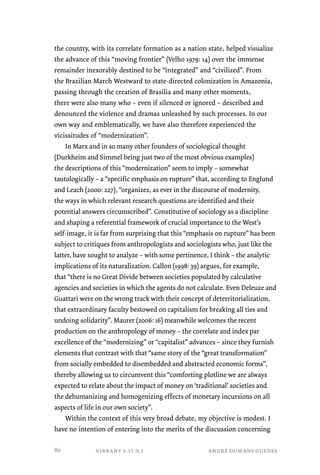


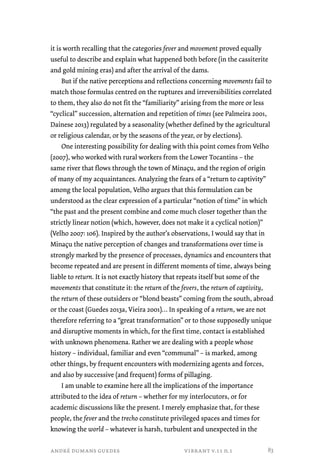
![latter manifesting in a particularly striking manner in these circumstances,
which also makes them such ideal “schools” (Rumstain 2009). As I looked
to show elsewhere (Guedes 2013b: 338), we could claim therefore that, from
the native viewpoint, “movement is necessary in order for knowledge and
thought to exist”.19 The belief and expectation that movements will be present
– returning or able to be experienced elsewhere – thus anchor a “popular
cosmopolitanism” (Guedes 2013b: 337-338) which seems to entirely contradict
the widespread image of “peasants” or “communities” surprised by the
“modernity” that suddenly irrupts within their previously tranquil and
“traditional” worlds.
We can return then to our consideration of how social life is regulated
in terms of times. Extracting some of the consequences of this, Palmeira
(2001: 172) argues that, in this case, “social order is […] perceived […] in
terms of adapting behaviours to particular ends posed at certain moments”.
Developing the author’s suggestions, we could provisionally argue that
– as occurs in the “time of the strike” (seen by the managerial sectors as
“the clearest example of subversion”) – the experiences of fever or the
trecho are themselves “ordered” rather than being an expression of “social
disorganization” or any modality of “derooting” or “deterritorialization”.
Clearly they are not that “ordered”, their relative confusion and turbulence
serving indeed to define them as a counterpoint to milder situations.
Making this claim is not to mitigate the seriousness or potential
drama frequently involved in such modernizing projects. On the contrary,
it recognizes that before the “arrival” of the latter, the people who are
affected by the projects rarely experienced the “peasant”, “community” or
“traditional” idyll often suggested – consciously or not – by various analysts.
In this sense, the importance attached by local people to movement suggests
how forms of knowledge, practices or ways of life both express and are
conditioned by a “worldview” in which the unstable, turbulent, ephemeral
and provisional possess a singular cosmological centrality – an idea
19 Carneiro (2010) and Medeiros (2010) emphasized the same point in relation to other regions but dealing with
universes geographically and culturally not very distant from my own. It was Rumstain (2009), on the other hand,
who first explored the implications of the frequent statement among her interlocutors (migrants from Maranhão
working on soybean plantations in Mato Grosso) that “the trecho teaches”. Without giving much attention to this
point, Woortman (2009: 219) had already pointed out in the 1980s how the experience of movement, via migration,
constitutes a rite of passage for the male children of North-eastern rural workers: “To become a man it is necessary
to confront the world [...] Having travelled makes people superior to those who have never left the place”.
vibrant v.11 n.1 andré dumans guedes
84](https://image.slidesharecdn.com/v11n1-140831205434-phpapp02/85/Vibrant-Ethnographies-of-economy-ics-84-320.jpg)
![confirmed by some of the native meanings attached to the notion of a world.
It is through the acceptance – simultaneously and alternately tragic, fatalist
and trecheira (i.e., “cunning“) – that this is the way things are that this
experience of “disorder” can itself be “ordered”. Moreover, when this state of
affairs is recognized and accepted, it becomes possible to make a virtue out
of necessity – considering, like Sahlins (1997: 53), the reality of those “who
knew how to extract, from ill fate, their […] conditions of existence”. Those
same movements that unleash dramas and disturb so many lives – we can
think, for example, of the dam-building fever that led to the obliteration of
mining – are seen as opportunities to start again and make new investments,
albeit provisional (see the case of the small traders who adapt to the new
clientele, swapping the miners for dam construction workers) or elsewhere
(as in the case of miners who were able to gain basic qualifications and enter
the work market for the large-scale projects, following the movement across
the rest of Brazil).
Furthermore while the native perspective presented here in discussing
this point diverges somewhat from the narratives typically found in this
recent sociological literature, it seems to me that we can still usefully
compare them to other academic formulations that indicate just how old
the experiences and phenomena discussed here may be. Here I have in mind
the formulations used by historians and some of the prominent names
of Brazilian social thought to describe, across a broader time span, the
economic dynamic of the country or of some of its regions. Prado Jr. (1969:
186) for instance argues that this
evolution in jumps, through cycles that alternate in time and space, prosperity
and ruin […] summarizes the economic history of colonial Brazil […] in
each declining phase, a piece of the colonial structure is undone, the part of
society affected by the crisis disintegrates. A more or less substantial number
of individuals become ruined, lose their roots and the living basis of their
subsistence. They begin to vegetate on the margins of the social order.
For Buarque de Holanda (1990: 71-2), meanwhile, these comings and
goings of “an immense floating population, without a clear social position,
living parasitically on the edge of regular and remunerated activities” is a
direct consequence of the “intrinsic vices of the economic system of Colonial
Brazil”. Mello e Souza (1995: 90), for her part, argues that the intense mobility
andré dumans guedes vibrant v.11 n.1
85](https://image.slidesharecdn.com/v11n1-140831205434-phpapp02/85/Vibrant-Ethnographies-of-economy-ics-85-320.jpg)
![characteristic of the country’s interior populations, along with the instability
inherent to their lives, can be seen to be a consequence of
a colony of exploration destined to produce tropical crops whose
commercialization favoured as much as possible the accumulation of capital
in the hegemonic European metropolises. An economy with such a fragile
and precarious base […] was destined to drag down with it a large number of
individuals, constantly affected by the fluctuations and uncertainties of the
international market […] It seems evident that the poor and even moderately
wealthy population suffered greatly from this instability.
Discussing the role of the “missions to the interior” and the “civilizing”
voyages to the “outback”, Lima (1998: 74) claims that “repeated with Rondon
is a theme widely present in Euclides da Cunha, in the reports of the
expeditions made by the scientists of the Oswaldo Cruz Institute and in the
literary work of Monteiro Lobato20 – the abandonment that follows bursts of
progress, the image of the ‘dead towns,’ to employ the famous expression of
the São Paulo writer”.
6. Conclusion
The reference made above to Dainese (2013) is also interesting insofar as it
reveals that the centrality – “cosmological” and “sociological”, we could say –
attributed to the idea of movement is not limited to my interlocutors, which
is of course unsurprising given the movements of the latter, today and in the
past, through diverse areas of the country. Indeed we can note the recurrence
of this category, as well as the variety of meanings that it assumes, in a series
of recent works, focusing on the ways of life and thought of “outback” or
“rural” Brazilian populations, especially in the north of Minas Gerais and in
the states of Mato Grosso and Maranhão.
For Dainese (2011), movements regulate, signify and constitute not only
the time of politics, but also the “affairs of the Church” (ibid: 175) and
religious festivities, as well as the circulation between field and town – “lad,
what are you going to do here? This town is a desert, let’s go to the fields to
see the movement” (ibid: 15) – and the visits and hospitality, so fundamental
20 Rondon (1922), Cunha (1966) and Lobato (1975) cited in Lima (1988).
vibrant v.11 n.1 andré dumans guedes
86](https://image.slidesharecdn.com/v11n1-140831205434-phpapp02/85/Vibrant-Ethnographies-of-economy-ics-86-320.jpg)
![in this universe (ibid: 316). Even so (and in clear contrast to what happens
in Minaçu), the people studied by this author perceive themselves as a
“movement-less people” or “with little movement” – a “people who always
lived [right there]” (ibid: 60).
In the research presently being conducted by John Comerford (personal
communication) in the Jequitinhonha Valley, the moments of movement,
revelry and festival are considered to be part of the holiday season – a period
in which, as Mauss (2003: 473) had suggested, we also experience the kind
of “alternation [of ] the rhythm of concentration and dispersion” that so
spectacularly shapes “the morphological organization” of the Inuit studied
by himself. This is when the people return home who work afar – in the
trecho, we could say – especially in coffee plantations in the West, in the
Minas Gerais Triangle and in the interior of São Paulo. The movement of this
period contrasts not only with the rest of the year in which many houses in
the community remain closed but also with the somewhat stilled life of those
who, far from home, lack the company of friends and family.
In the view of Carneiro (2010: 45), the movement also produces a variety
of effects. The continuous circulation of people between Buracos, in the
north of Minas Gerais, “and the big world outside” helps us to understand
why for the author’s interlocutors – a “people brought together in the very
act of dislocating themselves” – a “land […] only exists in the movement of
its ‘people’”. The effects of “animation” and “movement” are also recognized
in the relation between food and prose: “in Buracos, offering something to
eat enables the conditions for prose; it gives it movement, ‘animation’” (ibid:
54); or in the joint work of the plantation, the “movement of people there”
becomes an activity “making people”, “an animator of people” and a “promoter
of marriages” (ibid: 209) – “daily movement is what makes the ‘people,’ where
plantation activity is both an index and a framework” (ibid: 213).
In the same region researched by Carneiro, both Andriolli (2011) and
Medeiros (2011) studied different transformations caused by the creation
of a National Park on the lives of groups previously living there. Evoking
the importance of autonomy, considering this dimension in light of the
commercial possibilities enabled by the “popular” and “informal” economies,
the main interlocutor of Andriolli (2011) nostalgically evokes the “time of
much movement” (ibid: 38): the “time of the elders”, the “time of plenty,
movement and freedom”, the “time of the right to create” (ibid: 3), the “time of
andré dumans guedes vibrant v.11 n.1
87](https://image.slidesharecdn.com/v11n1-140831205434-phpapp02/85/Vibrant-Ethnographies-of-economy-ics-87-320.jpg)
![the freedom of the cowhand who, on the back of the horse and making money
with their cattle, felt himself free of the ties of the boss” (ibid: 125). As in
Dainese (2011), Medeiros (2011) argues that movement evokes the valorization
of this sociability strongly based on “passing through” (ibid.: 38), “the
movement between houses” that among other things ensures the “circulation
of differences” (ibid: 44). Like Carneiro (2011), Medeiros (2011: 46) also
emphasizes the intrinsic relationship between movement and knowledge:
“whoever doesn’t walk doesn’t know”, the interlocutors of the former said.
Meanwhile the latter takes as her working material those “narratives that
privilege movement, in knowledge that is forged while one walks” (ibid:
94). Like my own acquaintances in Minaçu, Medeiros’s interlocutors also
contrasted the “stilled life” of the present with the “movement of the past”
(2011: 74): “‘the early time’ was a period ‘of much movement’”, “much less
silent than now” (ibid: 68). Radicalizing the consequences of this “stilled
life”, Medeiros (2011: 161) emphasizes that the “lack of movement that affected
people, cattle, plantation and fire, had repercussions not only for a ‘society’
based on roaming, but also for the ‘nature’ of the conservation unit” in
question with local “biodiversity” itself coming under threat.
A more systematic comparison between all these cases still remains
to be undertaken. Here the references to these works are intended to
situate my argument better, drawing a contrast between the ethnographic
literature relating to a particular “cultural area”, the one in which my work
is inserted, and the recent theoretical discussions concerning “mobilities”.
These discussions are largely anchored in a substantive and/or analytic
association between such “mobilities” and a particular characterization
of the contemporary world. Oriented by “a concern with diaspora,
deterritorialization and the irregularity of ties between nations, ideologies
and social movements”, Appadurai (1996: 18) argues, for instance, that “this
mobile and unforeseeable relationship between mass-mediated events and
migratory audiences defines the core of the link between globalization and
the modern” (ibid: 4). The reflections relating to these transformations
will lead, Urry (2007: 6) suggests, to a “mobility turn […] spreading in and
through the social sciences, mobilizing analyses that have been historically
static, fixed and concerned with predominantly a-spatial ‘social structures.’”
As I have looked to show here, from the viewpoint of my interlocutors,
movement, agitation or fever, rather than signalling a recent way of life or
vibrant v.11 n.1 andré dumans guedes
88](https://image.slidesharecdn.com/v11n1-140831205434-phpapp02/85/Vibrant-Ethnographies-of-economy-ics-88-320.jpg)





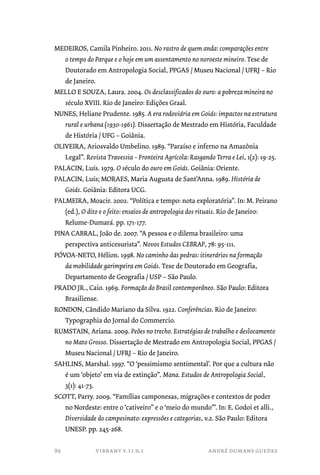
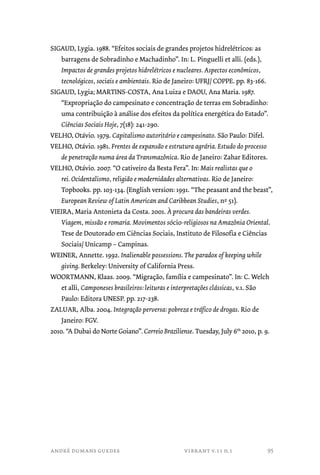





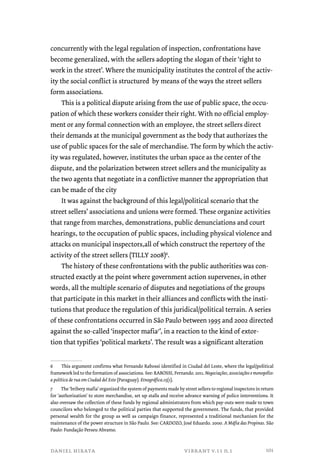

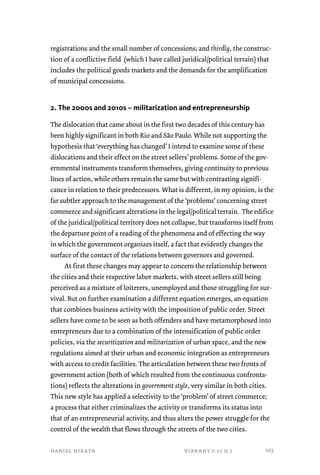


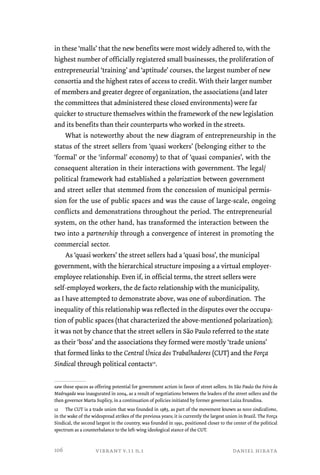


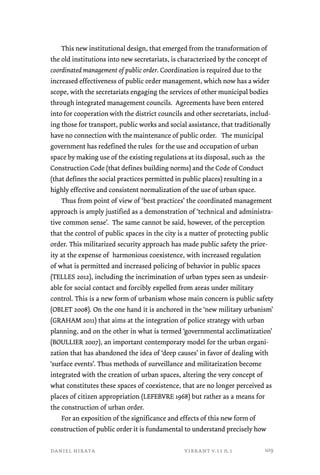




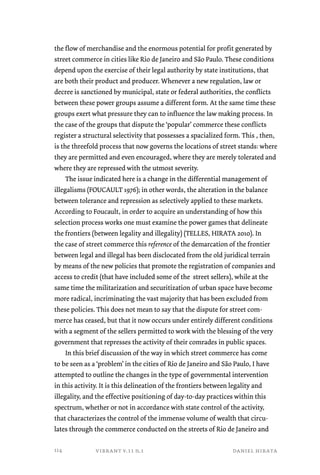



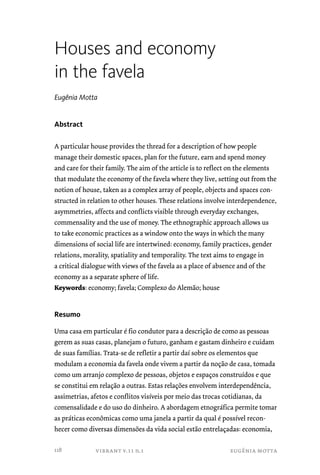

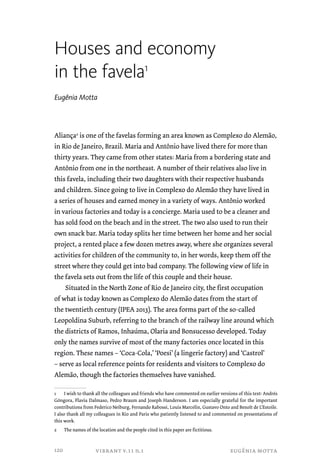

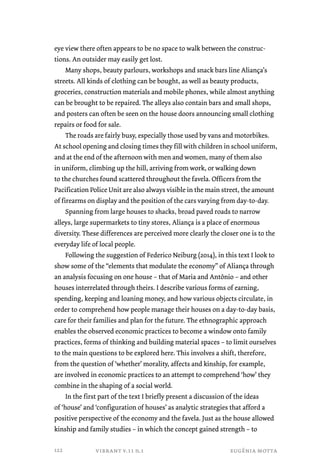

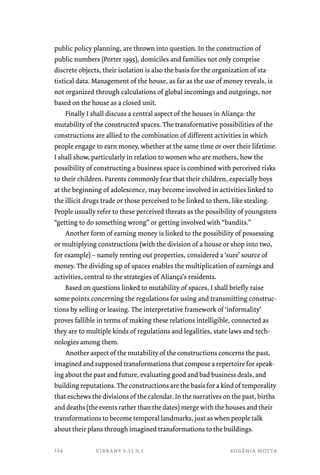

![the concept of household by suggesting an analytic integration of the
physical house and kinship relations, it is nonetheless of little use when
it comes to thinking of the social world of Bahia’s Recôncavo region.
One of the main questions identified in this shift away from the ‘societé
de maison’ is Marcelin’s interest in investigating “the conditions for the
emergence of the house and of the social practices that both construct it
and are constructed by it” (1996: 97), a question that Lévi-Strauss does not
tackle. Marcelin incorporates the suggestion of “introducing the house
as a physical reality and social institution into the centre of the analysis
of social organization” – recognizing the significance of Lévi-Strauss’s
contribution – but proposes to ‘re-situate’ the concept (ibid: 96). Hence
Marcelin’s use can be seen as a reformulation that proposes to deepen the
basis of Lévi-Strauss’s proposal while dropping its explanatory preten-sions,
in part because these are based on resolving a problem – the failure
of a particular structural model to explain certain phenomena – that for
the former does not apply.
The possibility of exploring the favelas from the viewpoint of their
houses was suggested by Marcelin in a footnote to his doctoral thesis (1996)
on the need to produce positive descriptions of the houses found in the poor
urban peripheries. As he observes, many analyses adopt a ‘miserabilistic’
approach that identifies the relations between houses, families and environ-ments
depicted as anomalous, or takes the house to be the expression of the
capacity to adapt to a context of deprivation. Marcelin also calls attention
to a text by Klaas Woortman, ‘Casa e Família Operária’ [The House and the
Working Class Family] (1980), one of the few texts to emphasize the impor-tance
of considering the house beyond its ‘material dimension’ as a ‘basic
need’ in the specific context of favelas.
At an analytic level, therefore, I shall follow the suggestion by Marcelin,
which he in turn attributes to Lévi-Strauss, namely to “place the house at
the centre of the analysis,” combining its physical and social aspects within
a relational approach. Marcelin also suggests focusing on the genesis of the
house – a question to be discussed later in this text in relation to Aliança
– and on the house as a ‘process,’ which resonates closely with the idea of
focusing on movement and transformation, in contrast to the construction
of fixed discrete units in the spheres of kinship or economic practices.
Marcelin writes:
vibrant v.11 n.1 eugênia motta
126](https://image.slidesharecdn.com/v11n1-140831205434-phpapp02/85/Vibrant-Ethnographies-of-economy-ics-126-320.jpg)

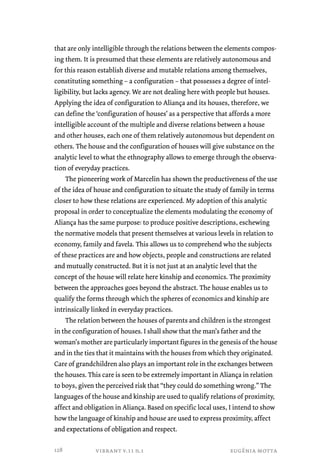
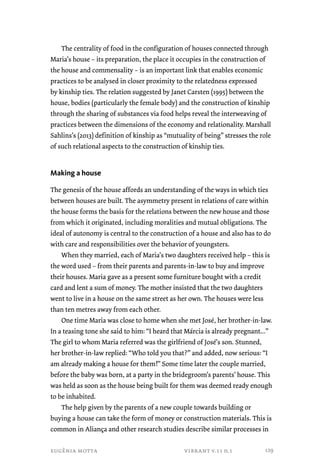





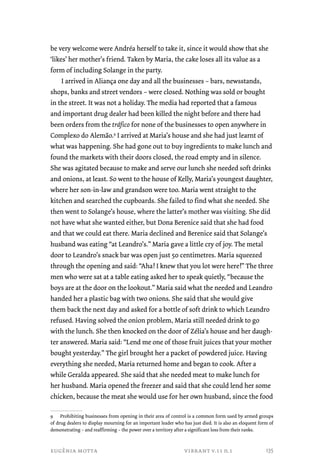



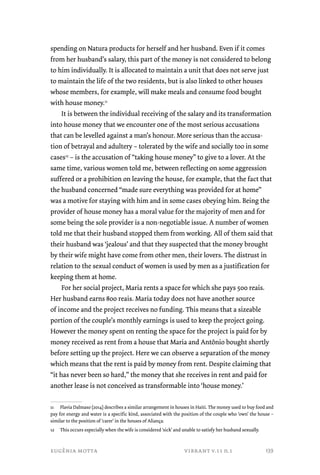

![‘household’ through its physical independence,13 and from there defines its
residents – who as individuals constitute the first level in the aggregation of
basic units within the IBGE Census – as members of ‘household units.’ The
‘monthly household income’ is the combined total income of the members
of these household units.
The first thing to observe is that the physical construction and its inde-pendence
precede the other definitions – household, family, for example
– along with the supposition that each person can only belong to a single
domestic unit. The census includes a series of recommendations and proce-dures
to avoid counting the same person more than once. Physical isolation
serves as the basis for defining how incomes are understood, which become
related to a set of persons (reinforced by the existence of the category of ‘per
capita income’) but only by derivation. While the house (in this case, the
physical house) is a determinant factor in calculating income, in contrast
to how the house is perceived in Aliança, it is its isolation that renders it
intelligible. Taking into account that the IBGE uses the same criterion for
its studies of family consumption, we are presented with the house as a
discrete unit where no ambiguity exists on belongs among its resident and
which is seen through an ideal similar to that of a company, also ideal, in
which the circulation of money can be summarized on a balance sheet of
incomings and outgoings.
In a United Nations document containing recommendations on censuses
(UN 2007), which aims to homogenize data from demographic studies, there
is one mention of the difference between the concept of ‘house-keeping’ and
‘house-dwelling’ in the definition of household units. The former takes the
relation to money and the upkeep of the unit as the most significant, making
it necessary to distinguish between people according to their position in the
economic maintenance of the house. The latter, which was used by the IBGE
in the 2010 Census, takes ‘dwelling’ to define the domestic unit.
According to the concept of ‘house-keeping,’ a household can be com-posed
of various domestic units. In the 2000 Census this was the conception
that guided the definition of the ‘family,’ which allowed for the existence
not only of ‘cohabiting families’ (more than one family living in the same
13 “Domicílio [household] is the structurally separate and independent locale intended for the habitation of one
or more persons, or which is being used as such. The essential criteria in this definition are those of separation
and independence” (IBGE 2012).
eugênia motta vibrant v.11 n.1
141](https://image.slidesharecdn.com/v11n1-140831205434-phpapp02/85/Vibrant-Ethnographies-of-economy-ics-141-320.jpg)
![household), but also of figures like ‘uniperson families’ and ‘unrelated fami-lies.’
We can note, therefore, between the 2000 Census and the 2010 Census is
a change in the concept used by the IBGE, switching from a ‘house-keeping’
model to a ‘house-dwelling’ model, which removed the concept of ‘family’
from the survey.14
What I wish to highlight here is the relevance given by professionals
of large numbers to the definition of economic units based on the idea
of ‘household,’ ‘family’ and ‘domestic unit,’ which, very different from
the house that we are discussing here, is a discrete and independent unit.
The understanding that can be generated from this conception necessar-ily
distances itself from the economic practices found in universes like
Aliança. This incongruence between the statistical models and the everyday
economy is one of the bases for the construction of the favela as ‘subnormal’
and ‘anomalous.’15 My interest here is not to show the distance between the
‘reality’ and the public figures, but to comprehend how the form in which
they are constructed and their underlying need to construct discrete units
generate spaces that are understood as anomalous. Foucault ([1977-8] 2008)
helps us understand this when he shows that regulations do not reflect the
desire of someone who wants things to operate precisely according to the
models, but create the boundaries between what will be considered ‘normal’
and – in this specific case, for instance – the ‘subnormal.’
Houses and businesses
Various works have demonstrated how houses as material constructions are
related to domestic cycles (Fortes 1971). Cavalcanti (2007) in turn shows both
the construction of a vila with various houses, related to the growth and
marriage of the children, and the relation between the successive improve-ments
made to the houses and the idea of the family’s progress. McCallum
& Bustamante (2012) show the relation between pregnancy and the arrival
14 On the critiques of the model used by the IBGE in the 2000 Census, see, for example, Alves (2005), Feijó &
Valente (2003) and Saboia & Cobo (2007).
15 The category ‘subnormal agglomerate’ is used by the IBGE to delimit the census sectors where favelas are
generally located. According to the IBGE, the subnormal agglomerate: “Is a complex constituted by at least 51
housing units (shacks, houses, etc.), most of them lacking essential public services, occupying or having until
recently occupied land owned by third parties (public or private) and generally distributed in a disordered and
dense layout” (2011).
vibrant v.11 n.1 eugênia motta
142](https://image.slidesharecdn.com/v11n1-140831205434-phpapp02/85/Vibrant-Ethnographies-of-economy-ics-142-320.jpg)






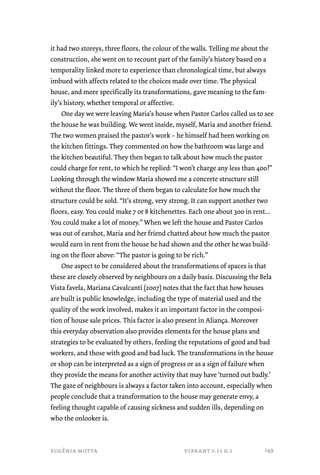
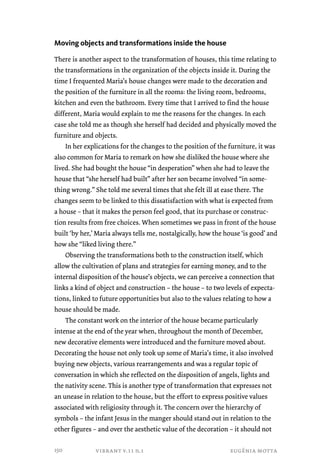

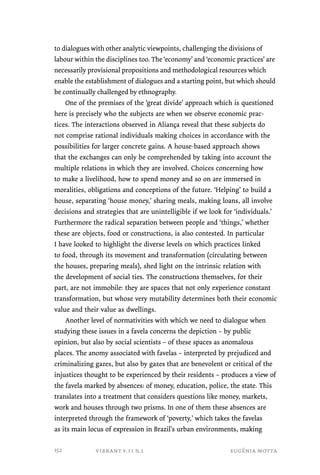
![it not only a given characteristic, but also a factor capable of explaining
‘problems’ like violence, for example. A second approach, especially present
in the discourse of the professionals responsible for producing diagnoses
and proposing solutions to “improve people’s lives,” associates these spaces
with informality and illegality.
As Valladares (2005) has shown, the interpretative frame of poverty is
central to the way in which favelas have been analysed historically. As the
author demonstrates, at a certain moment of the production of the Social
Sciences, anyone intending to study poverty conducted research in favelas
and almost all research conducted in favelas was on poverty. Oscar Lewis, in
his classic book on poor families in Mexico (1961), suggested that depriva-tions
are so determinant of behaviours that one can speak of a ‘culture of
poverty,’ which closely assimilates the poor of the city with the poor living in
rural areas, and even those in different regions and countries.19
In another classic work, Larissa Lomnitz ([1975] 1981) uses the notion
of ‘survival’ in her depiction of the population of a barriada in Mexico City
which echoes Lewis’s perception of a particular form of living. The similarity
identified with Rio’s favelas and other urban spaces in large Latin American
cities forms part of the author’s argument concerning the marginality – pro-duced
by the subordinate integration into modern industrial capitalism – of
the people living in these places in relation to the cities and of Latin America
in relation to the world. Unlike Lewis, Lomnitz takes a more integrated
approach to studying this population, investigating the relation between
economics, the family and networks, while simultaneously including larger
scales in her analysis, highlighting the importance of migration and of rela-tions
with the city. Her analysis matches the tone of the debates in Latin
America during the 1960s and 1970s, centred on the dilemmas of a moder-nity
that never materializes.20
From many points of view Aliança would be treated as a place of poverty.
Right from the outset, however, this classification becomes problematic,
analytically speaking, insofar as ‘poverty’ is a native and polysemic term, one
19 “Poverty becomes a dynamic factor which affects participation in the larger national culture and creates a
subculture of it own. One can speak of the culture of the poor, for it has its own modalities and distinctive social
and psychological consequences for its members. It seems to me that culture of poverty cuts across regional,
rural-urban, and even national boundaries” (Lewis 1961:17).
20 For a critique of the ‘Brazilian dilemma’ strand in anthropology (the expectation of an unfulfilled modernity)
focused particularly on the notion of the individual, see Pina-Cabral (2007).
eugênia motta vibrant v.11 n.1
153](https://image.slidesharecdn.com/v11n1-140831205434-phpapp02/85/Vibrant-Ethnographies-of-economy-ics-153-320.jpg)
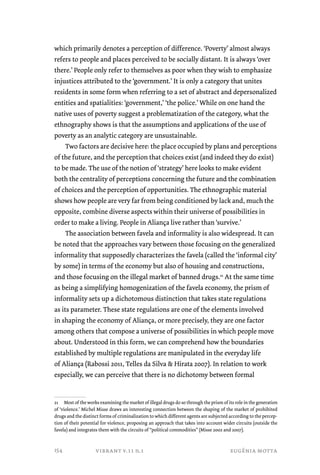

![sociología, economía y etnografía. Antropofagia: Buenos Aires.
ELIAS, Norbert. 1980. Introdução à sociologia. Braga: Edições 70.
FEIJÓ, Carmem Aparecida & VALENTE, Elvio. 2003. “Estatísticas domiciliares
e políticas públicas: uma discussão sobre os conceitos de família e
domicílio”. Ensaios FEE, 42(2): 547-572.
FORTES, Meyer. 1971. “Introduction”. In: Jack Goody (ed.), The developmental
cycle in domestic groups. Cambridge: Cambridge University Press.
FOUCAULT, Michel. 2008 [1977-8]. Segurança, território e população (Curso no
Collège de France, 1977-1978). São Paulo: Martins Fontes.
GARCIA JR., Afrânio Raul. 1975. Terra de trabalho. MA Dissertation, PPGAS/
Museu Nacional/ UFRJ.
GONÇALVES. Rafael Soares. 2012. “Da política da ‘contenção’ à remoção:
aspectos jurídicos das favelas cariocas”. In: Marco Antônio Mello et al.
(ed.), Favelas cariocas ontem e hoje. Rio de Janeiro: Garamond. pp. 253-277.
GUEDES, André Dumans. 2011. O trecho, as mães e os papéis: movimentos e
durações no norte de Goiás. PhD thesis, PPGAS/ Museu Nacional/ UFRJ.
GUÉRIN, Isabelle. 2002. “Le sexe de le la monnaie”. Le Journal des
Anthropologues (La dimension sociale de la monnaie), 90-91: 88-103.
GUYER, Jane. 2004. Marginal gains: monetary transactions in Atlantic Africa.
Chicago: The University of Chicago Press.
HEREDIA, Beatriz. 1979. A morada da vida. Rio de Janeiro: Paz e Terra.
IBGE. 2011. Censo demográfico 2010. Aglomerados subnormais. Rio de Janeiro:
vibrant v.11 n.1 eugênia motta
IBGE.
IPEA. 2010. “Intervenção sociourbanística no Complexo do Alemão”. In: Brasil
em desenvolvimento: Estado, planejamento e políticas públicas. Brasília: IPEA.
pp. 713-734.
IPEA. 2013. Histórico fundiário e de urbanização do Complexo do Alemão. Relatório
de pesquisa. Mimeo.
LÉVI-STRAUSS, Claude. 1991. “Maison”. In: P. Bonté; M. Izard (orgs.),
Dictionnaire de L’Ethnologie et de L’Anthropologie. Paris: PUF. pp. 434-436.
LEWIS, Oscar. 1961. Antropología de la pobreza. Cinco famílias. Mexico: Fondo de
Cultura Económica.
LOMNITZ, Larissa Adler de. 1989. Cómo sobreviven los marginados. Mexico:
Editores Siglo XXI.
MARCELIN, Louis Herns. 1996. A invenção da família afro-americana: família,
parentesco e domesticidade entre os negros do Recôncavo da Bahia, Brasil. PhD
156](https://image.slidesharecdn.com/v11n1-140831205434-phpapp02/85/Vibrant-Ethnographies-of-economy-ics-156-320.jpg)
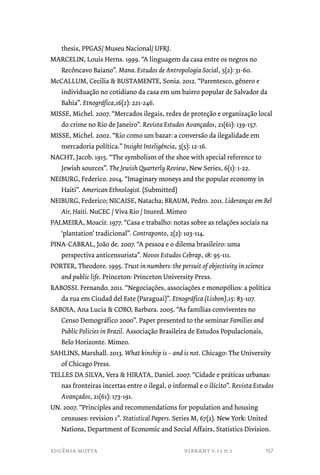




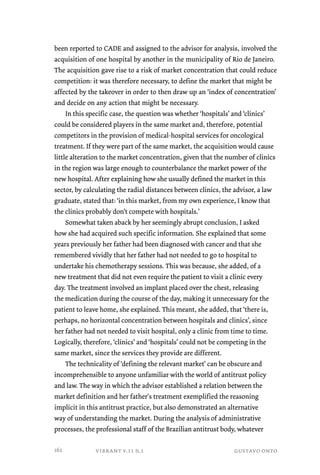
![their academic background, frequently draw on personal or lived experiences
(which may be their own personal experiences or the experience of others
known to them) to help them infer particular characteristics of markets,
sectors, industries or companies – i.e. the economy. These experiences
lived by advisors, commissioners or technical assistants – which, I argue,
can be conceived as ways of knowing or assessing the economic world –
are used alongside the official practices of knowledge production typical
of administrative law. Lived experiences may be drawn upon either as a
complement to official practices or as a way of questioning them. Turning to
examples such as the one presented above, my goal here will be to describe
these intuitive, experiential, ‘lateral’ knowledge practices (Maurer, 2005;
Riles, 2011), which permeate the analysis and judgement of cases, in order
to reflect on the interpretative tools regulators use. I conclude that market
experiences are relevant elements in comprehending market expertise and
market constructions.
The Brazilian antitrust agency2, CADE, where I undertook the research
leading to this article3, acts in accordance with principles and methods
commonly used by antitrust agencies world-wide. This autonomous legal
body (autarquia4) which operates under the auspices of the Ministry of
Justice, is responsible for enforcing antitrust law and policy in Brazil.
Antitrust can be defined as a ‘set of policies and laws designed to ensure
that competition in the markets is not reduced in a way that diminishes
economic well-being’ (Motta, 2004:30). Antitrust bodies across the world
base their decisions on the assumption that competition5 in markets is
2 Strictly speaking, CADE is not an ‘agency’ under the specific legislation governing regulatory agencies – I
use the term here as a more convenient way referring to ‘autonomous administrative bodies’ (see footnote 4
below).
3 I conducted the ethnographic research over a two-year period at the offices of the Brazilian antitrust agency,
in Brasilia, as part of my doctoral thesis in Social Anthropology at the National Museum (Federal University
of Rio de Janeiro). The research involved observation of the knowledge practices needed for the investigative
proceedings relating to competition law and included, for one semester, my active participation as a technical
analyst for CADE’s General Superintendence.
4 According to Meirelles (2010:380): ‘Autarquias are autonomous administrative bodies, established by specific
laws, legally defined as a domestic government bodies, with their own assets and specific state powers [...] these
bodies are self-managing, in accordance with laws issued by the entity responsible for creating them.’
5 The concept of competition is perhaps the most ambiguous concept in antitrust analysis, despite being a
central notion in said field. Economic theory is not unanimous on the definition of competition for the purposes
of antitrust policy and, consequently, competition is defined in a variety of forms for different analytic purposes.
See Davies (2009) on the potential differences in the concepts of competition applied by antitrust agencies in the
United States and the United Kingdom.
gustavo onto vibrant v.11 n.1
163](https://image.slidesharecdn.com/v11n1-140831205434-phpapp02/85/Vibrant-Ethnographies-of-economy-ics-163-320.jpg)
![economically advantageous for consumers and for the national economy as a
whole. Competition is presumed to enable consumers to purchase products
at lower prices and to make companies more innovative and productive
(Forgioni, 2013). Antitrust policy, which is present throughout most of the
industrialized world in a remarkably similar manner, is an ever-increasingly
important feature of the Brazilian government’s economic policy. Starting
in the 1990s, new competition laws have been introduced seeking to bolster
anti-inflationary measures (Onto, 2009). Policymakers consider antitrust
policy to be an essential feature of an open modern economy, effectively
guaranteeing one of Brazil’s constitutional principles: free competition
(Salgado, 1995).
The Brazilian antitrust body is responsible for the filing, investigation,
prosecution6, and judgment of administrative proceedings relating to
competition law. During an investigation, the agency generally seeks to
gather legal-economic evidence for use in the administrative proceedings.
The investigation commonly includes the analysis of documents and
interviewing or consulting relevant individuals, companies, political
authorities and entities in the public or private sector. The agency may
apply for search and seizure warrants in order to inspect the headquarters
and other premises of the companies under investigation, and seize objects,
papers, computers, etc. All these measures are aimed at the gathering of
the evidence needed to determine the veracity of allegations of potentially
anti-competitive behaviour or to determine whether a merger might lead to a
possible economic harm for consumers or competitors.
These administrative procedures or practices are designed to gather
information on the specific characteristics of the markets, companies and
consumers involved or affected in the case. The many factors analysed
include, for example, information on the respective revenues of the relevant
market players, the start-up costs that a new player must incur in order to
6 Instrução [investigation] refers to the set of legal formalities and level of information needed for a case to
reach a state where it can be judged. According to the legal expert Hely Meirelles (2010:742): ‘investigation is
the fact-finding phase, involving the production of admissible evidence by the plaintiff in punitive processes,
or additions to the initial evidence in control and licensing processes: this evidence ranges from testimonies
from the parties involved, examination of witnesses, personal inspections, technical reports, to the gathering
of relevant documents. In punitive proceedings, responsibility for the investigative measures rests with the
prosecuting authority or commission, while in the other kinds of processes it lies with the parties who have
an interest in the decision concerning the object of the case, through direct presentation of evidence or official
request for its production through regulatory procedures.’
vibrant v.11 n.1 gustavo onto
164](https://image.slidesharecdn.com/v11n1-140831205434-phpapp02/85/Vibrant-Ethnographies-of-economy-ics-164-320.jpg)
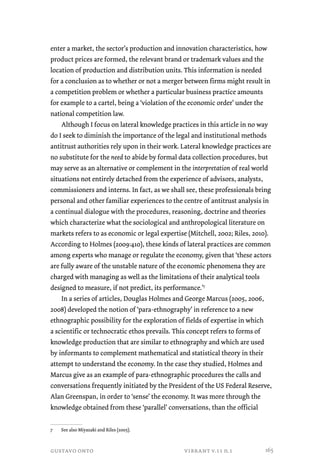


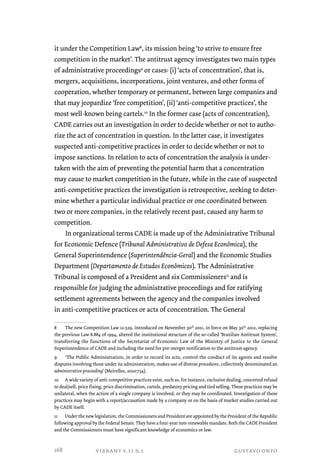
![Superintendence (SG) is headed by a General Superintendent and two
Vice-Superintendents, and is responsible, amongst other things, for
commencement of ex-oficio proceedings and the investigation of all
proceedings, referring them to the Administrative Tribunal to be judged,
whenever necessary. The Economic Studies Department (DEE) produces
studies and economic reports to assist the analyses of the SG and the
Tribunal.
The analysis of ‘acts of concentration’, on which I focus in this article,
follows the filing of a petition by companies requesting approval for the act
of (market) concentration, or ‘operation’ as these acts are called. Under the
new Competition Law, this request is obligatory and the failure to present
the operation to CADE in time may lead to the imposition of heavy fines
on the companies.12 This means that the companies cannot combine their
operations administratively or legally without CADE issuing a final report of
approval. The initial petition, drafted by legal representatives of the parties,
is accompanied by detailed information on the companies taking part in the
operation and the markets in which they participate. CADE’s employees use
this information to begin their analysis.
Under the former Competition Law (8.884/94), companies had to
send notifications of their acts of concentration to the Secretariat for
Economic Monitoring (SEAE) of the Ministry of Finance, which carried
out the investigation of the process and sent a ‘technical report’ to CADE
for judgement by the plenary. At the Plenary Council, if the Reporting
Commissioner deemed it necessary, a complementary investigation could
be undertaken to obtain additional information on the operation. Under
the new legal system, the SG is responsible for the analysis of the acts of
concentration and, in many cases, for making a final decision as to whether
or not such acts may be authorized. In cases which the SG considers to be
complex13, SG staff will draft a report and submit the issue to the Tribunal.
12 In relation to acts of concentration, Article 88 of the law states: ‘The following are to be submitted to CADE
by the parties involved in the operation of acts of economic concentration in which, cumulatively: I - at least one of
the groups involved in the transaction has registered, in the last balance sheet, annual gross sales or total turnover
in the country, in the year preceding the transaction, equivalent or superior to four hundred million reais (R$
400,000,000.00) [approximately 168 million dollars]; and II - at least one other group involved in the transaction
has registered, in the last balance sheet, gross annual sales or total turnover in the country, in the year preceding the
transaction, equivalent to or greater than thirty million reais (R$ 30,000,000.00) [approximately 13 million dollars].’
13 The classification of a case as ‘complex’ tends to be related to a higher likelihood of the operation causing
a ‘competition problem’ in the market under analysis. As a result the Tribunal often deals with the potentially
gustavo onto vibrant v.11 n.1
169](https://image.slidesharecdn.com/v11n1-140831205434-phpapp02/85/Vibrant-Ethnographies-of-economy-ics-169-320.jpg)


![The analytic model presented above, which is based on the U.S. Federal
Trade Commission merger guidelines16, presents an outline or framework
for the analytical activity of bureaucrats inside the antitrust agency, by
illustrating, for the purposes of accountability, what they do (or should do)
when they analyse a case. The guidelines also enable a series of agents outside
those agencies to undertake their functions in line with the activities of the
antitrust body17. These external agents include the ‘business community’ and
the ‘antitrust practitioners’, that is the lawyers and economic consultants
who need to ‘speak the same language’ as the antitrust body, which requires
them to be capable of evaluating market concentrations in a similar
way (Onto, 2009)18. That said, it is worth noting that the techniques and
procedures described in the guidelines, whilst frequently adopted, are not
necessarily required in every merger investigation. The extent of their use
depends on the needs and specific characteristics of the case analysed.
While the merger guidelines point to the economic reasoning underlying
the analysis of the cases by the Council, another set of documents –
resolutions, directives, flowcharts, legal texts – describe how this analysis is
(or should be) undertaken in practice – i.e. the formal and legal procedures
for carrying out the analysis.19 Generally (and formally) speaking, CADE’s
16 The U.S. merger guidelines are widely relied upon as a reference for other countries’ merger guidelines,
given that the Federal Trade Commission (FTC) and the Department of Justice (DoJ) are considered by antitrust
experts to be among the most efficient and technically sophisticated antitrust agencies in the world. As one
bureaucrat at the Brazilian antitrust body said to me: ‘we are living in an environment in which the wealthier
economies dictate antitrust “best practices”… so, consequently, as you can see, Brazilian analytic practices and
procedures are now starting to become part of world’s best practices and are being praised by the OECD and ICN
[International Competition Network]’.
17 A report on merger guidelines produced by different antitrust agencies worldwide contains the following
description: ‘Guidelines set out how authorities intend to apply the laws and regulations in their respective
jurisdictions to the cases that come before them. Guidelines are important not only for deliberation on those
cases but also for obtaining consistent results in law enforcement. They might influence which merger proposals
are made in the first place and they are a mechanism for the authorities to be transparent about the operation of
the policy, and to be held to account for its proper implementation.’ (ICN, 2004)
18 In the case of the U.S. and other jurisdictions where investigative proceedings and trials are conducted by
separate institutions, the guidelines serve the purpose of educating judges in antitrust economic reasoning. Courts
that try antitrust cases are expected to be able to follow as closely as possible the modes of reasoning described by
antitrust agency’s guidelines, although this does not always happen, in practice (see Hovenkamp, 2005).
19 Comparing the merger guidelines with the other documents produced by the agency allows us to explore
one of the possible modalities of the relation between law and economics within antitrust agencies. These agency
documents describe a relation in which economics (and ‘the economy’) comprises the content of the analysis
and law comprises the form in which the analysis must be performed. According to one economist, also a
CADE employee: ‘In antitrust, the law adopts an economic criterion of legality. Moreover, while the legitimizing
principle – the promotion of competition and efficiency – is economic, the means are legal and institutional.
vibrant v.11 n.1 gustavo onto
172](https://image.slidesharecdn.com/v11n1-140831205434-phpapp02/85/Vibrant-Ethnographies-of-economy-ics-172-320.jpg)

![point of view of legal advisors and commissioners, on the production of
knowledge concerning markets, their agents and their transformations.
My doctoral research at the Brazilian antitrust agency began in March
2012, but it was only from September of the same year that I was able to
follow the work of three advisors and two interns at the office of one of the
agency’s commissioners. For six months I accompanied, as an observer, the
work carried out at this office. Apart from the commissioner, who had a PhD
in Economics, and the head of the office (a psychologist by training), the
other employees were all Law graduates or undergraduates. Furthermore, the
advisors in question, who in this case had only been working at the agency
for a few months, did not have any specific training in antitrust policy and
legislation. They were learning, almost at the same time as myself, how to
carry out a competition analysis.
When I mentioned my interest, as an ethnographer, in understanding
how analyses and judgements were carried out at the antitrust agency,
the advisors and commissioners would immediately point to textbooks,
decisions, guidelines and the internal regulations as a broad description
of the work that they did. As they well knew and warned me, however,
these various forms of guidelines merely introduced me to a set of
practices, theories and questions that might assist in the difficult task
of understanding how a concentration of companies was to be analysed.
As David Mosse states (2007), all the variety and contingencies which
relationships, interests, events, expectations and experiences produce in the
practice of public policies are reduced to a minimum when one observes the
description provided in official documents.
While the discourse contained in these documents necessarily
‘suppresses the relational’, ‘refuses significance to the event, the individual
and compromise […] in favour of the rule, instrumental ideas, [and]
professional models’ (Mosse, 2007:12-13), the day-to-day analytical practices
performed by the employees seemed to bring to the fore personal and
professional relationships, making the activity of administering markets less
bound to a certain pre-established rationality of how the economic world
works. Similarly, but certainly not identically, to the modes of knowledge
construction typical of ethnographic practice, the CADE investigative
analysis of markets and their agents also sought to contextualize (or
decontextualize) certain economic relations in order to be able to
vibrant v.11 n.1 gustavo onto
174](https://image.slidesharecdn.com/v11n1-140831205434-phpapp02/85/Vibrant-Ethnographies-of-economy-ics-174-320.jpg)
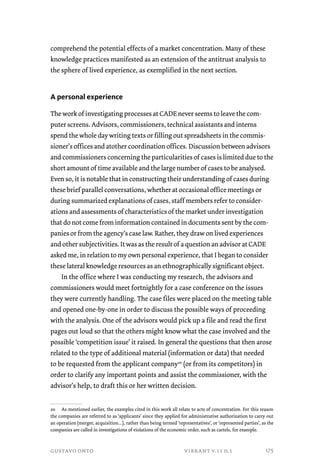
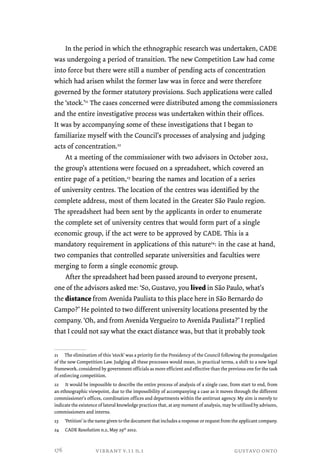

![The question subsequently asked by the advisor took into account
different variables, which could result in a more precise estimate of the
geographic area he wanted to define. The question ‘if you lived in the Paulista
[Avenue] region, would you commute to São Bernardo to study?’ placed
me in the situation of a potential consumer of ‘educational services’ who
lived near Avenida Paulista and would have a decision to make were he to
go to university. What would I (or someone like me) do in this situation, the
advisor wondered? Looking to complement the information obtained from
the first question, what the advisor wanted to know, in economic terms,
was the ‘demand side’ of this market, that is, how a consumer of educational
services and resident in São Paulo’s central region would behave. In reply
I added another piece of information relating to ‘supply’ in this specific
region: I said that the universities were potential competitors in the region of
Avenida Paulista. Hence it was neither necessary nor reasonable to suppose
that a consumer would commute from the Paulista region to São Bernardo (a
suburban area of the city).
Based on these two responses, the advisor could infer, or at least suspect,
that the market he was looking to understand would not include all the
university centres in question. If a consumer would not commute from
Avenida Paulista to São Bernardo to study, as I suggested, the two universities
in question were probably located in different ‘geographic markets’: they did
not therefore compete for students. Furthermore if many other university
centres existed in São Paulo’s central region, then perhaps the competition
between the entire range of universities in the area (and not just the two
universities that were proposing to merger) should be the focus of the
analysis. As explained in the previous section, antitrust analysis must start
by defining a geographic area accompanied by the definition of a product
or service that may be affected by the business concentration. Using the
information I provided, the geographic area of this market could at least be
estimated with greater precision, remaining fairly close to the Paulista region.
My personal experience enabled the advisor to understand, to some
extent, the functioning of the educational services market in São Paulo.
More specifically, it offered an insight into the decision-making rationale
of a typical consumer of these services in the city. By being able to infer
characteristics of consumers and the travel times involved, as well as
being able to ascertain, albeit not conclusively, the presence and extent
vibrant v.11 n.1 gustavo onto
178](https://image.slidesharecdn.com/v11n1-140831205434-phpapp02/85/Vibrant-Ethnographies-of-economy-ics-178-320.jpg)


![be difficult for CADE, with this data, to agree to a concentration that would
place in the hands of one company the control of over ninety per cent of
hospital services in the town of Pequi.
Later on during the investigation of the process, an advisor named Felipe,
who was assisting the Commissioner in this case, visited the hospitals in
Pequi (at the request of the Commissioner), in order to obtain ‘a concrete
notion of the case’. Visits to companies take place in a few cases only, usually
at the request of Commissioners or at the invitation of applicants. According
to the advisor, in the case in question ‘as it happened, the Pequi hospital was
indeed extremely run down, in a much worse state than the other one […] I
recall that the X-ray room was under the staircase and had mildew, it was a
very precarious situation...’ During his visit the owners of the other hospital
had assured him that they intended to modernize the purchased hospital,
bringing it up to the standards of the facility they already controlled.
Faced with this range of information, it was no simple matter for the
Commissioner to reach a final judgment, particularly after Pequi’s mayor
visited CADE to say that the takeover would benefit the region’s health sector.
Despite the mayor’s visit and the findings of the advisor, the
Commissioner ended up rejecting the operation, blocking the purchase of
the hospital. When I asked him, after the ruling why he had come to that
conclusion, he gave an explanation that had not been set out (or even alluded
to) in the written decision:
‘The situation was as follows. My father-in-law was an auditor for Santé [health
insurers]and my father set up a dermatological clinic for my sister there in [the
town of] Uberaba28, there in a small building she [my sister] owned, on one floor. It
so happened that my sister did not have Santé there29. She had Amil [another health
insurance provider], among others, but not Santé. And there you had a problem of ninety
per cent having [the health insurance of] Santé. The population in Uberaba, right?
Almost all the doctors were accredited by Santé. So then I remember the struggle of my
sister, my mother. And my sister trying to speak to my father-in-law: “look into it for me,
I need to be accredited. I’m already accredited with Santé in Belo Horizonte [capital
of the State of Minas Gerais], but I need to be accredited by Santé in Uberaba”. Why?
Because she wasn’t able to get herself accredited. My father-in-law told her: “It’s no use,
28 Uberaba is a relatively small city in the State of Minas Gerais, not far from the town I have called ‘Pequi’.
29 This means that she was not authorized by the Santé health insurance to treat their clients.
gustavo onto vibrant v.11 n.1
181](https://image.slidesharecdn.com/v11n1-140831205434-phpapp02/85/Vibrant-Ethnographies-of-economy-ics-181-320.jpg)
![there are already so many [accredited doctors] there, Santé won’t add any more.” And
they didn’t, she was unable to get accredited by Santé in Uberaba. She couldn’t manage it.
Right? So she had to charge for appointments. Except that in a town like Uberaba, with
a very poor population, if you charge 100 reais, which is really cheap for a doctor, people
just won’t pay it, they will look for a dermatologist covered by Santé’s insurance. What
happened? She stayed open a year and half, two years. And closed. She simply closed the
clinic and went back to Belo Horizonte. Why? Because it wasn’t worth keeping the clinic
open. She closed the clinic because she was unable to keep it going.’
The account transcribed above contains another example of Santé’s
activities in a small town. Although the issue of concentration in Pequi (the
issue that was before CADE) was quite different to what had taken place in
Uberaba (a town in which the Commissioner had once lived), the company
involved was the same. In the case under investigation, Santé sought to
takeover a hospital that, according to Santé lawyers, was not economically
self-sustaining. In the events that affected the commissioner’s sister, what
seemed to be worrying (from a competition standpoint) was the power
Santé had over the provision of medical services, that is, over the doctors
themselves. Despite her father-in-law working for Santé, The Commissioner’s
sister had been unable to obtain the accreditation needed for her to treat
patients covered by the company’s health insurance. The Commissioner’s
explanation continued:
‘When I took the Santé case, this thing did not come to my mind immediately. This
thing came to my mind following numerous discussions with the plenary [meetings
with the other commissioners] and with the lawyers, who were saying that people
would be made unemployed. “Look, if it weren’t for this merger, if it breaks down,
you’ll see people unemployed”. So right then, this came into my mind. I said: “but
what about the doctors who will be made unemployed? There are several who will
become unemployed. Whose unemployment are you talking about?” Then the story
of my sister came into my head. I had also received an email from a doctor in Pequi,
saying: “I’m going to have to leave Pequi, I’ll have to work in Ouro Preto, because
I have nowhere to work. I’m not with Santé, I was with Regional [another health
insurance provider].” That was when I said to everyone in the plenary discussion:
“Listen everyone, what unemployment are you talking about? Because look, if you
allow 90% of the health insurance coverage in two hospitals, the doctors will be unable
to work [...] You can require the applicants to sign a Term of Commitment if you like,
vibrant v.11 n.1 gustavo onto
182](https://image.slidesharecdn.com/v11n1-140831205434-phpapp02/85/Vibrant-Ethnographies-of-economy-ics-182-320.jpg)
![but it won’t work.” So they suggested a fifteen-year TCD30 and I said: “Do what you
like, only you’re generating inefficiency and there will be people who won’t be able to
enter this market. Right?” That was the connection.’
The Commissioner said that it was only during the discussions in
which the argument on unemployment arose that the story of his sister
‘came into his head’. The email from a doctor from Pequi made him realize
the connection between his own family experience and the case under his
analysis. This, for the commissioner at least, added another dimension to the
issue. That the near absence of competition between hospitals would result
in fewer options for consumers was just one of the possible effects of this
merger. He became aware of another market: the employment market of the
Pequi doctors. This market would also be affected by the merger, and in a way
with which the commissioner was very familiar since he had witnessed the
professional difficulties faced by his sister.
‘Unemployment might affect the X-ray technician, the guy who cleans the hospital, but
here you are making unemployed someone specialized, a doctor. The doctors are left
without options; you close the market for them. I have investigated other closures
which were like that: it was the same case as my sister. More than that, you are not
closing only [the market] for the doctor, you are closing the clinics, because look, what
happened to my sister was that they closed the market of a dermatological clinic, it had to
close […] The haemodialysis clinic did not survive, the oncology clinic did not survive, it
is all integrated, it all depends on doctors referring [the patients]. So when you close the
oncology clinic you lose the cleaners working in the oncology clinic […] so it is necessary
to ponder both things. What type of unemployment are you talking about? We have
to make a choice then. A trade-off between who is going to be made unemployed. The
truth is this: it’s not possible for everyone to keep their jobs. But it is obvious that if you
leave some competition the probability of someone staying employed is higher than
without competition. So I used the experience of my sister, you see?’
As well as the job market for self-employed doctors, there was also the
risk of negative impacts on the clinics that depended on the functioning of
the hospital. The predominance of just one health insurance provider in the
town would make competition between clinics non-existent. The hospitals
30 A TCD (Termo de Compromisso de Desempenho) is a Term of Commitment signed by the applicants and CADE
in order to guarantee a certain conduct by the companies, insuring that market competition conditions are not
transformed after the act of concentration.
gustavo onto vibrant v.11 n.1
183](https://image.slidesharecdn.com/v11n1-140831205434-phpapp02/85/Vibrant-Ethnographies-of-economy-ics-183-320.jpg)
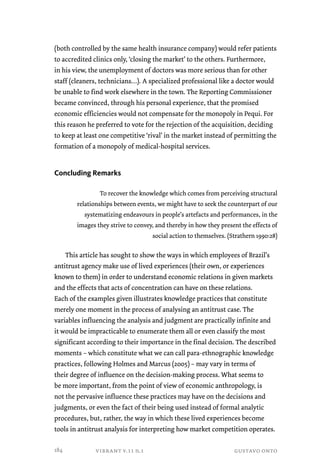
![In a recent ethnography of the Japanese financial market, Hirokazu
Miyazaki (2013) explains how the concept of arbitrage and its principle
of eliminating differences was used by traders as a general interpretive
mechanism. As an exchange strategy, arbitrage involved the buying and
selling of shares with the expectation that the market would change in the
near future, allowing the trader to obtain profits from the alteration in asset
prices. According to Miyazaki, traders did not apply this principle to their
work alone, as a method of profit making, but extended it to their personal
dreams, their future business plans and their analyses of the Japanese
economy. The ethnographer writes: ‘In these extensions of arbitrage as an
interpretive device, Sekai [bank] traders alternately became both subjects
and objects of arbitrage’ (Miyazaki, 2013:33).
In a different, albeit comparable environment, the para-ethnographic
practices of antitrust policy, which construct associations that give
meaning to the case under investigation, show how market competition
is both an object to be managed and, simultaneously, part of the life of
the agency’s employees. These employees may be consumers, residents at
specific locations or simply people who are familiar with the markets in
question, being subjects who have experienced market relations similar or
identical to those that the agency is required to interpret31. Regulators try
to deal with external, imponderable market realities by putting themselves,
whenever possible, in the position of decision-making market participants
(consumers, CEO’s, shopkeepers...). These lateral knowledge practices
place the employees in the position of active subjects of the markets,
experiencing the inner workings of such markets,32 in a manner which is
similar to the activity of the ethnographer who puts him or herself in the
place of the objects studied in order to objectify his or her relations with
them (Bourdieu, 2003).
31 Not all markets are capable of being easily understood through personal experience so, in many cases, this
form of knowledge is not relied upon. Markets such as ‘laminated steel’, ‘piloting’ or ‘fertilizers’, for instance,
generally do not fall within the scope of the life experience of professionals such as economists and lawyers.
32 The employee’s previous professional experience or interest generates a social distribution of expertise
in relation to markets within the antitrust agency. Many of the agency’s advisors or analysts end up becoming
specialists in a given sector. It is common to hear, for example, that some advisor has more background
knowledge of a particular market or sector (due to professional, life experience or even personal interest), which
results in him being called upon to give his opinion about cases falling within his field of knowledge. Companies
can also be known para-ethnographically, since their practices may be part of the experiences of several antitrust
employees. Discussions of brands, products and services are common, along with how they are marketed and
produced, or how certain companies work and what past history and reputation they have.
gustavo onto vibrant v.11 n.1
185](https://image.slidesharecdn.com/v11n1-140831205434-phpapp02/85/Vibrant-Ethnographies-of-economy-ics-185-320.jpg)



![HOLMES, Douglas MARCUS, George. 2005. “Cultures of expertise
and the management of globalization: toward the re-functioning of
ethnography”. In: A. Ong and S. J. Collier (eds.), Global assemblages.
Oxford: Blackwell. pp. 235-252.
HOLMES, Douglas. 2006. “Fast capitalism: para-ethnography and the rise
of the symbolic analyst”. In: Melissa S. Fisher and Greg Downey (eds.),
Frontiers of capital: ethnographic reflections on the new economy. Durham,
NC: Duke University Press. pp. 33–57.
HOLMES, Douglas. 2008. “Collaboration today and the re-imagination of the
classic scene of fieldwork encounter”. Collaborative Anthropologies, 1: 81-101.
HOVENKAMP, Herbert. 2005. The antitrust enterprise: principle and execution.
Cambridge: Harvard University Press.
HOVENKAMP, Herbert. 2010. “Harvard, Chicago and transaction cost
economics in antitrust analysis”. Antitrust Bulletin, 55. pp.613. Available at
SSRN: http://ssrn.com/abstract=1592476. Access on August 15th, 2013.
INTERNATIONAL COMPETITION NETWORK (ICN). 2004. “Report for the
third ICN annual conference in Seoul. April.” Available at ICN: http://
www.internationalcompetitionnetwork.org/uploads/library/doc563.pdf
MACKENZIE, Donald. 2009. Material markets: how economic agents are
constructed. Oxford: Oxford University Press.
MAURER, Bill. 2005. Mutual life, limited: Islamic banking, alternative currencies,
lateral reason. Princeton: Princeton University Press.
MAURER, Bill. 2012. “Regulation as retrospective ethnography: mobile money
and the arts of cash”. Banking and Finance Law Review, 27(2): 299-313.
MEIRELLES, Hely Lopes. 2010 [1990]. Direito administrativo brasileiro. 37a
Edição. São Paulo: Malheiros Editores.
MITCHELL, Timothy. 2002. Rule of experts: Egypt, techno-politics, modernity.
Berkeley: University of California Press.
MIYAZAKI, Hirokazu. 2003. “The temporalities of the market”.American
Anthropologist, 105(2): 255-265.
MIYAZAKI, Hirokazu. 2013. Arbitraging Japan: dreams of capitalism at the end of
finance. Berkeley: University of California Press.
MIYAZAKI, Hirokazu. RILES, A. 2005. “Failure as an endpoint”. In: A. Ong
and S. J. Collier (eds.), Global assemblages. Oxford: Blackwell. pp. 320-331.
MOSSE, David. 2007. “Notes on the ethnography of expertise and
professionals in international development”. Ethnografeast III: ethnography
gustavo onto vibrant v.11 n.1
189](https://image.slidesharecdn.com/v11n1-140831205434-phpapp02/85/Vibrant-Ethnographies-of-economy-ics-189-320.jpg)


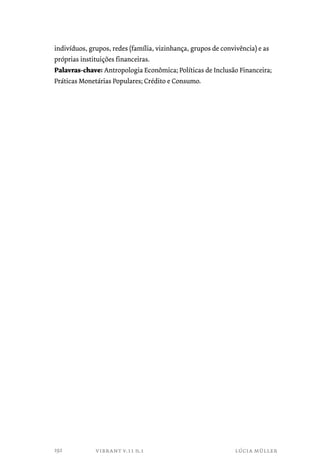

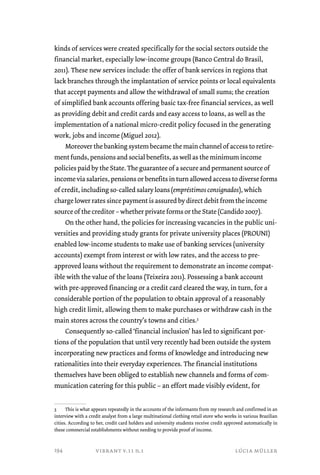


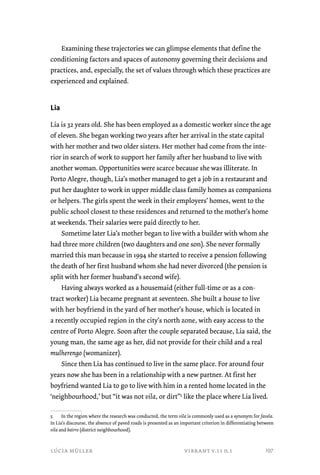

![there were no new deposits. When she discovered the fact, there were already
high charges in arrears. “It seems it even ended up in the SPC [Credit Protection
Service]. I became scared because of the SPC. I’m really frightened of the SPC!7”
After paying the overdue charges, Lia had no wish to remain a client of
the bank in question, despite the offer of a new account, this time without
maintenance charges. Currently she has an account at the Caixa Econômica
Federal, a state bank through which she receives Family Allowance (Bolsa
Família), a government minimum income program analysed in the text by
Eger and Damo, published in the present dossier.
The Family Allowance Program is a direct income transfer program that bene-fits
families living in poverty and extreme poverty throughout the country.
[...] Every month the federal government deposits a sum for families signed up
to the program. The money is withdrawn with a magnetic card issued where
possible in the woman’s name. The amount transferred depends on the size
of the family, the age of its members and their income. Specific benefits exist
for families with children and teenagers aged up to 17, pregnant women and
breastfeeding mothers. (Site of the Ministry of Social Development. Federal
Government. See: http://www.mds.gov.br/bolsafamilia).
Receiving the equivalent of a minimum wage, which in January 2009
amounted to 465 reais (roughly US$ 200), and dividing the household costs
with her partner, Lia does not explain how she managed to qualify as a
beneficiary for the Family Allowance program, which was conditional on
a maximum family income of 120 reais per capita (roughly US$ 52). The
allowance adds 76 reais (US$ 33) to the family revenue but since it is directed
towards her school age child, Lia says that she has opened a savings account
for him where she deposits 50 reais (US$ 21) each month. With the remainder
of the allowance, she gives her son a monthly allowance of 10 reais (US$ 4.30)
and buys what he needs for school (school material and uniform). Lia also
opened a savings account for herself at the same bank in which she deposits
50 reais each month, or more whenever possible, such as when she receives a
Christmas bonus, known in Brazil as the ‘thirteenth [monthly] wage.’
Lia does not use cheques,8 only bank cards. She has one credit card,
7 SPC (Serviço de Proteção ao Crédito): A record system maintained by a private institution that provides associated
traders with data on consumer behaviour in relation to purchases, cheque use, defaults on payments, etc.
8 Until very recently the use of bank cheques was very widespread in Brazil, which changed with the currency
lúcia müller vibrant v.11 n.1
199](https://image.slidesharecdn.com/v11n1-140831205434-phpapp02/85/Vibrant-Ethnographies-of-economy-ics-199-320.jpg)
![which received from the building supply store where she bought what she
needed for the building work on her house.
As I always paid on time, and as I was a special customer, I received their
MasterCard. I didn’t pay anything, just the annual fee, which is eight reais. [...]
The entire year I pay nothing, at the end of the year I pay the six months, and
it’s sorted.
Lia is frequently besieged by operators from other credit card companies
(who call her mobile or work phone) and by financial institutions offering
credit and loans. But she refuses all their offers and explains that she is con-cerned
that the same thing will happen to her that happened to her mother:
she will accumulate debts from loans obtained from financial institutions
and her children will have to help her pay the debts off.
Lia has cards from various stores (Renner, CA, Marisa, Gaston). With
them she can obtain discounts on cash purchases, postpone payment or split
the purchase over several monthly payments and can obtain cash on credit,
to be repaid with interest. Lia says that she only buys shoes in Renner and
CA because they are good quality. Not clothes because she finds them very
expensive. However over the course of the same conversation Lia recounted
a recent purchase at CA of two umbrellas, one for herself and the other
for her son. Each cost R$ 39.90 and she chose to fund the purchase in four
monthly payments of R$ 20.00, since if she had paid in eight instalments as
the seller had suggested, the interest would have been very high.
I have a limit. At Renner its 380 reais for purchases, and 300 reais for cash with-drawals.
[At CA] the limit for me to withdraw money is 890 reais. And I can
spend 2,000 reais on clothes, but how would I pay later? The maximum I spend
is 50 or 70 reais.
Lia also uses a card accepted in supermarkets. This card is regularly
shared with her siblings.
Everyone works and everyone needs money. When things get tight, I have the
Hipercard. Only I have it. I do a big shop [rancho] for my brother and sister. [...]
stabilization and also the popularization of bank cards. By avoiding the need for advance withdrawal of money
from bank accounts, the use of cheques reduced the risk of theft and prevented devaluation of the money since,
generally speaking, banks corrected the value of deposits in accordance with inflationary losses through monetary
correction (on the inflationary process, see Neiburg 2007).
vibrant v.11 n.1 lúcia müller
200](https://image.slidesharecdn.com/v11n1-140831205434-phpapp02/85/Vibrant-Ethnographies-of-economy-ics-200-320.jpg)
![Their shopping comes to 250 reais. They don’t pay in instalments. They buy in
one flat payment and pay me. [...] The card is due on the tenth of each month
and they give me the money to pay on the eighth.
The members of Lia’s family share the problems and also help each other
when dealing with complex questions, such as the problem that surfaced last
Christmas. Lia’s mother, siblings and siblings-in-law decided to get together
during the New Year’s Eve celebrations to plan a joint action: persuade the
husband of one of the sisters to admit himself into a detoxification clinic and
raise the money required to cover the cost of treatment. According to Lia,
during the week her brother-in-law is a hard worker, “a marvellous father and
husband.” But on Fridays he typically dines with the children and then van-ishes,
returning home only on Sundays at night. He even calls his wife with
news. The problem, Lia says, is that he refuses to admit that he is addicted to
cocaine, though he returns home with his nose bleeding and spends, alone,
almost half his salary, leaving his wife (who is a cleaner) and his six smaller
children facing hardships (two older children are already married and inde-pendent).
When she needs money urgently, Lia turns to her mother who, with the
support of her current partner, uses her widow’s pension to help her children
and grandchildren (she also has an unmarried daughter and a grandson who
live in her home and depend entirely on her). Moreover since she does not
know how to read, she does not have a bank account and keeps her money
at home, which makes things much easier. Lia also asks for help from her
sister and neighbour, who herself asks Lia for help when necessary. The credit
offered by cards forms part of this circuit of exchanges. “I take out cash for
my sister, brother... and my mother when she needs something because she
doesn’t have any card, so I take out cash for her.”
Lia controls the expenditure and debts, including on the cards, noting
everything on a sheet of paper stuck on the fridge door.
I do as follows: at CA, I owe four times 45 reais, let’s say. From that I
cross out that I’ve paid three times. When I see that it’s very messy... that only
I understand it, then I start afresh. Once a month, always at the end of the
month, I start afresh.
The notes on the credits and debts relating to the other family members
also end up ‘on the fridge,’ accompanied by the respective dates for
lúcia müller vibrant v.11 n.1
201](https://image.slidesharecdn.com/v11n1-140831205434-phpapp02/85/Vibrant-Ethnographies-of-economy-ics-201-320.jpg)
![payment. If there is any money left after paying her own bills, Lia buys ‘an
Avon’ for herself.
But things do not always run so smoothly. When she decided to move
to another city with her husband, Lia resigned from her job. She was left
without a salary and ‘slipped up’: she made purchases that exceeded the limit
of 900 reais offered by MasterCard.
To obtain enough money to cover what remained to pay on the invoice,
she used her card to ‘take out’ 400 reais at CA, to be paid in five monthly
instalments of 100 reais. “They charged a lot of interest. I was frightened. But,
as I needed it, I took the money. But, thank God, I’ve already paid it off ” [the
MasterCard debt].
In this case, Lia did not turn to help from her family and, although she
had money in her savings account to cover the debt, she preferred to pay the
interest on a second loan.
I took a loan out at CA so I would not have to touch [the savings]. [That
money] I don’t have and it’s there for when I get older and need it. I’m not
going to work after the age of 60. I have a little, I took out the loan because if I
use the saving I won’t replace it.
Elvira
Elvira is 34. She is single and has been working for six years in a beauty saloon
located in the central region of the city of Porto Alegre. She is the eighth of
none children (six girls and three boys). Her father was a technician for a
state company but lost his job when Elvira was nine years old. Afterwards
he was never able to hold down another job for any length of time. He began
to do odd-jobs and ended up having to sell the house where the family lived.
Despite the difficulties, Elvira’s parents tried hard to stay in a ‘slightly better’
district (one traditionally occupied by lower middle class families) so that the
children “would not become contaminated by bad neighbours, drugs, this
and that.” But with the loss of the house, the family moved to a vila, a danger-ous
place, according to Elvira. In addition, her father lost the money from the
sale of the house, which “ended up being taken by a power of attorney.”
This was an important process because I was entering adolescence when I rea-lized
that we no longer lived in such a ‘nice’ district. We went through difficult
vibrant v.11 n.1 lúcia müller
202](https://image.slidesharecdn.com/v11n1-140831205434-phpapp02/85/Vibrant-Ethnographies-of-economy-ics-202-320.jpg)
![times unable to go to school, without food for two or three days, I had to retake
physical education because I had no clothing or trainers to take part in the
course activities and the circle of parents and masters were oblivious to the
fact. This happens a lot at public schools, I passed all the courses and had to
retake physical education.
After finishing secondary education, Elvira took the entrance exam for
the Pedagogy course at the Federal University of Rio Grande do Sul, but
recounts that her name was only included in the second round. As she had
no access to newspapers, she did not hear about this second list before the
deadline for matriculation expired and she lost the opportunity. After this
Elvira continued studying and ‘brazenly’ took the entrance exam for the Law
course at a private university located in the metropolitan region of Porto
Alegre. Elvira passed the exam, matriculated on the course and, to pay the
monthly fee for the two courses she was taking each semester, got a job as a
till worker at a McDonald’s store (earning a minimum wage for four hours
work per day).
At this time, Elvira was still living with her parents and another four sib-lings.
After a year taking courses at the faculty, the family’s needs meant that
“from time to time” she would stop paying the monthly fees in order to pay for
gas and help with other expenses. “I always lived with my sisters, before adoles-cence,
[them] becoming pregnant... This isn’t what I want for my life anymore,”
Elvira recalls. But on this occasion she ended up abandoning the course.
Over this time, her younger sister also “got married, got separated, got
pregnant, ended up a little lost.” To “give her a boost,” Elvira decided to
live with her ‘little sister’ and her four small nephews and nieces (11, 10, 9
and 4 years old) in a low-income condominium located in the Porto Alegre
suburbs, far from the city centre.
Elvira’s decision to move was also influenced by the feeling that, if she
stayed in her parents’ home, she would not receive the support she needed
to continue her studies. Elvira thought that her father failed to support his
children due to his own frustration.
He was Evangelical. As a person he was a bit lost. He had a lot of difficulty
accepting himself, accepting the children, seeing his children studying and
growing. He was a very intelligent and well-educated person. He was raised
without a mother and so on. He was self-made. He is one of those people who
lúcia müller vibrant v.11 n.1
203](https://image.slidesharecdn.com/v11n1-140831205434-phpapp02/85/Vibrant-Ethnographies-of-economy-ics-203-320.jpg)
![understand many things and many subjects, but lacks a university education,
he has nothing. He was always like that. In this regard he inspired me a lot. I’m
very much like him. Wherever he is and whatever his surroundings, he always
looked to absorb the best [only] he didn’t know what to do with it, and I do
know what to do. I think he didn’t think he was capable, “this isn’t for me,” and
it has a lot to do with the history of racism among their generation. They think
that, because they’re black, they’ll never be more than a worker/employer. My
generation is different and my thinking is different.
Elvira began to help her sister look after her children and, so as to be
able to help with the household expenses, went to work in a beauty saloon
that accepted people without qualifications, since it taught them the trade
(depilation). Elvira has been in the same job ever since.
Two years ago Elvira ‘discovered’ PROUNI (University for Everyone
Program) which is run by the federal government and offers grants for study-ing
in private higher education institutions. The first year that she took
the ENEM (National Secondary Education Exam), which provides access to
PROUNI, Elvira failed to get the grade required to obtain a place.9 The second
year she retook the exam and obtained a ‘reasonable’ grade, which allowed
here to enter a not particularly prestigious private university whose campus
is located in a municipality close to Porto Alegre., A professor from the
institution concerned, one of her clients, told her that competition was less
intense at this university. Elvira resumed her law studies.
For a long time I looked after her children [ her sister’s] when she was unem-ployed.
She told me that I should resume my studies. We would find a way. The
best way that we found was PROUNI, which is a real boon, it means we reach
the end of the month tranquil without having to worry about the monthly fee.
Sometimes I even get scared when I go to matriculate. I’m worried that some-thing
will go wrong.
At home, Elvira sees herself as a role model for her nephews and nieces.
When she gets a good result in an exam at college, she sticks it ‘on the fridge’
so they can see it and feel motivated. “Suddenly there are a load of little tests
from the third, fourth and fifth grades alongside mine,” she recounts.
9 ENEM (National Secondary Education Exam). Performance in this exam is one of the criteria for access to some
public universities and also for entering private universities through the PROUNI grants.
vibrant v.11 n.1 lúcia müller
204](https://image.slidesharecdn.com/v11n1-140831205434-phpapp02/85/Vibrant-Ethnographies-of-economy-ics-204-320.jpg)

![decided to buy a laptop and paid the instalments using her sister’s credit.
To control her expenses, Elvira employs a system:
I don’t use a spreadsheet. I’ve jotted down everything on bits of paper my whole
life. I do as follows [while she talks, Elvira opens her purse and removes little
pieces of paper]: Marisa, what I was going to pay and haven’t paid. This is the
place where I buy clothes on my sister’s card. She has one card and had another
issued for me as a dependent. NET,10 which I’ve just paid, and Serdil, who I was
going to pay today, my dentist. [But] as the gas ran out at home, I couldn’t.
And this is the money from the PIS11 [the second instalment which she had just
received]. And Casas Bahia, for a blessed printer that I bought, 46 reais for each
instalment. The school transport that I pay, which amounts to 57 reais. My com-mission,
where I calculate how much I’m due to receive at the end of the month,
about 150 reais. I do this each week. I’ve got everything noted. Hair is a real grief,
I have to buy relaxer, dye, and buy clothes. You have to look presentable at least.
I end up with various bits of paper stored in my purse. It’s a way of keeping
everything under control. So I open my purse and look at them every day.
Elvira had a student bank account through which she had access to credit
with what she considered a ‘reasonable’ limit. Currently the account is frozen
because her ‘name is blemished.’ A year ago her sister took out a bank loan
for 1,500 reais so that Elvira could pay off various bills that were overdue.
To pay back her sister, Elvira agreed to pay the private transport that her
nephews and nieces use to go to school, something considered necessary
because of the distance and the fact that the route would be very dangerous
for unaccompanied children.
The payment to the transport service provider was made with ten ‘pre-dated
cheques’12 of 150 reais. The problem was that six of these cheques were
10 NET: The cable company providing internet, telephone and TV services.
11 PIS: Here Elvira is referring to her receipt of a wage allowance, equivalent to one minimum wage, paid
annually to all workers employed in public or private companies who receive up to two minimum wages. This
allowance comes from a fund run by the State and formed by contributions from private companies through the
Social Integration Program (Programa de Integração Social: PIS) and from federal, state and municipal governments
through the Public Employee Investment Program (Programa de Formação do Patrimônio do Servidor Público: PASEP).
12 Although legally cheques are considered cash payment orders, in Brazil they are very often used as an
informal mechanism for paying in instalments, including a secondary market of pre-dated cheques. To finance
their debt, the debtor splits the total value between a series of cheques whose dates are distributed over a period
previously agreed with the creditor, who promises to present the cheques at the bank only on the set dates. This
practice is widely accepted and legitimized by the justice system, which considers a trader’s failure to comply
with the agreement a “personal injury.” Over recent years the use of ‘pre-dated’ cheques has declined substantially
vibrant v.11 n.1 lúcia müller
206](https://image.slidesharecdn.com/v11n1-140831205434-phpapp02/85/Vibrant-Ethnographies-of-economy-ics-206-320.jpg)
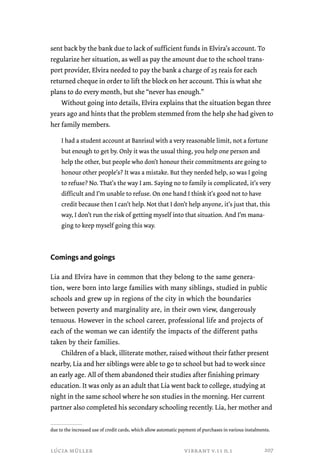

![secondary education and taking a technical course) and to work, this time as
an attendant at a crèche located close to her home.
Elvira, for her part, left her sister’s house and now lives alone in an apart-ment,
in the same region of the city but with better access to the centre
where she works. She pays the rent but the contract is not in her name. The
place is small and unfurnished. Elvira does not have a TV and says that she
does not mind because she has little free time to watch it. What she most
missed was the washing machine. Consequently this was the purchase Elvira
made immediately after moving, paid in instalments.
Elvira says that she is very happy with her new life. She adores looking
after her own things, enjoying the privacy she now has and, above all, the
silence that was missing when she lived in her sister’s house. Now she is able
to concentrate on her studies. Her plans for the future remain the same:
So my next step, which I’ve already mentioned to my manager in fact, is to
abandon my work to do an internship [in the law area], but full-time, since I
cannot graduate as a beautician. I’m going to be the first of my family to com-plete
college. This matters to me a lot, it’s a dream I’ve had since childhood, I
knew that this would free me from poverty. I always knew.
Living with financialization policies
What we can observe in the trajectories of Lia and Elvira is that the possibili-ties
for incorporating financial instruments into the everyday lives of people
from low-income families are closely connected to the growth in the access
to rights (retirement pensions, allowances and benefits) and to income distri-bution
policies, programs for encouraging students to remain in schooling
(Family Allowance) and also policies in support of higher education (PROUNI).
To ensure the maintenance of policies for granting rights, income distri-bution
and inclusion, the State needs to ascertain the applicability and effec-tiveness
of the same: it aims to do so not only through political arguments
but also through studies that measure the economic costs and benefits of
implementing these policies, as well as other studies that attempt to evalu-ate
their social impact. Such studies are undertaken by government research
centres like IPEA (Applied Economic Research Institute) in relation to the
Family Allowance Program:
lúcia müller vibrant v.11 n.1
209](https://image.slidesharecdn.com/v11n1-140831205434-phpapp02/85/Vibrant-Ethnographies-of-economy-ics-209-320.jpg)
![For the Minister of the Strategic Affairs Office (SAE) and the president of IPEA,
Marcelo Neri, one of the program’s main attributes is its cost-benefit ratio.
Expenditure on the Family Allowance program represents just 0.4% of the
Gross Domestic Product (GDP), but each R$ 1 spent on the program ‘generates’
R$ 2.4 in family consumption and adds R$ 1.78 to GDP. [...]
According to data from IPEA, the Family Allowance reduced extreme poverty
by 28% between 2002 and 2012. (Valor Econômico14)
The Banco Central do Brasil (BCB) also looks to produce and publicize
technical evaluation reports on financial inclusion policies:
The publication of this Financial Inclusion Report (RIF) Number 2 is the
result of the BCB’s efforts to deepen knowledge on the issue, consolidating
information on financial inclusion in the country, an essential step towards
the development of public policies with this aim. It is necessary to know the
reality, create parameters and establish targets, indicators and results that can
be compared and evaluated. (Banco Central do Brasil 2011)
The policies designed to promote ‘financial inclusion’ are implemented
through or in partnership with the institutions making up the National
Financial System. The banks participating in this policy work in a highly
competitive globalized market. And even state institutions or those con-trolled
by the state cannot relinquish the dispute for a decent share of this
market. Their work needs to be justified, therefore, in terms of a rationality
based on principles from the market world (Boltanski Thévenot 1991) – that
is, through formal accounting that takes into consideration pre-established
targets, costs, risks, deadlines and results.
Over the last few years, the risk that the population’s level of indebtedness
could exceed the limits judged safe by the financial system has been a recur-rent
theme in the Brazilian press. Despite this fact, public and private finan-cial
agents continue to work with the clear aim of incorporating low-income
sectors of the population into their clientele, especially by providing credit.
Over the same period, the balance sheets of the leading banks operating in
Brazil have demonstrated record results in terms of profitability.
The high interest rates charged in Brazil, even when the lines of credit
involved are subject to government regulations and controls with social
14 Accessed at: http://www.valor.com.br/brasil/3305466/ipea-cada-r-1-gasto-com-bolsa-familia-adiciona-r-178-
ao-pib#ixzz2vaVPskpo – 5/10/2013
vibrant v.11 n.1 lúcia müller
210](https://image.slidesharecdn.com/v11n1-140831205434-phpapp02/85/Vibrant-Ethnographies-of-economy-ics-210-320.jpg)





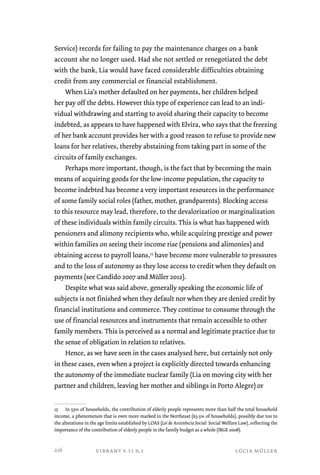

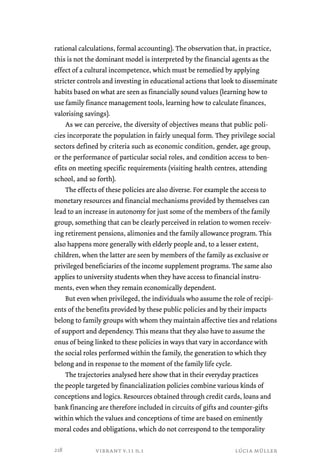



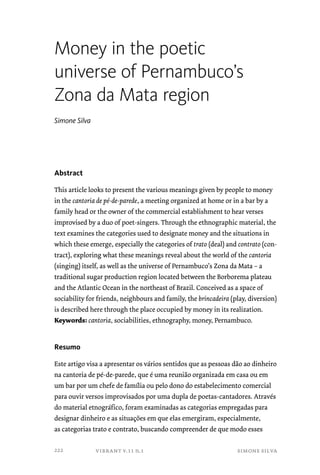
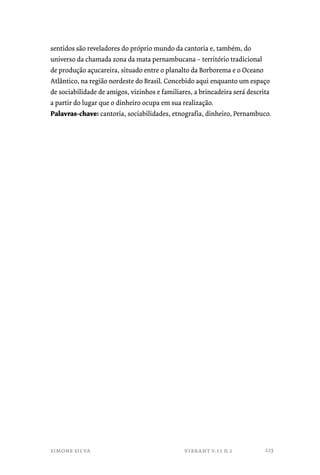


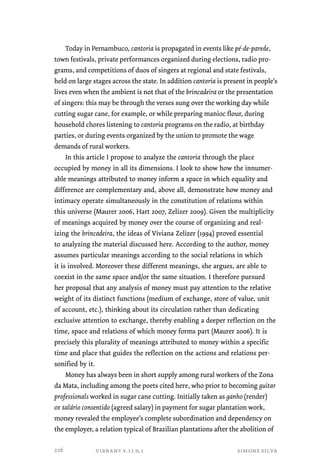

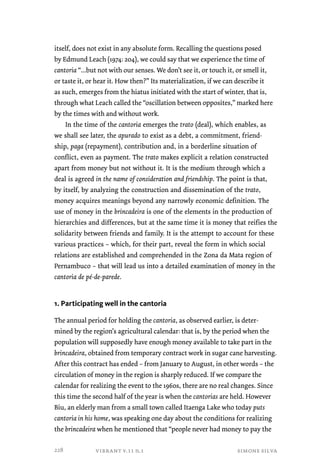



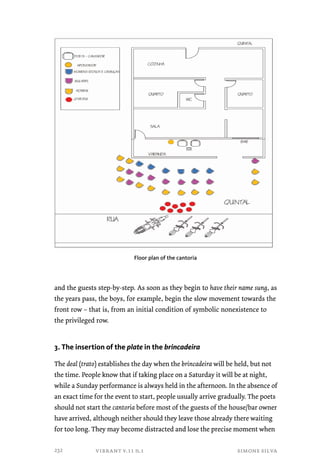


![In most cases the plate is brought by the owner of the bar/house, who
leaves a banknote on it already as his contribution to the poet. This contribu-tion,
like everything else involved in the cantoria, does not have a previously
stipulated monetary value. People know that it serves as a ceiling for the
pagas (repayments) of the guests, hence its value, people told me, should act
as a lure or attraction.
Simone: Can you start the tray with R$ 1, for example?
Biu Ambrósio (a bar owner): Ahh no, Simone. What would the others do
afterwards? If he leaves one real, I’m going to leave one real too. I leave R$
20.00, only they [the singers] give it back to me later.
According to the poets, their handing back of the amount paid by the
bar/house owner recognizes his work in organizing the event. His contribu-tion
is simultaneously a measure of value and the tie of kinship established
between himself and the poet.
Throughout my 2006-07 stay accompanying the cantorias in the Zona da
Mata, I did not see a single guest give a larger contribution than the amount
offered by the owner of the cantoria. When the plate is started with ten reais,
for example, people who have followed the singer for many years can very
often be seen leaving the same amount. In the pé-de-parede, the more time a
person has spent accompanying the singer’s brincadeira, the higher the sum
that he or she leaves is expected to be. For example, the elderly senhor nick-named
Cara de Gato has accompanied the cantorias of Heleno Fragoso for
more than ten years; the singer esteems him greatly, hence it is very unlikely
that he will make a contribution based on the lowest amount of the night, R$
2, for example. Zé Tapera, the oldest fan/client of Manoel Domingues at the
cantoria of Mrs. Maria told me during one of our conversations that when he
is ill, he finds the R$ 5 for the singer and asks someone to go to the brinca-deira
venue to deliver it.8
When the guest, despite following the poet’s cantoria for a long time, is
unable to contribute an appropriate amount, he or she will explain the situa-tion
to the singer:
8 In candomblé, the closer the relation between the child-of-saint and mother-of-saint, for example, the
lower the amount charged should be (Baptista, op. cit.).
simone silva vibrant v.11 n.1
235](https://image.slidesharecdn.com/v11n1-140831205434-phpapp02/85/Vibrant-Ethnographies-of-economy-ics-235-320.jpg)
![Today I am vice-mayor [of the town of Paudalho], director of FETAPE, but I
still sing in my municipality and my electors go there to leave a note for me
in the bowl. One real. They say: “I can’t give anymore, Senhor Beija-Flor, I just
don’t have it.” When the cantoria is over, we drink some beers and rum and the
money is spent right there and then. [laughs] (Poet Beija-Flor, Carpina, 2005)
Some workers will send an apology saying that they can’t go due to a lack of
money; they feel ashamed if the singer sings their name and they can’t give
even one real. It’s a difficult situation, isn’t it? (Beija-Flor, Carpina, 2005)
As well as the length of time accompanying the brincadeira and the
closeness to the poet, expectations concerning the amounts given are also
determined by what is known about the guest’s financial status. The poet
Sinésio Pereira, for example, once told me that he went to sing in the town
of Camaragibe and the then mayor wanted to pay a very low amount for
the praising made to him. The poet, very annoyed and upset, told him
that he did not need to pay. The refusal was provoked not by the actual
amount, but by the fact that everyone present knew that the guest was able
to offer a much higher amount, hence the amount offered was seen as an
insult. Even if the guest is not as famous as a mayor, everyone in this social
universe is aware of everyone else’s status. On various occasions I heard
guests comment in a low voice that the poets should not sing the name of a
particular person because he or she was ‘smooth’ (lisa) – in other words, he or
she had no money to put in the plate.
Although there is no fixed sum, people know that complex poetic modal-ities
– a decassílabo (decasyllable) for example – require a higher contribution.
However the amount offered for a request must always be less than the
amount given for the praising. The value attributed to a verse or song varies
according to the ambient, the degree of intimacy, the relation’s length of time
and the expectations concerning the person invited. After various months in
the field, I decided to make my first request for a verse at the cantoria of Mrs
Brígida and Mr Baixinha, in Feira Nova. I placed the paper with the banknote
on the plate, but I was immediately scolded by the daughter of the house
owner, who told me that five reais was a very large amount. Trying to match
the expectations of the singers concerning my payment, I had failed to taken
into account that I would offend everyone else, since one cannot pay the
same amount or more for a request as most of the guests have paid for their
vibrant v.11 n.1 simone silva
236](https://image.slidesharecdn.com/v11n1-140831205434-phpapp02/85/Vibrant-Ethnographies-of-economy-ics-236-320.jpg)

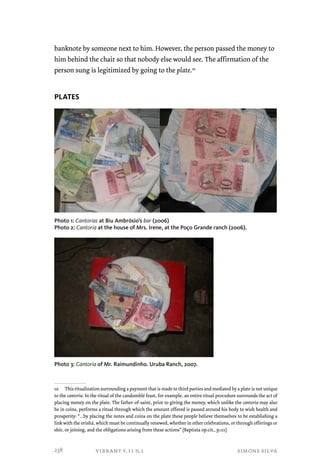
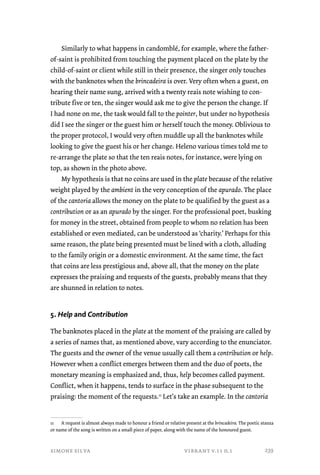

![on the plate was not his own – meaning that the ritual action surrounding his
praising had been invalid12 – he was not authorized to interfere.
Returning to the guest’s argument with the poet Sinésio Pereira, the
man was offended by the poet’s comment about the cantoria in which he had
earned R$ 2,000 since the realization of a cantoria and its later qualification
are elements that determine the prestige of the local area. This qualification
is made in terms of good and weak, which relate on one hand to the quantity
collected by the duo and, on the other, by the quality of the public – whether
they were cantoria fans or not. Stating that a place always gives good cantorias
emphasizes the knowledge and taste for poetry that the local people have
and, above all, reveals the economic potential of the local area concerned. Biu
Ambrósio, for example whose bar is recognized in Vitória de Santo Antão as
a poet hot-spot, acknowledged that poets used to earn more in the past than
today, but at the same time he argues that the present-day earnings in his
own establishment are far from negligible:
Today there are occasions when its very weak. There are some poets who only
come under contract. But today singing isn’t the same as it was in the past, the
money you can earn. You know? But those who come here to sing never waste
their journey. I don’t enter into contact, they come. Sunday cantigas can earn R$
200.00. It’s not much money but it’s not nothing either. Sometimes it’s less. It’s
all the same, two hundred, R$ 150, R$100. (Biu Ambrósio, Vitória, 2007)
This qualification concerning the apurado is not directly connected to the
number of people present at the brincadeira. Some cantorias with more than 60
guests can earn less than one with 30, as Manoel Domingues observed when he
was speaking about a brincadeira full of people where he had performed: “Talk
about hard-earned money?! Can you imagine how much singing we had to do to
apurar [render] R$ 160,00? The whole night, without stopping, until daylight.”
12 This specific situation allows us to return to Austin’s speech act theory (1962: 55) on the following point:
“Besides the uttering of the words of the so-called performative, a good many other things have as a general rule
to be right and to go right if we are to be said to have happily brought off our action.” The author claims that in
cases of failed utterances, like the situation described above, it is not a question of classifying them as false, but as
unhappy. Hence we can conclude that to utter the request for a verse means to have paid for the praising: if this
does not occur then we fall into a situation in which the utterance is a mistake – that is, the procedure invoked is
emptied of authority and thus the act is void and without effect.
simone silva vibrant v.11 n.1
241](https://image.slidesharecdn.com/v11n1-140831205434-phpapp02/85/Vibrant-Ethnographies-of-economy-ics-241-320.jpg)


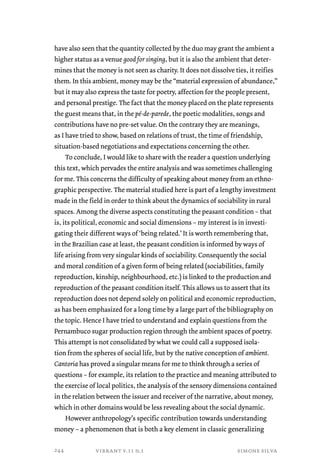





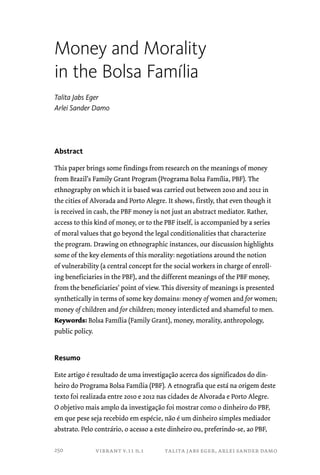

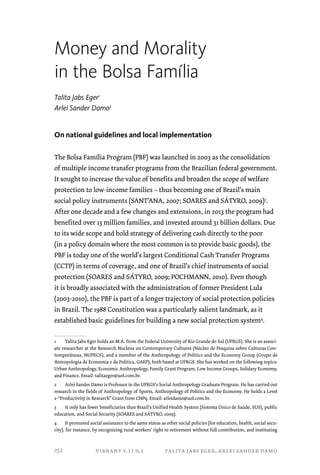


![therefore leaves out the men, as if they were not part of it.
With respect to education, for instance, families must keep children
between 6 and 15 years old enrolled in school, showing minimal attendance
of 85% (for adolescents between 16 and 17 years old this figure is of 75%).
In the domain of health, families make a commitment to keep up with the
vaccination schedule, and monitor the growth and development (through
weight and height) of children under 7. In contrast with the boys, girls over
7 must continue to abide by the health conditionalities. This is also the
case of women of reproductive age (up to 49 years old), and when they are
pregnant and/or breastfeeding, they are required to undergo regular pre-natal
exams and checks on the baby’s health. In the realm of social welfare,
it is the family’s duty to refer children and adolescents under 16 (who are at
risk or who have been removed from child labor by the PETI) to the PETI’s
Coexistence and Bonding Services (Serviços de Convivência e Fortalecimento
de Vínculos, SCFV), where they should maintain an attendance rate of at least
85%. They must also take part on activities offered by the Social Assistance
Reference Center (Centro de Referência de Assistência Social, CRAS) and/
or a Specialized Social Assistance Reference Center (Centro de Referência
Especializada de Assistência Social, CREAS), and re-register every two years
(maximum) by providing all family members’ full documentation.
The values in cash transferred by the BPF are based on poverty thresholds
and family membership (i.e., whether there are pregnant or breastfeeding
women, children and adolescents under 15, or juveniles between 16 and 17).
Thus, families may receive up to three kinds of benefits, whose aggregated
value may range between R$ 32,00 (U$13,6) and R$ 306,00 (U$ 130,3): the
basic, the variable (depending on the number of children), and the youth
variable (depending on the number of adolescents). Families considered
“poor” are not eligible for the basic benefit (R$ 70 [U$ 29,8]), and cannot
receive more than R$ 236 (U$ 100,5)8. Families considered “extremely poor”,
on their turn, may receive the basic as well as the variable benefits – thus
often reaching the maximum possible value of R$ 306 (U$130,3).
During its decade-long existence, the PBF has been the subject of sig-nificant
commentary both in the press (especially critical or complimentary
8 According to World Bank criteria, the Brazilian government considers as “extremely poor” families whose
per capita monthly income is less than R$70 (or U$29.8). The World Bank considers those who survive with less
than one dollar per day as indigents.
talita jabs eger, arlei sander damo vibrant v.11 n.1
255](https://image.slidesharecdn.com/v11n1-140831205434-phpapp02/85/Vibrant-Ethnographies-of-economy-ics-255-320.jpg)

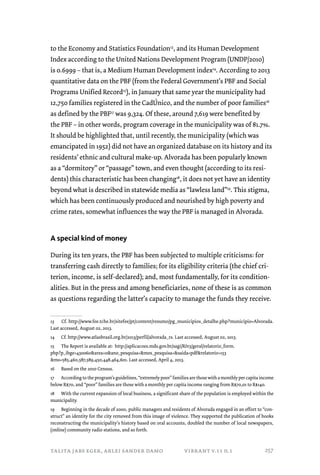







![applicants had to demonstrate that their poverty was worse, truer, more
intense and urgent than the poverty of others. And so it was with Cigana. The
social workers’ task was to find evidence of what Cigana had stated two days
earlier in the CRAS: even though a recipient of the PBF benefit, she still could
not provide for her family. The visit to her home aimed at double-checking
the veracity of her claims. Sitting in front of her, a social worker and a psy-chologist
inquired about her current situation: was she still married? How
many children did she have? Where were they? How many lived with her?
Why did she keep on having children? Did the husband work? On what? What
about her, did she work? Why not? And finally, why did she seek the CRAS?
Cigana answered the questions while trying to find points of entry for
reasserting the precariousness of her living conditions. Between one answer
and another, she would move around the kitchen, opening and closing
cabinets, showing inside the fridge and the stove, showcasing empty pans:
“Come and see! Look, I have nothing here. I’m not lying! Come and see!”.
Faced with the workers’ refusal to take part in the proposed interaction,
claiming that the conversation was still ongoing, Cigana called her three-year
old daughter Bianca. She then pulled the girls’ pants up to the knees, point-ing
to her skinny legs. Cigana needed one basket of staples, and got it. As
we moved towards the street in order to get the staples from the city vehicle
that accompanied us, she asked what was in the basket. “Rice, beans, pasta,
sweet and salty crackers, coffee, wheat flour, soybean oil, sugar and salt”, the
worker replied. Before we said goodbye, we heard “wow, that’s great! I haven’t
had coffee in fifteen days”. She then offered us a last piece of evidence of her
“vulnerability” by immediately handing over to Bianca a package of crackers.
In another occasion, we went to a house headed by a “single mother”, who
had requested to be enrolled in the PBF. The social workers were doubtful
about some of the information she had provided, thus deeming the visit nec-essary.
When arriving at the gate, the agent declared, sarcastically: “This one
thinks she’ll deceive us. Look at her house. It’s obvious that she doesn’t need
it!”. Once inside the house, after a set of questions regarding family, profes-sional
and financial conditions, we wrapped up the visit certain that that case
would be “archived”. According to the social worker, besides the many ques-tions
she asked, she also observed the house, the furniture, the clothes the
mother and the children were wearing – they were among those who “don’t
really need [the benefit], but try to take advantage of it”.
talita jabs eger, arlei sander damo vibrant v.11 n.1
265](https://image.slidesharecdn.com/v11n1-140831205434-phpapp02/85/Vibrant-Ethnographies-of-economy-ics-265-320.jpg)

![the social workers’ perspective, an eloquent demonstration of vulnerability.
Based on the PBF characteristics, and the way the social workers mediate
this public policy, one is led to infer that dispossession is the chief gateway
to the program. The notion of “right” – which, as a rule, accompanies public
policies, as Biehl (2013) has shown for patients in need of special drugs who
access them through legal means – only figures very faintly in the case of
the PBF. The view that the Family Grant cash is a kind of “aid” is much more
common than references to it as a “right” – what suggests an interpretation
of the PBF as pervaded by a moral gift economy.
When asked about how she felt about her “new” social and financial situ-ation,
she affirmed to feel “bad, sad, desolate, and hopeless”. But whenever
she went to the CRAS or to the church (which offers donations), she became
aware that her situation was not “that bad” after all. “There’s people in much
worse off than me. (…) These [women] who go to the CRAS, for instance,
they are always dirty, wearing filthy clothes. They are poorer than I am. (…)
If I walked around as dirty as them, the social workers would believe me”.
In this context, the language of suffering (MELLO, 2011), triggered by the
relationship between beneficiaries and social workers, is aimed not only at
redressing vulnerabilities, but producing them. This is an important point
since, when the social workers were not around, none of our interlocutors
defined themselves as “poor” when asked about their financial condition.
They always attributed that category to other people who would be “worse
off ”, or deployed it when describing what they considered to be indicators
of “poverty” – filth, for instance. The program’s agents, on the other hand,
worked with classifications and denominations that were part of their
everyday practices and life experiences, and according to evaluations about
the appropriate moment to deploy these markers. Different from most of
the beneficiaries with whom we spoke, Maria Rosa did not have a family and
personal history associated with “poverty”, and neither did she have the skill
to claim public services by performing this condition.
Mine, yours, ours: money for “what is necessary”
When asked about when and how they were led to apply for the PBF, all
women referred to a moment when men – her partners or their children’s
father – became (deliberately or not) absent. As a rule, when informed about
talita jabs eger, arlei sander damo vibrant v.11 n.1
267](https://image.slidesharecdn.com/v11n1-140831205434-phpapp02/85/Vibrant-Ethnographies-of-economy-ics-267-320.jpg)
![the program’s eligibility criteria and the equations that determined poverty
line thresholds, some women mentioned strategies of omitting income earned
by their partners (whenever there was one). There was always the possibility of
not mentioning to the agents the existence of male providers, and of making
sure that the visits did not happen at a time when they were at home – thus
avoiding to be caught in case they had lied about it. Two main reasons moved
these women to “conceal” men and their income. Firstly, as Letícia explained,
“they [government agents] may access [her husband] Rubens’ SSN”, and from
then on “see everything” – their “debts”, “wages”, “how much he has in the
bank”, everything! Alternatively, it could be a strategy for obtaining the benefit
without the partner’s knowledge and interference in its management.
Rose, a married 31 year-old mother of two (14 and 16 years old), had been
receiving the benefit for around four years. Her husband worked as an auto-mobile
mechanic. According to her, the benefit was used to purchase clothes
and food: in her words, “not the bulk”28 (referring to basic staple items) but
the “mixture” (“deli items” [cheese, ham], yogurt, meat, etc.). The “bulk”, as
well as the rent, light and water bills, were Gilberto’s responsibility. When
asked about why she did not include his name in the CadÚnico, at first she
said, “I’m not sure why. I just didn’t. The woman asked if we were married or
partners [stable domestic partnership]. If we were married, I’d have to hand
her the documents. But we weren’t, there was no paper. So I didn’t include
him”. After a while, however, she explained that Gilberto would not let her
“touch his money”. He was the one who purchased the household goods, or,
whenever she went along with him to the market, he made the payment and
controlled her influence on what items could be bought. By not declaring her
husband’s name, she therefore secured some “cash of her own”, since, as she
declared, “it makes a difference that the card is under the woman’s name. If
it were under his name, he wouldn’t give me anything. He doesn’t really help
me”. Finally, she accused him of consuming certain products without sharing
them with the rest of the family, since he only took responsibility for “bulk”
items: “he eats everything, the good and the better, outside of the house”.
In this respect, it is should be remarked that, since men were considered
responsible for the “bulk”, the PBF money was regarded as “an aid”, normally
28 It is interesting to remark that this reference to “female money” as opposed to “male money” can be found
in other income transfer programs, such as in Argentina: the Asignácion Universal por Hijo Para la Protéccion
Social”, as described by Hornes (2012).
vibrant v.11 n.1 talita jabs eger, arlei sander damo
268](https://image.slidesharecdn.com/v11n1-140831205434-phpapp02/85/Vibrant-Ethnographies-of-economy-ics-268-320.jpg)
![aimed at purchasing the “mixture” and items for the children: “better” school
materials, clothes, and shoes. Another point in common among female
beneficiaries living in Alvorada was the fact that they all referred to the
program’s cash as money “for the children” – managed by the mothers, but
aimed at catering to the children’s basic needs (food, clothing, and in some
cases, medicine). According to another version, drawn from the ethnography
carried out in the outskirts of Porto Alegre (but not necessarily associated
with geographic factors), the PBF cash was also understood as money “for
the children”. But here, these funds were re-signified according to the logic
of citizenship: they were regarded as children’s rights, and a “reward” for
meeting the program’s conditionalities.
Vera was a young, 29 year-old married (or “living together”, as she pre-ferred)
woman, mother of four children (15, 12, 9 and 6 years old). A resident
of Ilha da Pintada (in Porto Alegre) for around ten years, she worked as a
house cleaner in order to complement her husband’s income. According to
her, Gustavo was the “household head”, because he “works”, “leaves home 5
[a.m.] and only returns late at night”. Since she became a beneficiary of the
PBF around three years earlier, Vera dropped the cleaning service and became
fully dedicated to household chores. She proudly explained that the “PBF
income” allowed her “the privilege of taking the children to school”, and also
of “purchasing clothes and shoes for them”. These items used to be bought
only in Christmas time, but now they could buy them every month, if so
they wished. Gustavo’s job was informal, and that is why she preferred not
to mention his monthly income to the CadÚnico. Every month, she received
around R$150 (U$64) from the PBF, and she believed that this money – which
she defined as both “an aid from the government” and “a right of low-income
citizens” – should be destined to those who do not have the privilege of a
formal job or fixed income. This was precisely her family’s situation upon
enrollment in the program. Vera was unaware that she “had a right to the
Grant” until she was invited for a temporary job as data collector for the
CadÚnico in her neighborhood. Hired by an NGO which was in charge of
registering all those who remained excluded from the program, Vera found
out that the chief criterion was income rather than the fact of being a “single”
or “divorced mother”, as she believed to be the case up until then. This is
exemplary of the gap between the PBF framework and the way it is effectively
appropriated by the eligible and/or beneficiary public.
talita jabs eger, arlei sander damo vibrant v.11 n.1
269](https://image.slidesharecdn.com/v11n1-140831205434-phpapp02/85/Vibrant-Ethnographies-of-economy-ics-269-320.jpg)

![attributed to the hard job as a cleaner, and so decided to stay home in order
to take care of their 6-year old son Pietro. At that time, she was determined to
resume her education, which she had quit when she got married: she enrolled
in evening high school, and made plans to attend college. Valquíria wished to
become a nutritionist. During the day, while her son went to public preschool
and her husband worked at the fish shop, she took care of household chores
and sold cosmetics in order to “enhance a bit” their family income.
For Valquíria, the PBF cash was for “buying Pietro’s stuff ”. She declared
that, in spite of recognizing that money as “her son’s right” and an “extra
income” that the government made available for him since his father’s
income was not fixed, sometimes the family had to use those funds when
shopping for groceries – something that she tried to avoid whenever pos-sible.
Pietro used to come along with her on paydays, and he knew “that’s his
money”: he demanded toys, clothes, shoes, and candy. The month before our
meeting, the boy had “forced” her to “purchase a Ben 10 [cartoon character]
sweatshirt”. She agreed because she acknowledged that the family’s “make
do” in fact belonged to the child. Whenever they were able to pay their bills
without the need to “touch” the PBF money, they put whatever was left in
a piggybank that the boy had got from his grandmother. The money saved
there was used at the end of the year to supplement family funds dedicated
to trips to the beach and “leisure” in general. Like her, Ivânio “does not have
the guts to spend the Grant money”. Once, she recounted, the father needed
R$50 (U$21) in order to pay a late bill. He took Pietro’s piggybank, called him
to the kitchen table, explained what was going on, and “asked to borrow
that amount”. Upset, Pietro threw himself on the floor, cried and showed his
discontent for the proposal; but he eventually agreed, after the father guar-anteed
that that value would be returned by the end of the week. Unable to do
so, Ivânio had to borrow from a co-worker in order to “pay back” Pietro. Even
though this narrative may have been overstated in some respects, it is still
significant. The PBF money may not be entirely exclusive to the child, but is
at least idealized as such.
The cases presented here share a belief that the PBF cash should be
managed by the women, and, provided that there is another source of income
“for the bulk”, it is should be spent on the children’s needs – or, depending
on the family’s finances, by the children themselves. At another level, the
PBF cash appears again as a kind of female money, being appropriated for
talita jabs eger, arlei sander damo vibrant v.11 n.1
271](https://image.slidesharecdn.com/v11n1-140831205434-phpapp02/85/Vibrant-Ethnographies-of-economy-ics-271-320.jpg)
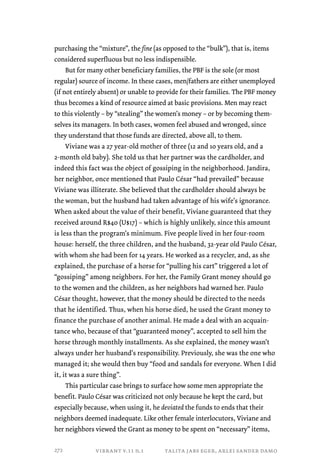

![The relevance of different “poverty” trajectories should also be taken into
account. Even though most of our interlocutors grew up and lived much of
their lives under dire socio-economic conditions, as was indeed the case with
most PBF beneficiaries, there were some exceptions. Maria Rosa, for instance,
“had been” poor for around 13 years. Although she lived in a middle-class
neighborhood in Porto Alegre, and had “everything she needs at home”, she
had to manage her scarce resources very carefully. The apartment where she
lived with her daughter had two bedrooms, kitchen, bathroom, and a large
living room. The furniture was a relic of the “good times”, and was kept
intact because most items were untouched or protected with a plastic cover.
Maria Rosa had discount on her light and telephone bills, but in order to save
further she used to keep the lights off (some of the rooms didn’t even have
light bulbs) and only used the telephone for receiving calls. Her daughter
attended public school, in accordance with the family’s “reality”. Her efforts
to save went beyond the light and telephone bills: neither of them purchased
clothes (including underwear). She also showed concerns about the gas
stove, only cooking what was strictly necessary and privileging foods that
could be eaten raw. According to her calculations, during the winter it was
cheaper to heat their bath water on the stove than using the electric shower.
Commenting on the fact that they only wore second-hand clothes, Maria
Rosa conceded, “there are those who care, who think it’s bad [laughter]. We
don’t mind. I don’t buy anything, not even panties. It’s all second-hand. What
else can I do?”. And she completed, “at least we have a lot of stuff, a lot of
clothes, underwear, socks… some people are worse off than us! We cannot
complain”. Her daughter Gabriela’s school materials were also donations.
Whenever she gained notebooks, Maria Rosa ripped off the used sheets so
that the girl could use the rest of it – as she put it, “we keep on recycling”.
When we talked about the discomfort her daughter experienced at school
– according to her, due to the evident economic disparity between her and
the other students –, she remarked that the girl was laughed at “because of
her panties”. “Last thing”, she recounted, she was bullied for not shaving –
“but beauty salon is superfluous … I don’t go to any”. Showing her hands, she
explained that she painted her fingernails at home. Similarly, she removed
her body hair using tweezers, and Gabriela began to do the same in order
to placate the bullying at school. Just like other beneficiaries, Maria Rosa
believed that the benefit should be directed to her daughter, but she still
vibrant v.11 n.1 talita jabs eger, arlei sander damo
274](https://image.slidesharecdn.com/v11n1-140831205434-phpapp02/85/Vibrant-Ethnographies-of-economy-ics-274-320.jpg)

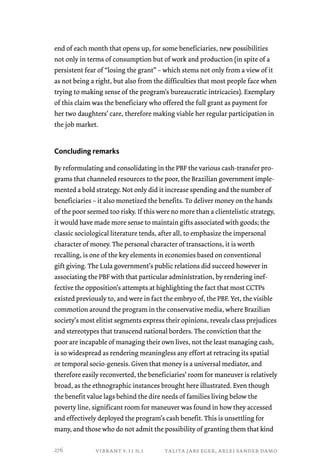



![the PBF money ends up being conflated with other income as well as non-monetary
resources coming from elsewhere. This means that the moral
surveillance over expenses is not directed exclusively at the PBF benefit,
but targets the ensemble of the beneficiaries’ earnings and expenses,
including their behavior.
In terms of the ideas that were discursively manifested, what “must
not” be done with the PBF money seemed well established: alcoholic drinks,
cigarettes, drugs, gambling, superfluous foodstuffs (sweets, soda, unhealthy
snacks), toys (especially when the family was considered very poor), domes-tic
appliances, telephones, lipstick, and so forth. All these items were con-sidered
inappropriate, and even though people living in the neighborhood
arguably purchased them, these individuals were never identified. There
is however one way of spending the Family Grant cash that, even though
not regarded as the most appropriate by the families, was common among
them. Different from the abovementioned items, this was not expressed as
something that “must not” be done; it was, rather, something to be avoided
but which, depending on the family’s situation, may be done. As the women
declared, they (and some of the men) believed that the PBF cash was “for the
children”, and must be spent “on them” and “on their behalf ”. If the pro-gram’s
income was deployed for covering bills from the family at large, such
as gas, food (that is, the “bulk”, or basic staples), medicine, water, light, rent,
etc., it was due to its dire financial condition (which was usually presented
as temporary) and still, an effort was made so that at least part of it was
spent directly on the children.
“It’s for the children’s milk” was a reference as common as “I spend it all
on school materials”, or yet, “that money is all for them [the children]” – even
while those same people also declared that they used the benefit in order to
purchase other products (besides the ones directed to the children) or pay
household bills. It is important to remark that these statements were heard in
contexts where the beneficiaries were being asked about what they considered
to be appropriate ways of spending the PBF benefit. When inquired about what
they actually made of it, however, they would normally mention the follow-ing
items: rent, light, water, food (basic staples), school materials, shoes
and clothes for the children (there was no reference to clothes or shoes for
themselves), and stove gas. These items were mentioned by both the female
beneficiaries and by the social workers, when asked about it.
vibrant v.11 n.1 talita jabs eger, arlei sander damo
280](https://image.slidesharecdn.com/v11n1-140831205434-phpapp02/85/Vibrant-Ethnographies-of-economy-ics-280-320.jpg)
![In other words, the beneficiaries knew exactly what was expected from
them when spending the PBF money, even if the program itself did not
specify it. Fieldwork at Ilha da Pintada (Porto Alegre) lent further credence to
this hypothesis, especially since that locality enjoyed more and better public
services than Alvorada. In the Ilha, there were less agents from other (non-governmental)
agencies taking part in program implementation and the
“monitoring” of beneficiaries – their intervention in the life of beneficiary
families being therefore less forceful and frequent.
When asked about what they considered to be appropriate and inap-propriate
uses of the PBF money, the Ilha residents’ answers did not stray
significantly from those found in Alvorada, especially with respect to the
importance of children. It was there that, for the first time, we heard a PBF
beneficiary affirm that she used the benefit for leisure, “brand” clothes, and
even in order to “save a little”. It is curious however that all these answers
were still associated with the children. The main difference was in the fact
that, for the beneficiaries from Alvorada, the money was “for the children”
(that is, it catered to their needs), while for those in Ilha da Pintada, the
money was “of the children”, or directed to them as a kind of “reward” for
appropriately complying with the program’s conditionalities. When asked
however about what they effectively did with that benefit throughout the
month, answers varied. It was used, for instance, to “take the children to the
movies” when “they carried out the task of attending school” that month – or
yet, “he [the son] knows that the [BF] money is his, and when payday comes
he knows that he can ask for an item of clothing or pair of shoes because I
am obligated to buy it for him”. Some have also declared to have no “guts” to
spend the money on themselves, because it belonged “to the children”.
Although it dispenses with intermediaries between the cash and its final
recipient, the BF grant – understood in this account as money of a “special
kind” – requires the presence of agents from various modalities and spheres
of intervention. Originally thought of as being primarily refracted by gender
and class – money for women and of/for the poor –, this kind of money
eventually appeared as traversed by multiple social relations, based on dif-ferent
modalities of power and hierarchy. Likewise, beyond the meanings
it acquires during the establishment of program guidelines, that money is
continuously re-signified during its journey to the homes of beneficiary fami-lies,
as it enters the complex process of implementation. There, it receives
talita jabs eger, arlei sander damo vibrant v.11 n.1
281](https://image.slidesharecdn.com/v11n1-140831205434-phpapp02/85/Vibrant-Ethnographies-of-economy-ics-281-320.jpg)

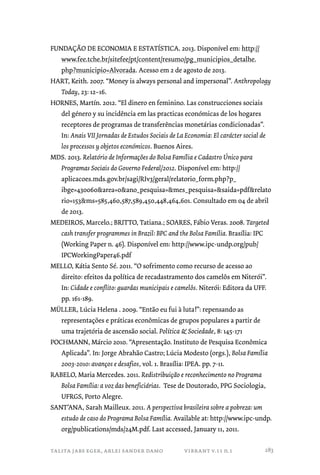

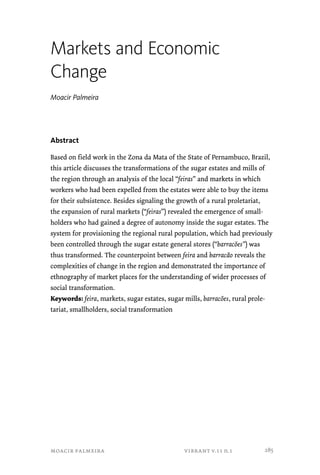
![Markets and Economic
Change1 2
Moacir Palmeira
“I cannot understand how it is possible … with poverty on the increase among
the population, to have in Palmares a market lasting three days, where by two
o’clock in the afternoon on Sunday there is nothing left to sell”. (S., former
market trader, sugar estate manager and barracão assistant).
The process of expulsion of the “moradores” 3 of the sugarcane estates in the
Zona da Mata area of Pernambuco State, which began in the mid -1940s and
increased in pace in the following decades, represented more than merely the
proletarianization of rural workers. It amounted to a new division of labor
which affected both the actual process of production within each agricultural
unit and the distribution and consumption of subsistence products.4
Although, from a technical point of view there was no agricultural
revolution as such, the organization of labor on the sugar estates5 underwent
1 Originally written for an internal seminar at the National Museum in 1971, this article has never been
published. For this edition, we have incorporated the photographic register taken by the author in Palmares, 1971.
The research was part of the project “Employment and social transformation in the Northeast” coordinated by
Moacir Palmeira. For an overview of the context, the theoretical discussions and the unfolding of the research
explained by the author, see Leite 2013:435-457.
2 [Editor’s Note] Four words compose the commercial landscape described in the text: barracão (general store
inside the sugar estates and mills), feira (marketplace, fair), mercado (municipal market hall) and comercio estabelecido
(established commerce controlled by the businessman of towns).The word feira designates an open-air market held
at regular intervals, usually at the same place. It is not only a marketplace but also a particular market-time: a certain
day in the week and the period that the market lasts. On the other hand, the sections of the feira are also called feiras
but qualified by the product, i.e. feira da farinha (flour market). Then, feira could be a street-market, a market time
and a market section.. We chose to keep the word in Portuguese to avoid misunderstandings. We have kept the word
“market” for the title to underline the general discussion that the article proposes: through the ethnography of the
“feiras”, to discuss the place of the market in social transformation.
3 [E.N.] In rural Northeast of Brazil, the term morador -‘dweller’ or ‘inhabitant’- referred to a peasant who lived
in the sugar estate with their family in a morada (a house with a plot of land). The morada established obligations
of the peasant towards their patron.
4 In this work, in the absence of any better phrase, I use the term “subsistence products” to designate those
consumer goods (generally agricultural or semi-processed) defined socially in the area under consideration as
essential to the maintenance of the labor force, and capable, under current conditions, of being produced locally.
5 The term “engenho”, with the disappearance of the old “bangüê” (a watermill “engenho”), continued to be used
vibrant v.11 n.1 moacir palmeira
286](https://image.slidesharecdn.com/v11n1-140831205434-phpapp02/85/Vibrant-Ethnographies-of-economy-ics-286-320.jpg)
![considerable change. The practice of payment for daily work, which was
widespread in the region until the end of the 1930s, was replaced by a more
flexible system of payment by “tarefa” (task) and/or by “conta”,6 which saved
the production unit the heavy costs of supervision. The demands of the labor
laws that had been imposed over the owners during the 1960s encouraged them
to rely on “empreiteros” (contractors) – a kind of “other’s labor” entrepeneurs
– as intermediaries between themselves and their workers,. Furthermore, the
traditional practice of landowners – leasing plots of land to the “moradores”in
return for labor and other services -, was eliminated over time.
In a parallel process, the presence of this “freed” labor force in the
towns of the region was not only responsible for a large increase in the
population of these towns, but also for a radical alteration in their social
make-up. From being towns populated largely by public employees, they
transformed into agglomerations of rural laborers available for work. The
decrease in activity of the sugar-mills at certain times of the year and the
more or less chronic financial crisis which afflicted agriculture in the state
of Pernambuco encouraged part of this population to seek work, temporarily
or permanently, outside the sugar cane production sector. A good part of
this population, however, continued to work permanently on the estates,
either legally or clandestinely (which did not stop them from seeking extra
sources of income in the towns). The most important consequence, however,
was that those workers now had to fend for their own means of subsistence,
previously provided by the sugar mills and estates.7 Over time, a market was
in the region to denote the sugar cane plantations, both those belonging to suppliers and those owned by the sugar
processing plants. [E.N. In the present translation, engenho will appear as “sugar estate” or “estate” and usina will be
translated as “sugar mill”. In the author words, “The term engenho referred in the past to the plantation-sugar mill
complex and, more specifically to the sugar mill itself where the processing was carried out in order to produce sugar.
Today the term is used in Pernambuco, where the last actual engenhos stopped grinding in the 1950’s, to refer to any large
property which plants sugarcane to supply a modern usina. The senhor de engenho, the property owner of an engenho,
is also referred to as fornecedor de cana or sugarcane supplier. Usina is a sugar mill which besides receiving sugarcane
from the senhores de engenho has also its own plantations. Usineiro is the owner of an usina.” (Palmeira 1979:90)].
6 Both “tarefa” and “conta” are methods of payment by productivity. The former, which was in fairly general use
in the 1940s and 1950s, referred to an area of land measuring 25 by 25 “braças” (braça = 2.2 meters) measured out at
the beginning of the week to be worked by the laborer, without further reference to time. At the end of the week, he
would be paid by the number of “tarefas” completed, in accordance with the owner’s assessment of the value of the
“tarefa”. The “conta”, which was generally adopted after the coming into force of the Rural Labor Law, referred to an
area of approximately 10 by 10 “braças” which, in theory, was equivalent to the minimum daily wage of a worker.
7 Through the system of “barracões” – general stores on the estates which had a monopoly of sales within
their areas – or through the letting of areas for growing “subsistence” crops for the workers. [E.N. Through
the text, we use the original word to designate the social configuration that these general stores have inside
the sugar estates and mills].
moacir palmeira vibrant v.11 n.1
287](https://image.slidesharecdn.com/v11n1-140831205434-phpapp02/85/Vibrant-Ethnographies-of-economy-ics-287-320.jpg)
![formed for the products of those “moradores” who remained on the estates.
If traditionally the “moradores” were obliged to hand over the produce of
their plots or holdings to the “barracões” and purchase there what they did
not cultivate themselves, the new “trabalhadores de rua” –street laborers– 8
were unable to make purchases in the “barracões”. Once the “tied system” of
submission had been abolished, the country dwellers acquired an alternative
means of selling their products.
In areas where development of the sugar estates had been slower and
where there was an available “stock of land”,9 there was an incentive for small
scale production, despite conditions which favored plantation expansion and
the actual expansion of sugar plantations during the period. For some of the
former plantation owners, the possibility of returning to sugar cane cultivation
often depended on the splitting up and sale of part of their land. On the other
hand, the sugar mills’ need for working capital seems to have led them to
avoid tying up their capital in land. At the same time, the owners of the sugar
estates, having expelled their workers, found themselves with the problem of
indemnifying those concerned, which was not infrequently resolved by the
grant of land. Some cases saw the paradoxical situation of “moradores” who
had never possessed their own plot of land, but who, once “dismissed form
employment” found themselves in the position of independent agriculturalists
on land leased from their former employer.10 In short, it seems that there was
an opening up of the land market which favored small scale cultivation.
Even though it is difficult to evaluate, the activation of the circuit
of exchange of subsistence products gave rise to an appreciable growth
of “feiras” – open-air markets – in the Zona da Mata. It was this change
which constituted perhaps the principal support for the changes noted.
They “feiras” provided employment opportunities for workers expelled
8 [E.N.] During the research, the expression “trabalhadores de rua” (street laborers) referred to the peasants
living in the small towns of the countryside, who were expelled from the sugar estates or who were waiting for a
new house in other sugar estate. In other words, they were “moradores” who were compelled to leave their moradas
and who are living in town.
9 Cf. Genestoux, 1967.
10 In the north of the Zona da Mata in Pernambuco there is currently a distinction between hereditary leasing
(aforamento) and leasing (arrendamento) and between hereditary tenant (foreiro) and lessee (arrendatário): the tenant
lives on the land which he cultivates, while the lessee necessarily lives elsewhere. It was Vera Maria Echenique
and Luis Maria Gatti who drew my attention to this distinction which they noted in their travels in the region in
February 1971. When I started to process the material I had gathered in the field, I noticed how strictly these two
categories are employed by the rural smallholders and laborers in the region.
vibrant v.11 n.1 moacir palmeira
288](https://image.slidesharecdn.com/v11n1-140831205434-phpapp02/85/Vibrant-Ethnographies-of-economy-ics-288-320.jpg)



![Whilst in Palmares certain traditional forms of landholding in the sugar
plantations had disappeared by the early years of the XX century, the estates
in Carpina milled sugar until relatively recent times, “lavradores” (peasant
farmers)13 are figures from the recent past. Tenant farmers still form a
significant group there.14
Even though, once we get away from narrow municipal divisions such
differences can become quite small, they seem to have some relevance
when we consider the two “feiras”. The shorter distance between the food
producing areas and the marketplaces meant that the presence of direct
producers in Carpina market was greater than in Palmares, that transport
using draught animals was very important, and, perhaps, as the problem of
storage was not so great as in Palmares, the established commerce was of less
importance in supplying the “feira”.
On the other hand, and here there is a lack of material on which to
base conjectures, Carpina, where the “feira” is on Sundays, is a town on
a circuit of marketplaces. The operators who sell manufactured goods
and are known as ambulantes (itinerant traders), are market professionals
(“professionais de feira”) who have following schedule during the week:
Monday – João Alfredo; Tuesday – Itabaiana (Paraiba State); Wednesday –
Nazaré or Limoeiro; Thursday and Friday – no market; Saturday – Goiana
or Paulista; Sunday – Carpina. Palmares, where the “feiras” runs for
nearly three days, does not seem to be linked to any circuit. The sellers
of manufactured items are generally residents of the town and do not
operate at markets in other locations. The most that happens is that
“feirantes” (market trader)-producers operate in two stages: on one day
of the week they go to the market at the nearest locality and on Sundays
they go to Palmares with the remainder of their produce and any products
purchased at these small “feiras”, or, apparently more usually, they take
their produce to Palmares on Sundays and sell the remainder at the
market nearest to their home.
13 [E.N] The word “lavradores”, in the original, has a particular meaning in the region] The “morador” who grew
sugar cane in partnerships.
14 [E.N] The word in the original for tenant farmer is foreiro, which is also a specific social relation inside
the sugar estate. The foreiro is also a morador - he has a house and a plot in the sugar estate - but he has greater
autonomy due to the payment of an annual rent to the estate owner.
vibrant v.11 n.1 moacir palmeira
292](https://image.slidesharecdn.com/v11n1-140831205434-phpapp02/85/Vibrant-Ethnographies-of-economy-ics-292-320.jpg)
![The “Feira” and the “Feiras”
The relative self-sufficiency of the subsistence product circuit seems to be
reflected in the actual division of the “feira”. The “feiras” studied appear to be
divided into well-defined sectors (manufactured goods; handicrafts; meat
and fish; flour and cereals, vegetables, greens and root vegetables; fruits;
crockery), even though certain combinations of products tend to form their
own category.15
It seems to us symptomatic that rural workers and “feirantes”
(market traders), when interviewed both at the marketplace and away
from it, rarely referred to the “feira” as a whole, but only to “the flour
feira”, “the fruit feira” (which at a time when the most common product
was the banana, was known as “the banana feira”), “the meat stands”,
“the fish stands”, “the market”, “the market stalls”. Whilst we do not
have the factual basis upon which to make a systematic examination
of this classification (which is incomplete, because it consists only of
expressions found in the data collected), we should like to draw attention
to the fact that the sections selling regulated products - (meat, charque
(jerked beef ), sugar), are not classified as “feira”, this term being reserved
for those sections where there is some variation in prices and, perhaps,
a greater turnaround of sellers. Similarly, there is a clear distinction
between bancos de feira - market stands (which are large covered stalls or
canvas spread on the ground), and barracas (stalls -a term reserved for the
stalls surrounding the Municipal Market Hall), which are permanent and
controlled by wealthy traders. The latter distinction can be illustrated by
the answer given by one interviewee who was talking about the sale of
cabbages in response to a question from the researcher as to the lack of
variation in prices between the stalls (barracas):
Q. Why is there only one price for everything? Why aren´t the prices different
on other stalls?
A. Because … let’s put it this way, these markets are ready markets. So
the people who go to buy are the same people who want to sell from
those little stalls, so they also buy in that Municipal Market. So you can
15 [E.N] Although cassava flour was the main product, in the “flour feira” and the Municipal Market Hall the
flour section includes cassava, wheat and corn.
moacir palmeira vibrant v.11 n.1
293](https://image.slidesharecdn.com/v11n1-140831205434-phpapp02/85/Vibrant-Ethnographies-of-economy-ics-293-320.jpg)


![vibrant v.11 n.1 moacir palmeira
TABLE IV
Carpina Palmares
1969 1970 1971 1969 1970 1971
Manufactured goods MW MW MW MW MW MW
Flour and cereals Mw Mw Mw M Mw M w
Meat and fish M M M M W MW MW
Handicrafts WM WM MW WM WM WM
Vegetables and greens M=W M=W M=W M=W M=W M=W
Root vegetables M M M M M M
Fruits MW MW MW MW MW MW
Pottery W WM MW W WM M
M – Men; W – Women; w - women within the Municipal Market Hall (or in insignificant
numbers)
MW – more men than women; WM – more women than men; M=W – same number of
men and women
Sellers and Buyers
The variations from one sector to the other with regard to market traders
are so great, that generalizations become difficult. It is certainly true that
there seems to be a certain homogeneity with regard to the end consum-ers,
the large majority of whom are rural laborers in the case of Palmares,
rural laborers or smallholders in the case of Carpina. However, it would be
a simplification to fail to note the visible presence, well publicized by the
vendors, of urban consumers in the manufactured goods, fruit and veg-etables
sections. In contrast to the practice in the “flour feira”, for example,
there are women buyers (usually household employees). In the case of
Carpina, it seems that the presence of consumers from Recife is of some
importance (many of them own “granjas”20 outside the city), especially
for the fresh meat counters in the Municipal Market and in the fruit and
20 [E.N] In Carpina, the word granja (farm) is used to designate small and medium size rural properties farmed
by wage workers and owned by middle and upper class people from the cities (generally from Recife). Most of the
farms are focused on raising poultry. At the time of the research, some of them were beginning to plant sugar
cane, becoming sugarcane suppliers.
296](https://image.slidesharecdn.com/v11n1-140831205434-phpapp02/85/Vibrant-Ethnographies-of-economy-ics-296-320.jpg)







![and smallholders,37 is present in the decisions that are made in each sector:
“Today I brought in 61 bunches of kale. I got there and I told her [a retailer
of green vegetables]: ‘Did you know that the price of my produce has gone
up?’ She said: ‘Why? Because it rained?’ I said: ‘No. Because everything’s
very expensive. So my goods are also now more expensive (…)”.38
Commerce, Feira, Municipal Market, “Barracão”
If the key sector of the market is flour and cereals, as has been suggested,
and if, as is probable, the control of this sector is in the hands of the whole-salers
and the traders of the Municipal Market, everything leads us to believe
that the “price of the feira” (preço de feira) and the “stores’ price”(preço do
comércio) are one and the same thing. This, however, is problematic, because
it pre-supposes an identity, at least of interests, between established com-merce
and the owners of stalls of the Municipal Market. Now, even though
there is a lack of data to support definitive claims, these two groups not
only appear to have very different social origins – “established commerce”
always forms part of the local elites, its members are generally the offspring
of businessmen, and their businesses often have branches in a number of
different towns, while the owners of market stalls are from a humble back-ground,
very often ex-peddlers who have established themselves but who
never operate in more than one marketplace . Their commercial interests
and their attitudes to the market appear to be different. While the estab-lished
commerce maintains that it is going through a crisis, as evidenced
by the number of bankruptcies that have occurred in recent years and by
the increasing presence of businesses from Recife operating in the interior,
as in the case of Palmares, or by stagnating sales, as in the case of Carpina,
market traders seem to be, if not in the process of a rapid expansion, at least
in a financial position to operate a number of stalls and to muster dozens of
vendors for the Sunday “feira”. While stall owners seek to operate by manip-ulating
the prices at the “feira”, established shop owners complain that the
“feira” is a problem because
37 Cf. the publications by the Joaquim Nabuco Institute in Recife: Maciel 1964 and Gonçalves 1966.
38 L., trader in Palmares.
vibrant v.11 n.1 moacir palmeira
304](https://image.slidesharecdn.com/v11n1-140831205434-phpapp02/85/Vibrant-Ethnographies-of-economy-ics-304-320.jpg)
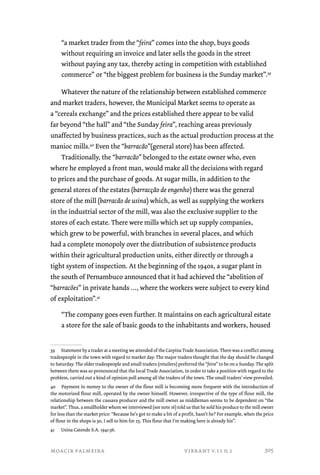


![“They [the “barracão” operator] buy top quality flour [at the cheapest
shop prices] and sell at commercial prices, the market prices being
charged during the course of the week. It’s like this: if it costs 10 thousand
on the market, they increase that price of 10 thousand”.47
This, however, does not prevent rural laborers and smallholders from
continuing to look on “the shops” in general as an alternative to the
“barracão”:
“Buying at the “barracão”? I’m scared of the “barracão”, you understand?
It’s not even worse for my family because God is good. Thanks to God and
to men who are prepared to bargain. Because there in Palmares there is
someone who has a stall … he’s not my boss, he’s my father (…).48
vibrant v.11 n.1 moacir palmeira
Conclusion
About ten years ago a local historian in Pernambuco could say, without fear
of contradiction, with regard to the towns and villages in the wettest part of
the Agreste region:
“These villages, being the nearest settlements to the (swamps) outback,
hold large “feiras”, because the lower concentration of large estates
allows a wider division of wealth: there are fewer rich or poor people and
more people of average means. For this reason, “feiras” such as those at
Camocim de São Felix, Cupira, Cachoeirinha and Capoeiras, despite their
small populations, are much more important than those in the large
towns of the Zona da Mata region, such as Goiana, Nazaré or Palmares”.49
A study of the markets in the Zona da Mata region suggests that this is
no longer the case and that the “feiras” and the market are present even in
the transactions that represent their negation, like the commercial practices
of the “barracão” operator. The growth of the “feiras” in the sugar producing
zone seems to cast a broader transformation, reversing the relationship
between the “feiras” of the Agreste and the Zona da Mata.
47 Idem.
48 T.D., already quoted.
49 Correa de Andrade 1964: 159.
308](https://image.slidesharecdn.com/v11n1-140831205434-phpapp02/85/Vibrant-Ethnographies-of-economy-ics-308-320.jpg)
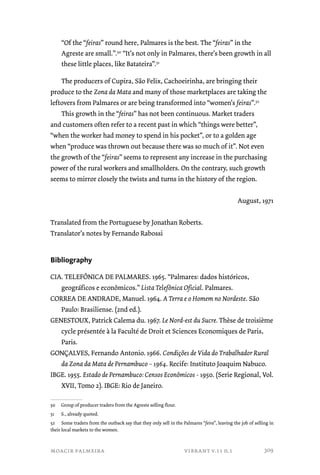
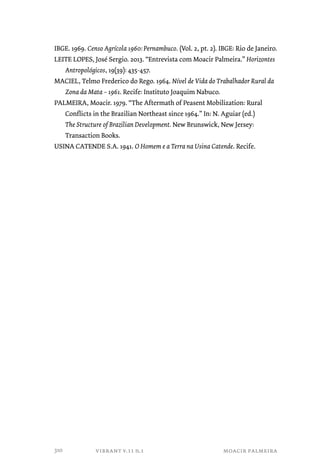



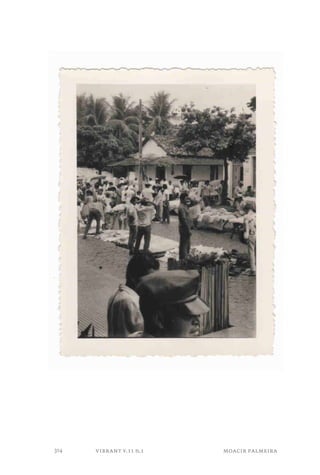






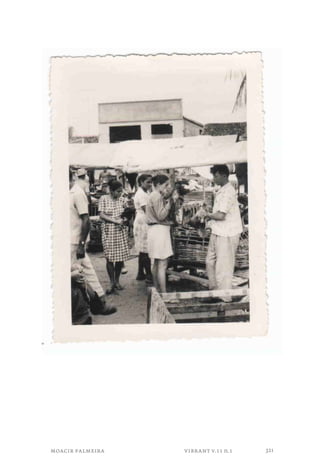
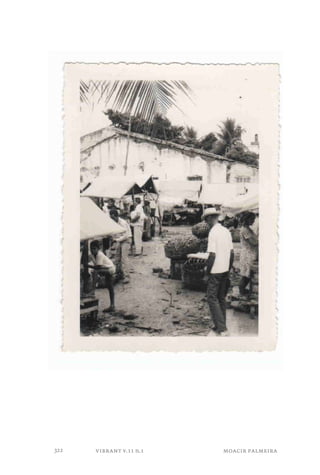


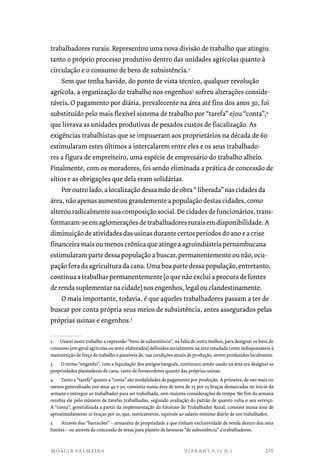
![Abriu-se assim um mercado para os produtos dos “moradores” que
permaneceram nos engenhos. Se o morador tradicional era obrigado “de
direito” ou de fato (pela falta de alternativas) a entregar a produção de seu
sitio ou de seu roçado aos “barracões” e aí comprar o que não produzia, o
trabalhador da rua6 não tem como comprar no barracão e o “morador”, uma
vez ilegalizada (ilegitimidade) a “sujeição”, ganha uma alternativa para a
colocação de seus produtos.
Nas áreas em que o desenvolvimento de usinas foi mais tardio e em que
havia um “estoque de terra” disponível7 a pequena produção foi estimulada,
apesar das condições favoráveis à expansão canavieira e da expansão efetiva
dos canaviais no período. O preço da retomada da exploração da cana por
alguns antigos senhores de engenho foi, muitas vezes, o retalhamento e
venda de parte de suas propriedades. Por outro lado, as necessidades de capi-tal
de giro das usinas parecem tê-las levado a não imobilizarem capitais em
terra. Os senhores de engenho, por sua vez, num segundo momento, expul-saram
seus trabalhadores, viram-se a par com problemas de indenização que
resolveram, frequentes vezes, com pagamento em terra. Em alguns casos
surgiu a situação paradoxal de moradores, que nunca haviam tido sitio, uma
vez na “rua”, tornarem-se agricultores por conta própria em terra arrendada a
senhor de engenho.8 Em suma, parece ter havido uma abertura de mercado de
terras que favoreceu a pequena exploração.
A ativação do circuito de trocas de bens de subsistência traduz-se num
crescimento sensível, embora de difícil avaliação, das feiras da Zona da Mata
que, ao mesmo tempo que se modificam, fornecem talvez o principal suporte
às mudanças apontadas, como fontes de emprego, nem sempre “improdutivo”,
para os trabalhadores expulsos dos engenhos, atuando ao mesmo tempo como
elemento de redistribuição de “riquezas” dentro de um determinado setor da
população; e como centros de distribuição da pequena produção rural.
6 [Nota do Editor. Tal como o define o autor em uma entrevista, “o trabalhador da rua, era o trabalhador expulso
ou o morador entre uma morada e outra, residindo naquelas pequenas cidades do interior.” (Palmeira, em Leite
2013:443).]
7 cf. Patrick Celema rd DU GENESTOUX, Le Nordeste du_Sucre, thèse 3º Cycle, Université de Paris, Paris, 1967.
8 No norte da Zona da Mata de Pernambuco faz-se, atualmente, uma distinção entre aforamento e
arrendamento e entre foreiro e arrendatário: o foreiro mora na terra em que trabalha; enquanto o arrendatário
deve morar necessariamente fora da terra. Foram Vera Maria Echenique e Luis Maria Gatti que me chamaram
atenção para essa distinção que eles observaram em sua ida à área em Fevereiro de 1971. Voltando a manipular meu
material de campo pude então constatar o rigor com que aquelas duas categorias são empregadas pelos sitiantes
e trabalhadores rurais da área.
vibrant v.11 n.1 moacir palmeira
326](https://image.slidesharecdn.com/v11n1-140831205434-phpapp02/85/Vibrant-Ethnographies-of-economy-ics-326-320.jpg)



![Enquanto em Palmares certas formas tradicionais de posse de terra na
zona canavieira foram eliminadas desde o começo do século, em Carpina não
só os engenhos moeram até período relativamente recente, como os “lavrado-res”
11 são figuras de um passado próximo e os foreiros ainda representam um
grupo significativo.12
Ainda que, se sairmos dos limites das estreitas divisões municipais, essas
diferenças possam ser minimizadas, elas parecem ter alguma consistência
quando se consideram as duas feiras. A menor distância entre os centros
produtores de alimentos e as feiras fazem com que a presença de produtores
diretos na feira de Carpina seja maior do que em Palmares, com que o trans-porte
animal tenha uma importância grande e talvez, não sendo tão grande
o problema de estocagem quanto em Palmares, que o grande comércio tenha
uma menor importância no abastecimento das feiras.
Por outro lado, e aqui nos faltam elementos para qualquer conjectura,
Carpina, cuja feira se restringe ao domingo, é uma cidade em um circuito de
feiras. Os intermediários que vendem bens manufaturados, conhecidos como
“ambulantes”, são profissionais de feira que fazem durante a semana o seguinte
trajeto: segunda-feira, João Alfredo; terça-feira, Itabaiana (Paraíba); quarta-feira,
Nazaré ou Limoeiro; quinta-feira e sexta-feira, parada; sábado, Goiana ou
Paulista; domingo, Carpina. Palmares, cuja feira dura quase três dias, parece
estar desligada de qualquer ciclo. Os vendedores de manufaturados são em geral
pessoas residentes na cidade e que não feiram em outros locais. O máximo que
acontece é feirantes-produtores feirarem em duas etapas: um dia na semana
feiram na localidade mais próxima e domingo vão a Palmares levando o que
sobrou da sua produção e alguma produção comprada nessas pequenas feiras
ou, o que parece se mais comum, levando sua produção para Palmares no
domingo e vendendo as sobras na feira mais próxima de sua residência.
A Feira e as Feiras
A relativa autonomia do circuito dos bens de subsistência parece revelar-se
na própria divisão da feira. As feiras estudadas apresentam-se ao observador
11 Moradores que plantavam cana em parceria.
12 [Nota do Editor. Tal como o define o autor em uma entrevista, “Dentro dos engenhos, ao lado do morador
comum, havia a figura do morador foreiro, que explorava o seu sítio com alguma autonomia, pagando um foro
anual.” (Palmeira, em Leite 2013:443).]
vibrant v.11 n.1 moacir palmeira
330](https://image.slidesharecdn.com/v11n1-140831205434-phpapp02/85/Vibrant-Ethnographies-of-economy-ics-330-320.jpg)



![Vendedores e compradores
São tão grandes as variações de um setor para o outro no que diz respeito aos
agentes de troca na feira, que se tornam difíceis as generalizações.
É bem verdade que parece haver uma certa homogeneidade no que diz
respeito aos consumidores finais, trabalhadores rurais e sitiantes no caso de
Carpina . No entanto, seria uma simplificação deixar de assinalar a presença
visível, e proclamada pelos vendedores, de consumidores urbanos nos
setores de manufaturados, frutas, verduras e legumes. Ao contrário do que
ocorre na “feira de farinha”, por exemplo, há mulheres comprando (em geral
empregadas domésticas). No caso de Carpina, parece ter alguma importância
a presença de consumidores de Recife (muitos dos quais são proprietários
de “granjas” nas imediações da cidade),17 especialmente nos boxes de carne
verde no mercado municipal e nos setores de frutas e “verduras”. Para outros
produtos, entretanto, esses consumidores parecem dar preferência ao super-mercado
da cidade.18
Quanto aos vendedores, só a presença de intermediários é a regra, as
diferenças entre esses intermediários são muito grandes para que possamos
considerá-las em conjunto. O cadastramento da feira de Palmares revelou que
não apenas o comparecimento de produtores diretos ou de intermediários é,
como se poderia esperar, muito maior nos setores onde se vendem alimen-tos,
como, o que é menos óbvio, praticamente a totalidade de vendedores de
manufaturados são profissionais que sempre foram feirantes ou, já tendo
exercido atividades agrícolas, passaram, antes de se tornarem vendedores
na feira, por uma qualquer ocupação “urbana”. Em contrapartida, a grande
maioria dos vendedores de farinha e cereais ou são agricultores ou são agri-cultores
(ou trabalhadores rurais) que, saindo do campo, ingressaram direta-mente
no comércio.
No entanto, se aquela parece ser uma clivagem fundamental, as dife-renças
também são grandes entre os setores que transacionam com bens de
17 [Nota do Autor. O termo “granja” é usado em carpina para designar pequenas ou médias propriedades rurais
de pessoas de classe média ou alta das cidades (em geral, de Recife), utilizando trabalhadores assalariados.m
sua maioria, as granjas estão voltadas para a criação de aves. No momento da pesquisa, algumas delas estavam
começando a plantar canda de açúcar, seus proprietários transformando-se em fornecedores de cana.]
18 “Minha clientela é especial. São pessoas de nível médio e alto: são granjeiros, funcionários da Malária e da
Rede, além dos proprietários”. Também se abastecem no supermercado pessoas das cidades vizinhas “pois não
existe nenhuma loja no gênero em toda mata norte.” “Por incrível que pareça, até pessoas de Recife vêm comprar
comigo.” (S., proprietário de supermercado)
vibrant v.11 n.1 moacir palmeira
334](https://image.slidesharecdn.com/v11n1-140831205434-phpapp02/85/Vibrant-Ethnographies-of-economy-ics-334-320.jpg)
![subsistência. Elas parecem remeter às condições de produção de cada tipo de
produto, ao próprio caráter mais ou menos perecível do produto e às disponi-bilidades
de capital de produtores intermediários.
Na “feira da farinha”, por exemplo, onde são vendidos farinha e cereais,
e onde o grosso dos consumidores são trabalhadores rurais, há um número
variadíssimo de arranjos. Há um número grande de sitiantes que produziram
sua própria farinha, muitos dos quais proprietários de casas de farinha19,
em Carpina, vindos do próprio município, em Palmares vindos dos “agres-tes”
20, do Agreste ou do norte de Alagoas. Raramente vendem apenas a sua
própria produção. Via de regra, a farinha é deles, mas o milho, o arroz, certos
tipos de feijão são comprados ou diretamente aos grossistas ou no mercado
municipal. Em épocas em que não há farinha, por um motivo ou por outro,
na área, atuam como simples intermediários. Mas, em geral, a farinha é dos
“matutos”. Vender diretamente na feira não é visto como uma coisa fácil. Há
problemas de gastos de transporte e estocagem:
“Não vendo na feira porque sai caro levar a produção. Tenho de pagar 2 contos
por saco no transporte e ainda tenho de pagar o chão. Depois, se não vender
tudo, ainda tenho de trazer para casa. Não lucro nada.”21
Comprando farinha aos matutos e eventualmente ao “comércio” (cate-goria
que inclui tanto os grossistas quanto o mercado), estão os pequenos
intermediários ou “retalheiros”. Em Carpina, esses pequenos intermediários
pernoitam de sábado para domingo na entrada da cidade, na “porta do cemi-tério”,
esperando os sitiantes:
“É só ir de madrugada que se vê o pessoal discutindo preço. ‘Dou tanto’. O
outro: ‘Dou tanto.´ Tem uns [produtores] que nem saltam do cavalo. Vendem a
produção lá mesmo e voltam.”
19 A montagem de uma casa de farinha movida a braço, “pau-nas – costas” parece ser relativamente fácil e é
grande o número de proprietários de casas de farinha. Há engenhos dentro dos quais se encontram 10 ou mais
casas de farinha de propriedade dos moradores. Nas áreas de foreiros e pequenos proprietários, elas são ainda
mais numerosas. Apesar disso, nem todos que plantam mandioca têm sua própria casa de farinha. A maioria dos
plantadores de mandioca usa a casa de farinha de um vizinho para moerem (eles próprios) sua mandioca, dando
em pagamento ao dono meia cuia em cada dez produzidas ou meia cuia por cada prensa.
20 Quando os trabalhadores rurais de Palmares se referem aos “agrestes” eles visam a região próxima que
abastece Palmares, limítrofe entre a Zona da Mata e o Agreste. Igualmente, quando falam dos “matutos”, é o
“povo dos agrestes” que eles pretendem designar.
21 Proprietários de 2 ha. em Carpina dependente de um dono de casa de farinha, a quem fornece, além da parte
do seu produto, a sua força de trabalho quando é solicitado.
moacir palmeira vibrant v.11 n.1
335](https://image.slidesharecdn.com/v11n1-140831205434-phpapp02/85/Vibrant-Ethnographies-of-economy-ics-335-320.jpg)
![Esses intermediários, segundo o mesmo entrevistado, “são pequenos”.
Às vezes tomam dinheiro emprestado, pagando juro alto para poder com-prar
vibrant v.11 n.1 moacir palmeira
a carga.
“Quando é pequeno que compra na porta, fica de pagar depois. Aí na volta,
chega com um choro... e pede para abater o preço porque a feira foi ruim”.22
Geralmente, esses pequenos intermediários da farinha dispõem de um
“quartinho” onde estocam sua mercadoria e dificilmente feiram em mais de
um lugar.
Finalmente, há um número grande de vendedores dependentes dos gros-sistas
ou dos comerciantes do mercado. Dispondo de quase nenhum capital,
sem condições de estocagem, são pouco mais que empregados dos comer-ciantes.
Compram geralmente em consignação e só operam com o produto
comprado de um comerciante que os obriga a colocarem seus “bancos” em
frente aos armazéns.
No setor de “verdura”23, a situação é bem diferente. Não há interferência
do comércio estabelecido. É um setor relativamente “aberto”. Segundo um
verdureiro de Carpina, “verdura” é o mais barato que tem, não precisa de
“capital”. Isso significa uma maior presença de produtores diretos que, no
entanto, ao que parece, é contrabalanceada pelas possibilidades maiores que
abre aos intermediários pobres. Ainda mais que a regra é vender o produto o
mais rápido possível. Como diz um produtor de verduras em Palmares24:
“É. A gente bota no chão pra vender, passa até tarde. Couve não é coisa de
passar a vida todinha no sol. Se fosse fruta, pepino, maxixe, o quiabo, aquilo
aguenta o sol, mas couve a gente tira à tarde, banha ele com água, amarra os
molhos, banha com água, ele passa a noite com água, de manhã cedo, a gente
bota num balaio, numa sacola e traz pra vender. O nosso lema é vender logo,
porque se ele murchar, perdeu o valor, né? Murchou, perdeu o valor. E essa
aí [referência à verdureira] compra e bota na rua aqueles molhos de couve.
Compra mais barato. (...) Ela vai vender lá por 200, ou que não venda, mas
prejuízo quem tem é ela, não é? Agora se fosse fruta, banana, laranja, não. Eu
22 L., proprietário de 1 ha. em Carpina.
23 A categoria “verdura” é extremamente ampla. Um intermediário que vende apenas verdura enumera assim
as suas mercadorias: “salsa, cebola, pimentão, quiabo, alface e tomate.”
24 J.A., morador de engenho. Entrevista gravada.
336](https://image.slidesharecdn.com/v11n1-140831205434-phpapp02/85/Vibrant-Ethnographies-of-economy-ics-336-320.jpg)




![consumo” socialmente determinada de trabalhadores rurais e sitiantes34, se
faz presente nas decisões que são tomadas em cada setor:
“Eu hoje mesmo trouxe 61 molhos de couve. Cheguei lá e disse a ela [reta-lhadeira
de verdura]: ‘a senhora sabe que o preço da minha mercadoria
subiu?’ Ela me disse: ‘Por que? Por que choveu?’ Eu disse: ‘Não. Por que
tudo tá caro. Então minha mercadoria tá mais cara hoje também’ (...)” 35
Comércio, Feira, Mercado e Barracão
Se o setor chave da feira é o de farinha e cereais, como foi sugerido, e se,
como é provável, o controle desse setor está nas mãos dos grossistas e dos
“comerciantes do mercado”, tudo nos leva a crer que o “preço da feira” e o
“preço do comércio” sejam uma só e mesma coisa. Isso, no entanto, é pro-blemático,
porque supõe uma identidade, pelo menos de interesses, entre
o comércio estabelecido e os “donos de barracas no mercado”. Ora, ainda
que faltem dados para afirmações definitivas, não só aqueles dois grupos
parecem ter origens sociais bem diferentes – os “comerciantes estabelecidos”
sempre integraram as “elites locais”, geralmente são filhos de comerciantes,
suas firmas muitas vezes têm filiais em vários municípios, enquanto os
donos de barracas são de origem humilde, muitas vezes ex-mascates que se
estabeleceram, nunca operam em mais de uma praça – como seus interesses
comerciais e suas atitudes diante da feira parecem divergir. Enquanto o
comércio estabelecido proclama seu estado de crise, atestado pelo número de
falências ocorridas nos últimos anos e pela presença crescente de firmas do
Recife operando no interior, como no caso de Palmares, ou pela estagnação
das vendas, como no caso de Carpiena, os comerciantes do mercado parecer
estar, se não expandindo seus negócios com rapidez, pelo menos em condi-ções
financeiras de sustentarem várias barracas e de colocarem dezenas de
vendedores na feira de domingo. Enquanto os donos de barracas procuraram
operar manipulando as vendas na feria, os comerciantes estabelecidos se
queixam de que a feira é um problema porque
34 Cf. as publicações do Instituto Joaquim Nabuco de Recife: Telmo Frederico do Rego MACIEL, Nível da vida do
trabalhador rural da Zona da Mata-1961, (1964) e Fernando Antônio GONÇALVES, Condição de vida do trabalhador
rural na Zona da Mata de Pernambuco – 1964 (1966).
35 L., comerciante em Palmares.
moacir palmeira vibrant v.11 n.1
341](https://image.slidesharecdn.com/v11n1-140831205434-phpapp02/85/Vibrant-Ethnographies-of-economy-ics-341-320.jpg)
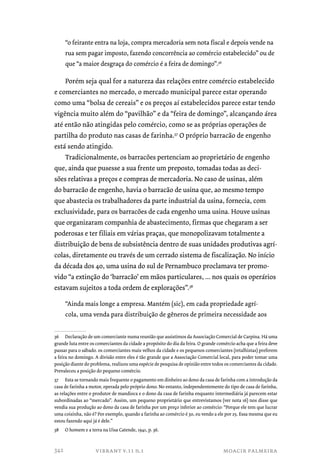

![Com a liquidação do morador e com a generalização do trabalho por
empreitada, o barracão assume feição nova.41 Cada vez menos é um negócio
do proprietário ou de usina. Cada vez mais a regra é o barracão arrendado e
terceiros. O barraqueiro está deixando de ser o “rapaz jeitoso de confiança do
patrão” do “tempo antigo” para ser cada vez mais um “comerciante”, geral-mente
controlando vários barracões, em propriedades de um ou diferentes
donos, morando muitas vezes na rua, onde pode ter ou não outros negócios.
Ele não compra mais onde o patrão quer, mas onde lhe custe menos:
“No barracão vende tudo. Vende, vende farinha, feijão, açúcar, querosene, fós-foro,
sal, arrozina, maisena, leite, sardinha, a batata, bacalhau, charque, peixe
brabo, desse peixe que tem aí no meio da feira que acho que nem os tatus
quer. Porque eles compra a mercadoria mais barata para vender mais caro,
ganhar dinheiro. E tem os que vende tudo. Nos barracões só não vende roupa
nem calçado, essas coisinhas assim. Mas tem uns que ainda vende isso. Agora,
vende caro. (...)” 42
E os preços do barracão, se não são os preços do comércio, são regulados
por esses últimos:
“Hipótese: o preço da farinha agora no comércio, a mais barata que tem é 5 mil,
não é? Até no domingo deu 4 mil, mas o preço atual é 5 mil, a mais barata. Ele –
o barraqueiro – compra daquela mais barata, dos 5 mil, 2 sacos ou 3 sacos ou 4,
o que ele puder, né? – conforme o barracão, conforme o consumo do barracão,
né? Mas que ele vai mudar no preço do mercado. Se no mercado estiver farinha
boa no mercado por 10 mil, ele vende por 10 mil.” 43
Mas não é apenas a especulação do barraqueiro com produtos do comér-cio
que vai ser regulada pelos preços de mercado. Também as suas transações
com “moradores” que lhe fornecem produtos como a farinha de mandioca
serão regidas por aqueles preços:
“Eles [os barraqueiros] compra aquela farinha da boa, matéria prima – pelo
preço da mais barata no comércio – e vendo ao preço do comércio, que está lá
41 O empreiteiro, entretanto, vai transformar a venda na cidade em uma espécie de barracão. Seus trabalhadores
compram fiado na venda e são descontados no fim de semana.
42 A., morados, citado.
43 J.A., citado.
vibrant v.11 n.1 moacir palmeira
344](https://image.slidesharecdn.com/v11n1-140831205434-phpapp02/85/Vibrant-Ethnographies-of-economy-ics-344-320.jpg)
![custando no mercado, no correr da semana. É assim: se ela estiver custando 10
mil no mercado, eles aumentam aqueles 10 mil.” 44
Isso, entretanto, não impede os trabalhadores rurais e sitiantes de conti-nuarem
vendo o “comércio” em geral como uma alternativa ao barracão:
“[Comprar] No barracão? Eu tenho o maior medo do barracão, tá vendo a
senhora? Eu já não acabei mais a família por causa que Deus é muito bom.
E viva Deus e os homens, os homens que negoceia. Por aí mesmo dentro de
Palmares tem aí um cidadão que possui a barraca que ele não é meu patrão, ele
é meu pai. (...)” 45
Conclusão
Há mais ou menos 10 anos atrás um historiador pernambucano dizia,
sem medo de errar, a propósito das vilas e cidades das partes mais úmidas do
Agreste:
“Estas vilas, como as cidades agrestinas próximas aos brejos, tem grandes
feiras, uma vez que a menor concentração fundiária permite maior divisão
do dinheiro: diminui o número de ricos e pobres e aumenta o de intermedia-dos.
Por isto feiras como as de Camocim de São Felix, Cupira, Cachoeirinha
e Capoeiras, apesar da pequena população do aglomerado, são muito mais
importantes do que as cidades grandes da Zona da Mata, como Goiana, Nazaré
ou Palmares.”46
O estudo das feiras da Zona da Mata sugere que as coisas não são mais
assim e que a feira e o mercado estão presentes hoje até nas transações de
que elas são a própria negação, de que o melhor exemplo é a prática comer-cial
do barraqueiro. E o crescimento da feira na zona canavieira parece
projetar-se mais longe ainda e inverter as próprias relações entre feiras do
Agreste e da Mata.
“Destas feiras daqui de perto, Palmares é a melhor. No Agreste a feira é
44 Idem.
45 T.D., citada.
46 Manuel CORREA DE ANDRADE, A terra e o homem no nordeste. Brasiliense, São Paulo, 1964 (2ª ed.), p. 159.
moacir palmeira vibrant v.11 n.1
345](https://image.slidesharecdn.com/v11n1-140831205434-phpapp02/85/Vibrant-Ethnographies-of-economy-ics-345-320.jpg)
![fraquinha.” 47 “E não é só em Palmares, é em todos esses lugarezinhos peque-nos,
como Batateira, que tem havido crescimento.” 48
Os produtores de Curupira, São Félix, Cachoeirinha, estão trazendo
os seus produtos para a Mata e muitas daquelas feiras estão consumindo
“sobras” de Palmares ou estão sendo transformadas em “feira de mulher”.49
Esse crescimento das feiras não é linear. Feirantes e consumidores men-cionam
sempre um passado próximo em que “as coisas eram melhores”,
“quando o trabalhador tinha dinheiro na mão para comprar”, ou um passado
de ouro quando “se jogava fora as mercadorias porque a fartura era muito
grande.” Nem o crescimento da feira parece representar qualquer aumento
do poder aquisitivo dos trabalhadores rurais e dos sitiantes. Ao contrário, seu
crescimento parece acompanhar muito de perto as vicissitudes da própria
história da área.
Agosto de 1971
vibrant v.11 n.1 moacir palmeira
Bibliografia
CIA. TELEFÔNICA DE PALMARES. 1965. “Palmares: dados históricos,
geográficos e econômicos.” Lista Telefônica Oficial. Palmares.
CORREA DE ANDRADE, Manuel. 1964. A Terra e o Homem no Nordeste. São
Paulo: Brasiliense. (2nd ed.).
GENESTOUX, Patrick Calema du. 1967. Le Nord-est du Sucre. Thèse de troisième
cycle présentée à la Faculté de Droit et Sciences Economiques de Paris,
Paris.
GONÇALVES, Fernando Antonio. 1966. Condições de Vida do Trabalhador Rural
da Zona da Mata de Pernambuco – 1964. Recife: Instituto Joaquim Nabuco.
VI [sexto] recenseamento geral do Brasil, 1950. Estado de Pernambuco: Censos
Econômicos.
IBGE. 1955. Estado de Pernambuco: Censos Econômicos – 1950. (Serie Regional,
Vol. XVII, Tomo 2). IBGE: Rio de Janeiro.
IBGE. 1969. Censo Agrícola 1960: Pernambuco. (Vol. 2, pt. 2). IBGE: Rio de Janeiro.
LEITE LOPES, José Sergio. 2013. “Entrevista com Moacir Palmeira.” Horizontes
47 Grupo de feirantes produtores do Agreste vendendo farinha.
48 S., citado.
49 Alguns feirantes dos “agrestes” afirmaram só feirar em Palmares, deixando o encargo de vender nas suas
localidades às mulheres.
346](https://image.slidesharecdn.com/v11n1-140831205434-phpapp02/85/Vibrant-Ethnographies-of-economy-ics-346-320.jpg)






